Chapter 17 From Gene to Protein. Overview: The
















































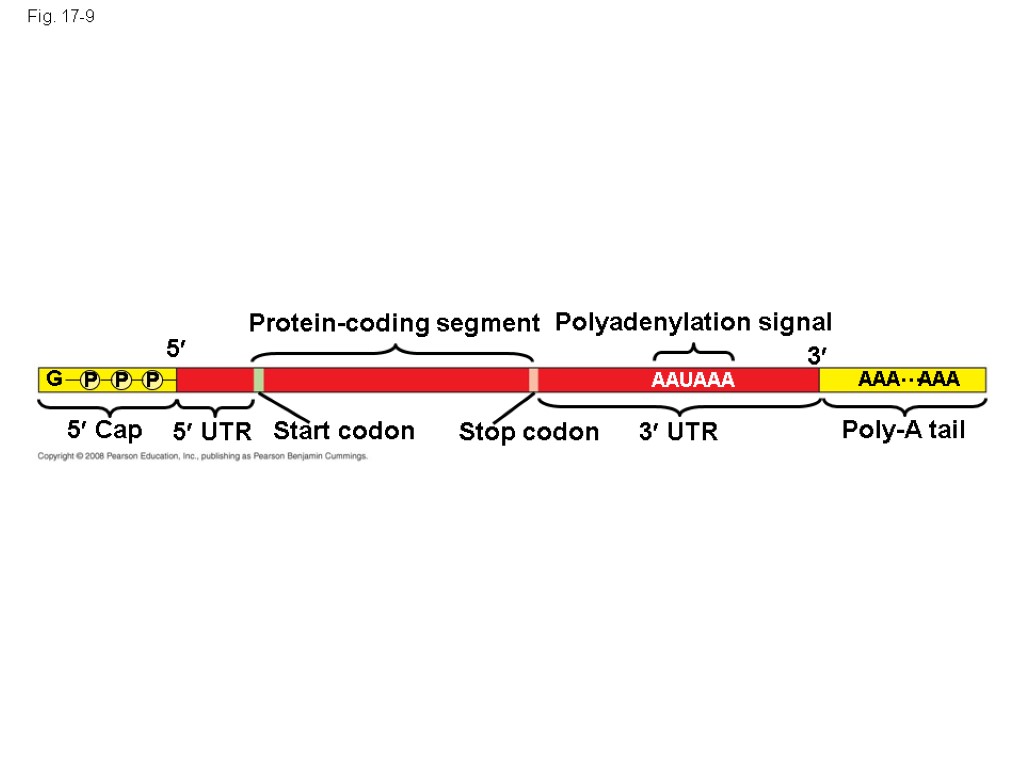

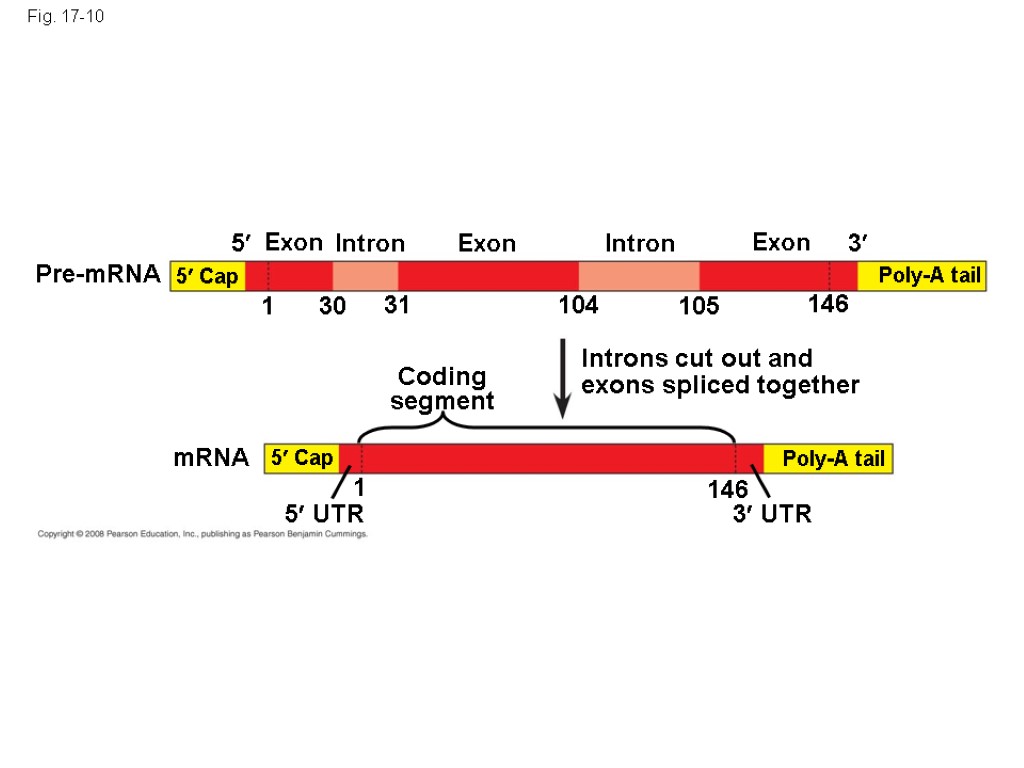
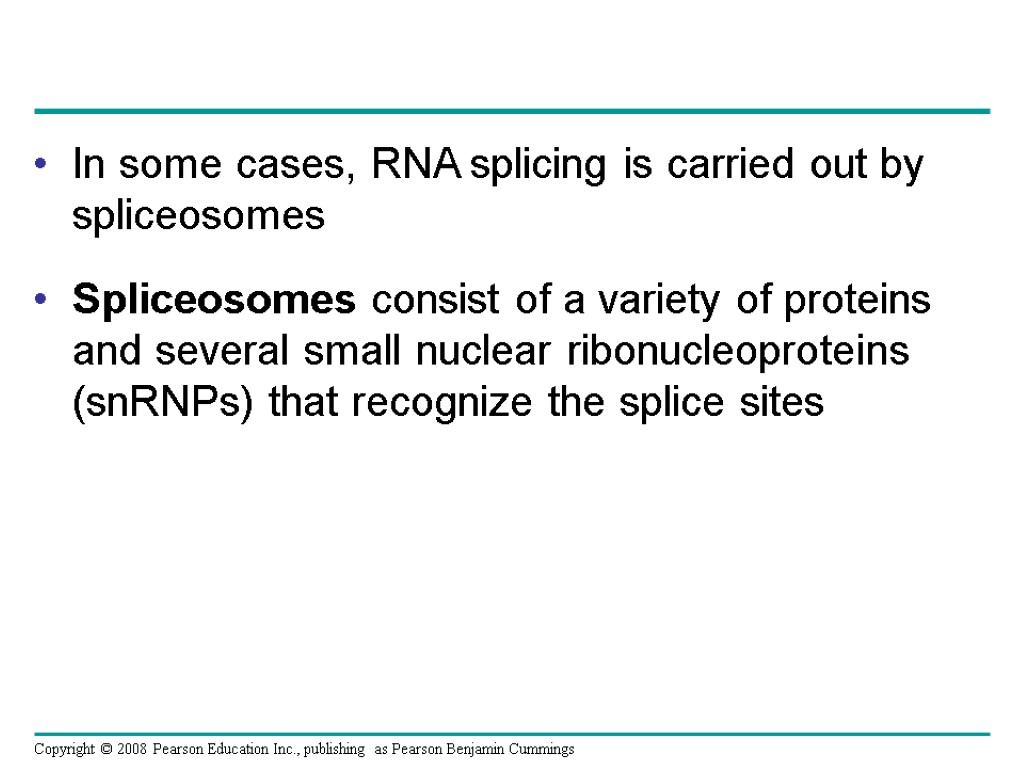

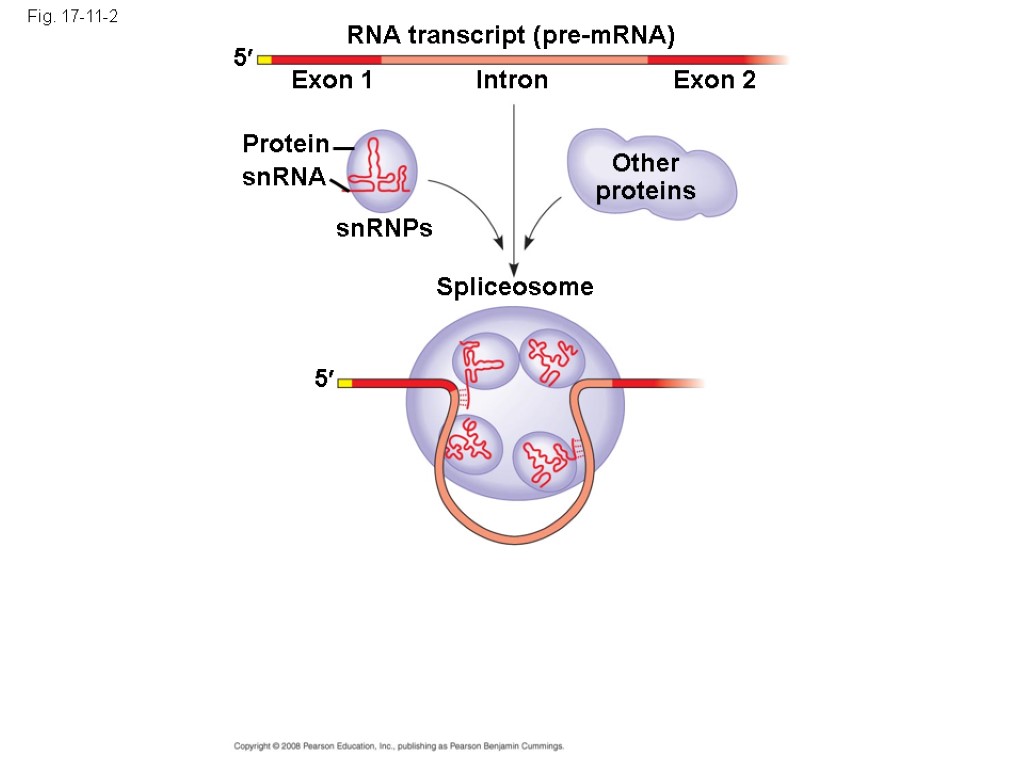
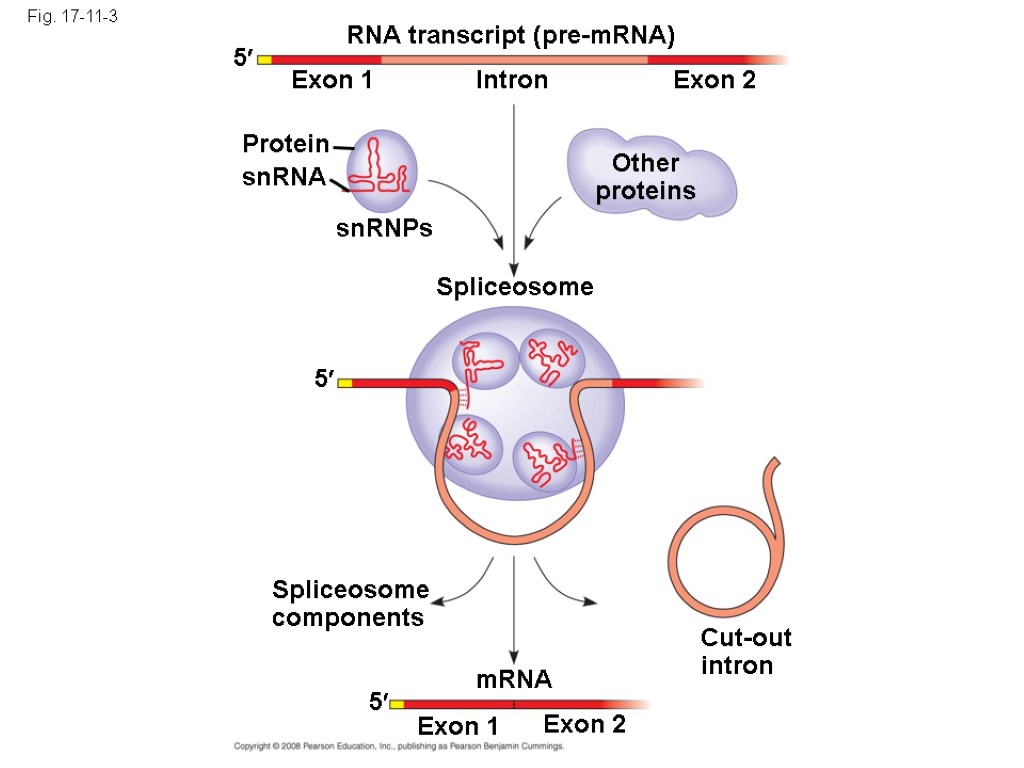
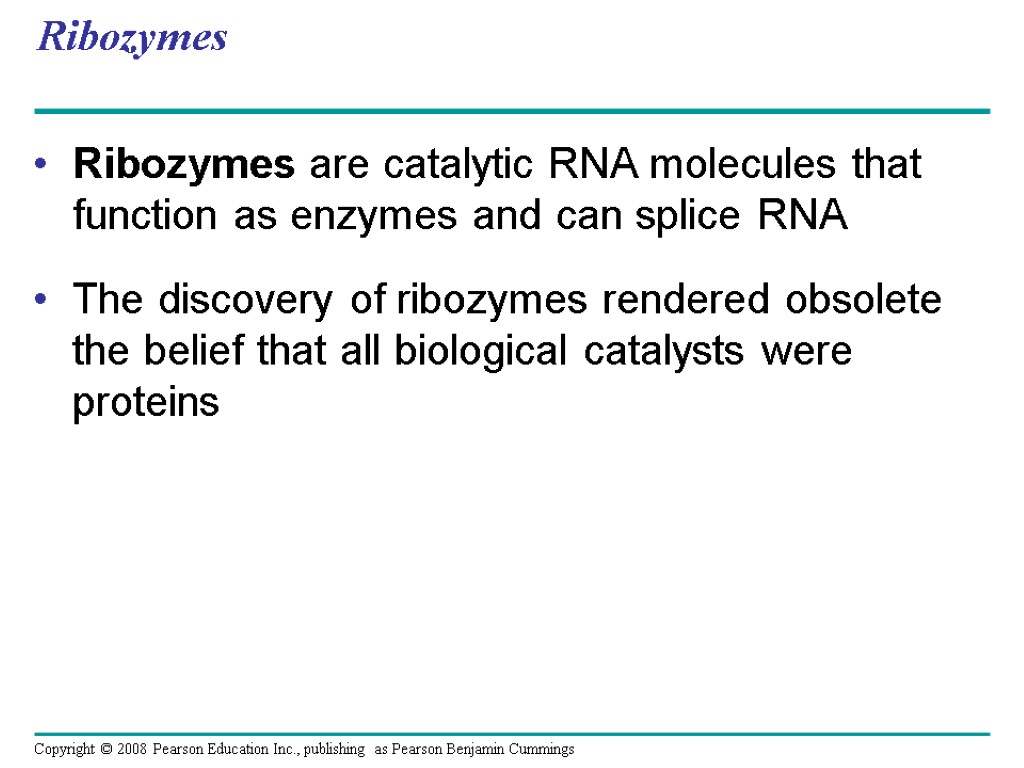
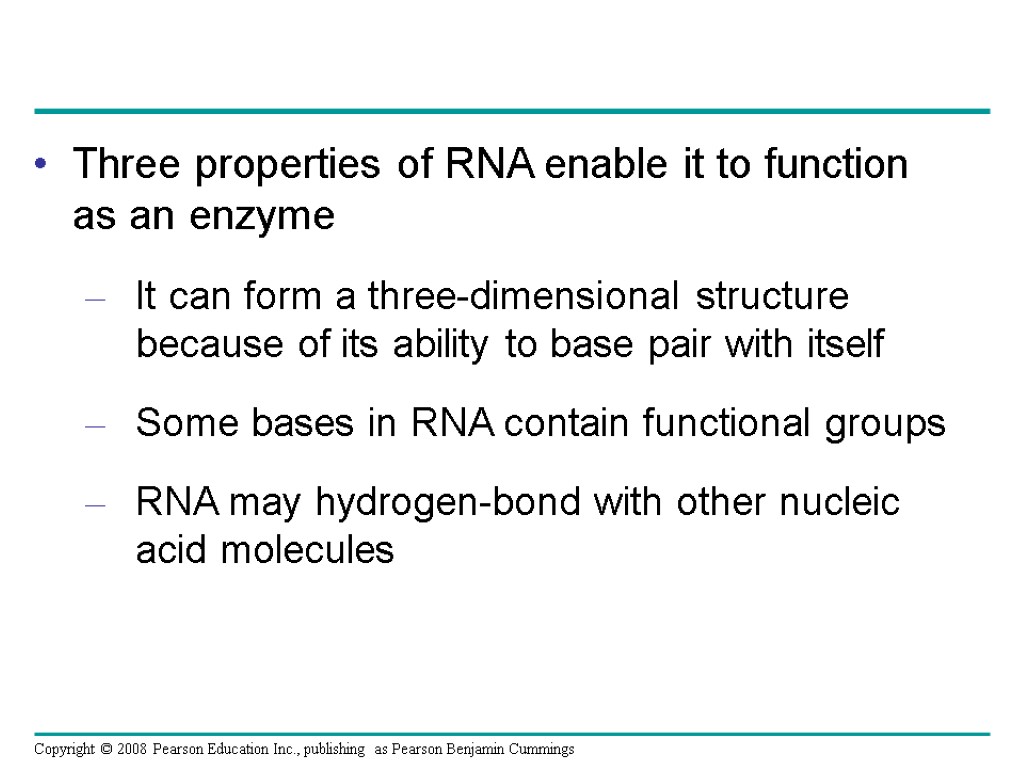
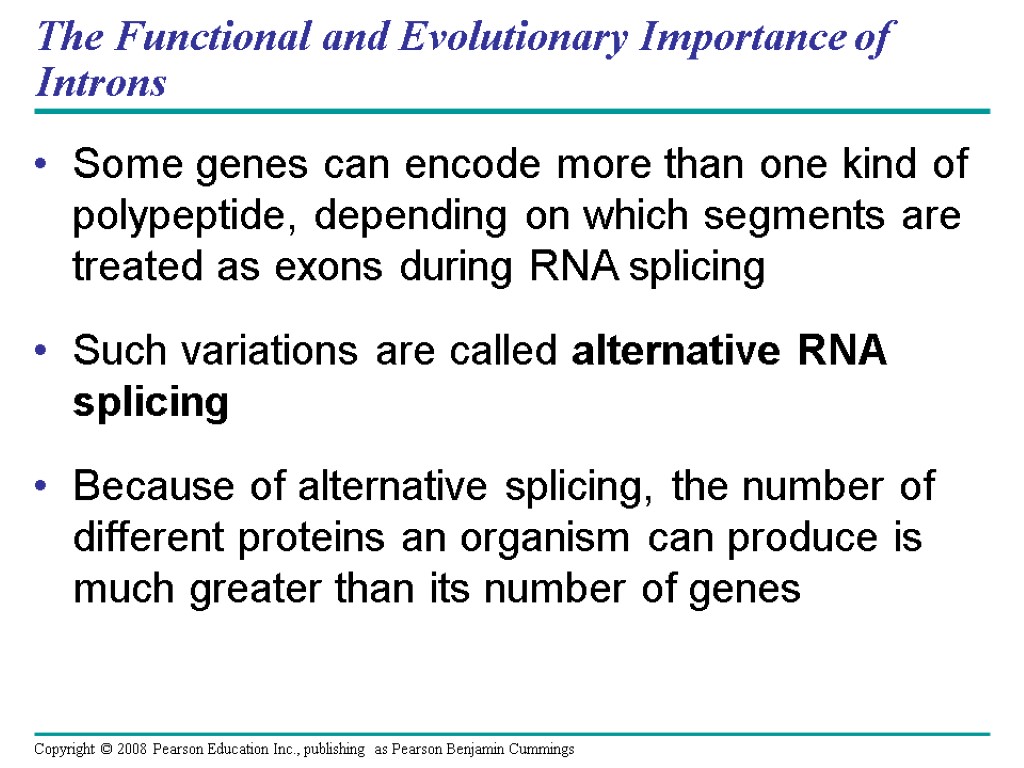

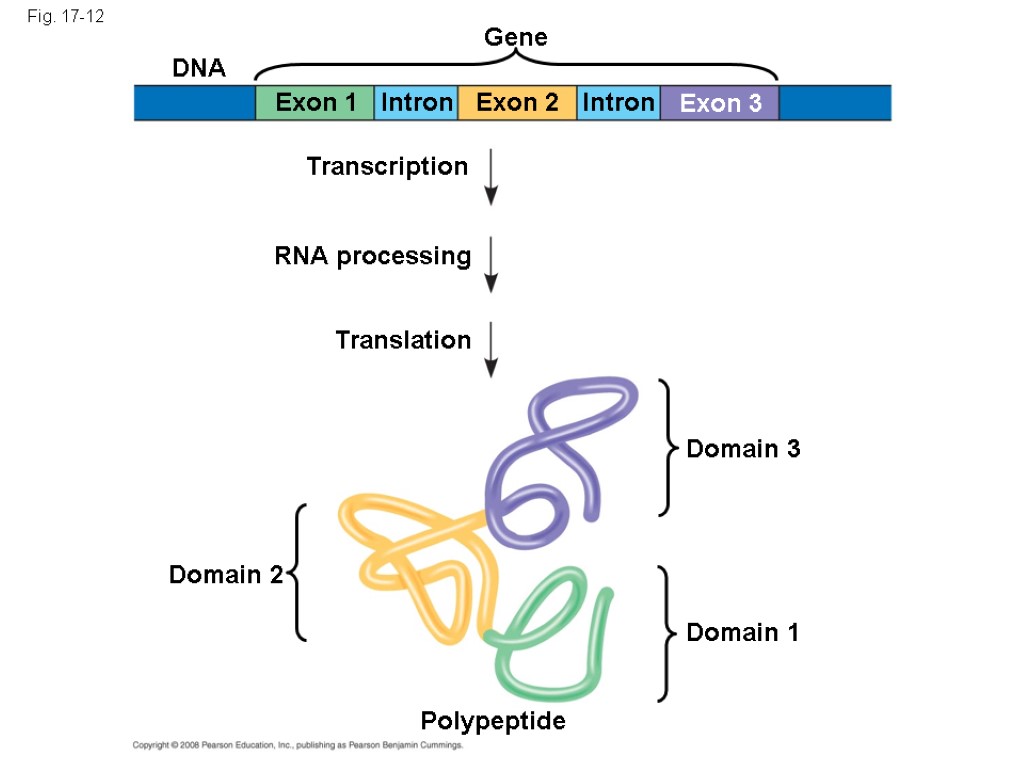
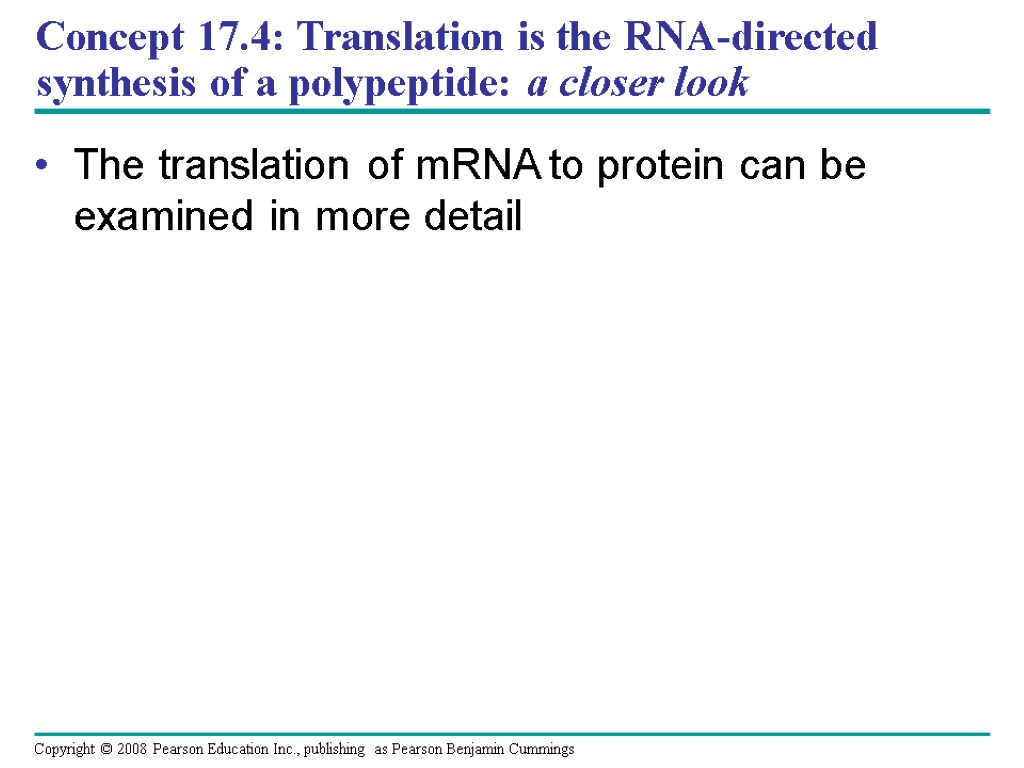
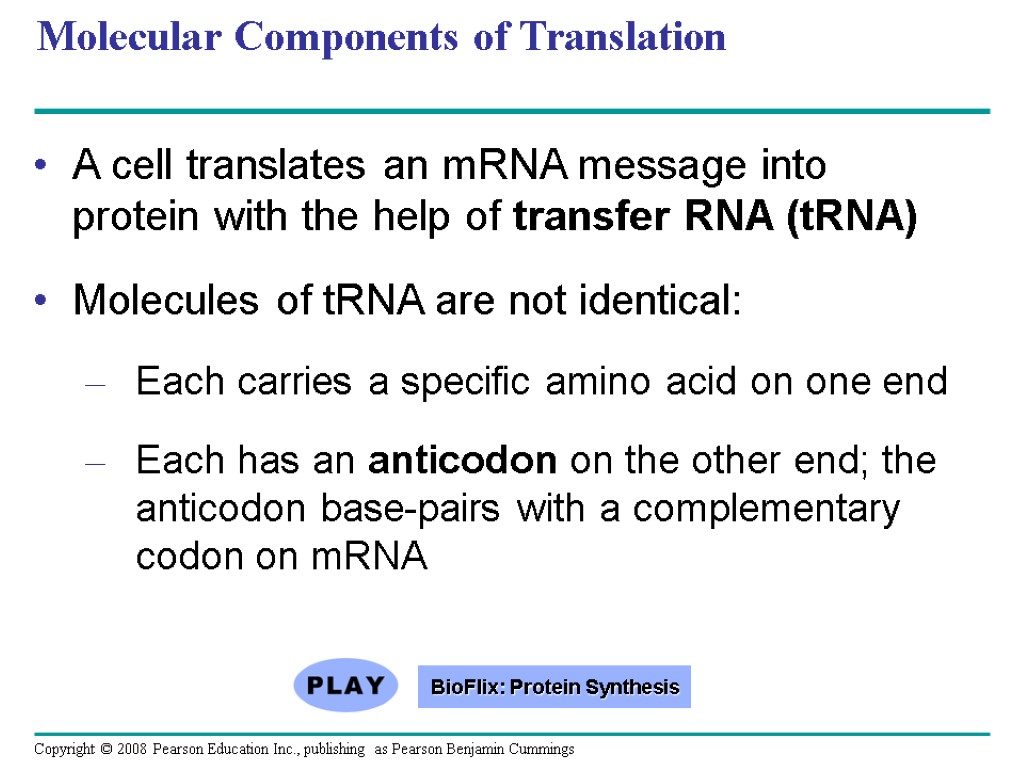
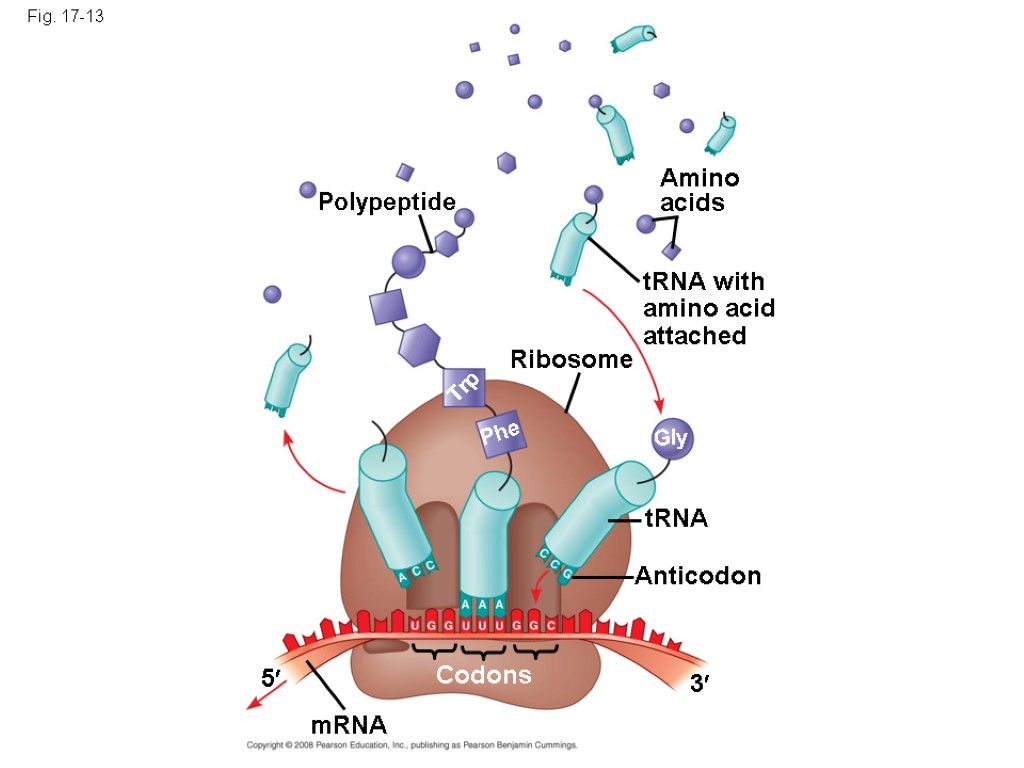
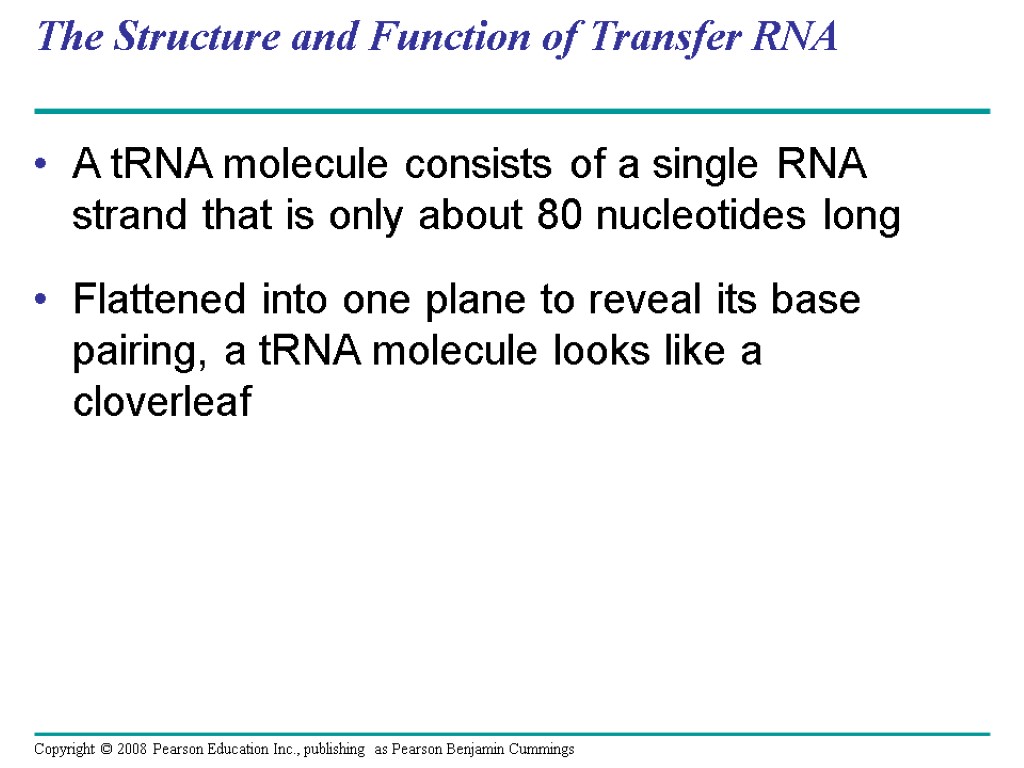
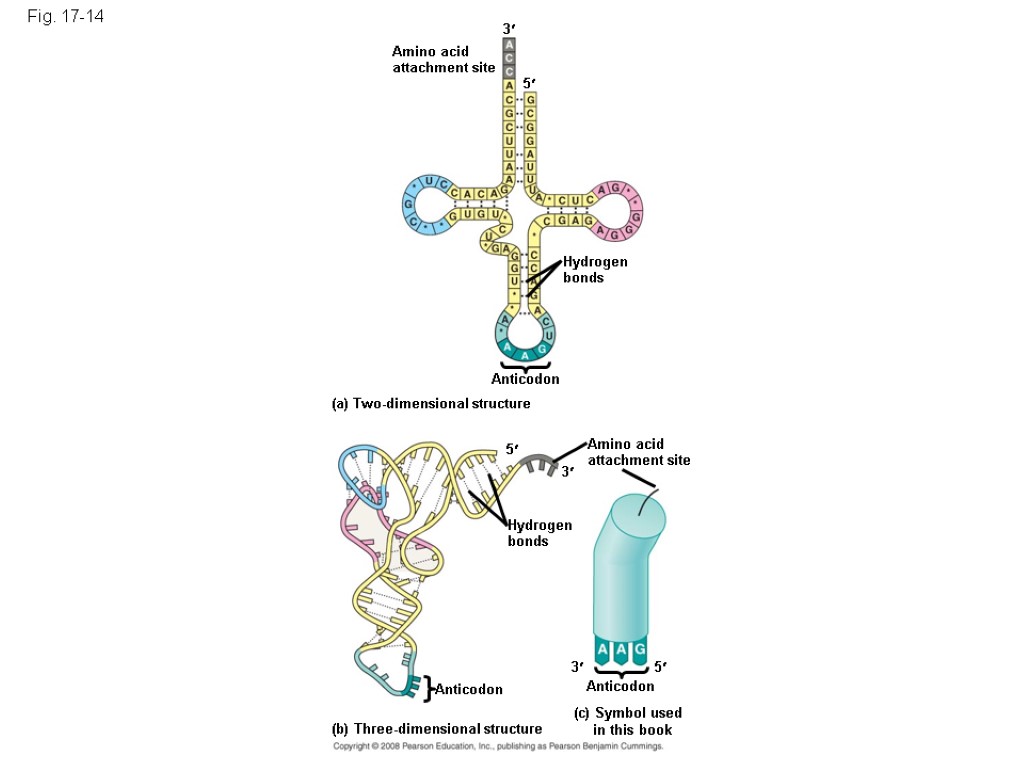
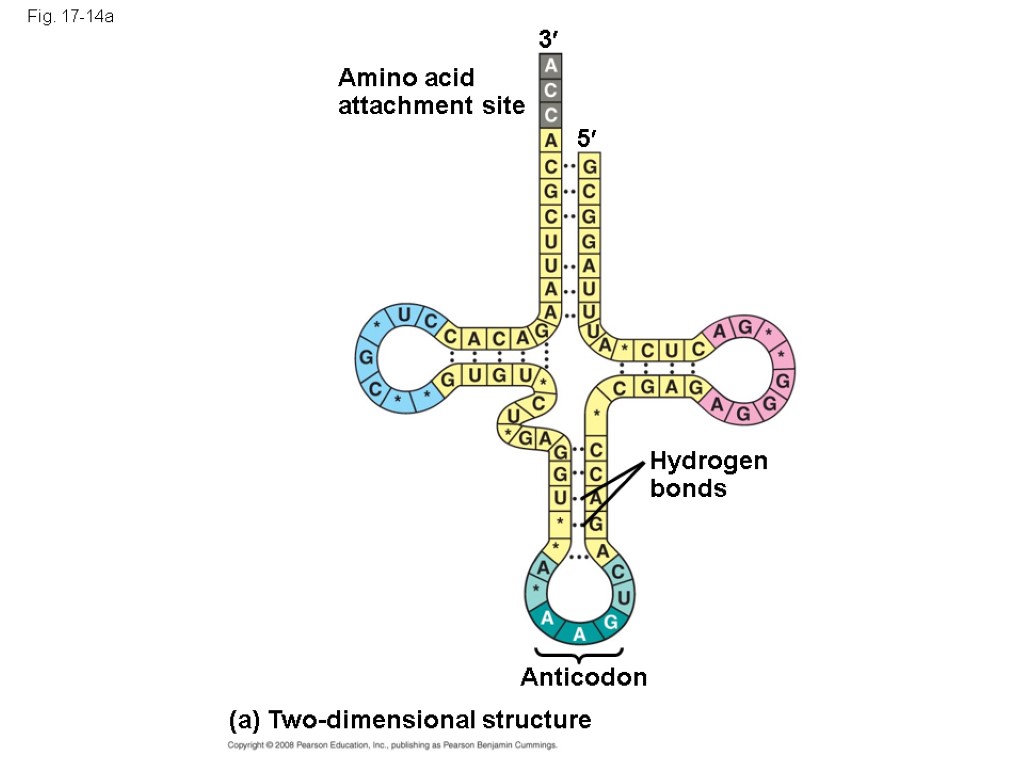
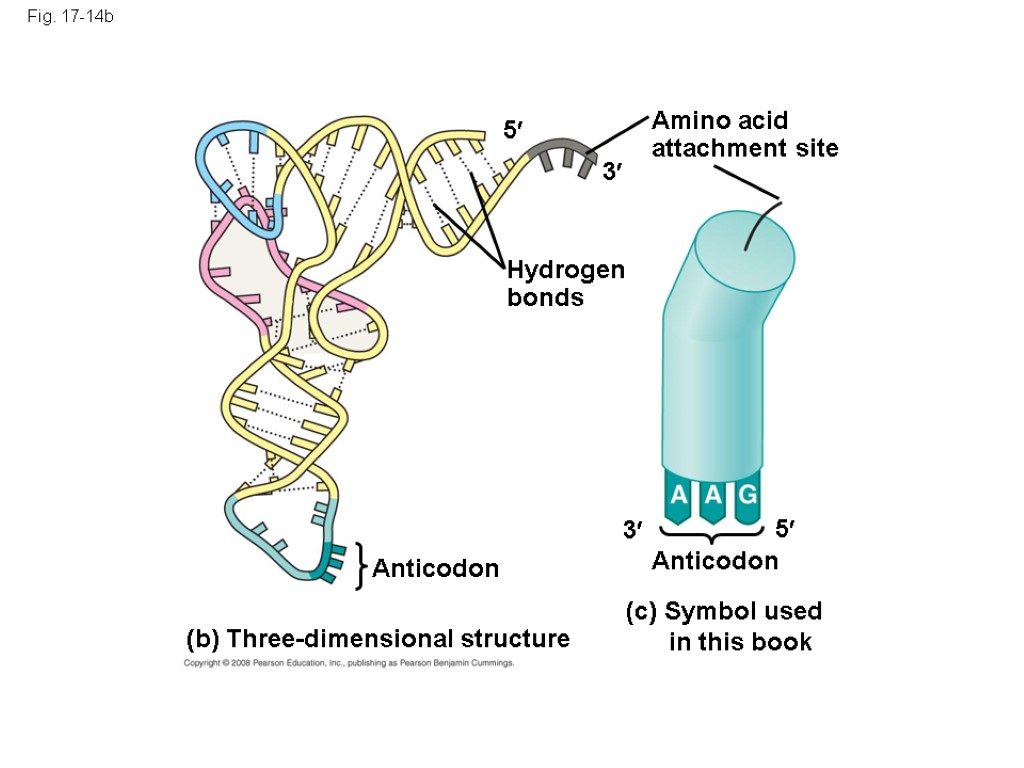

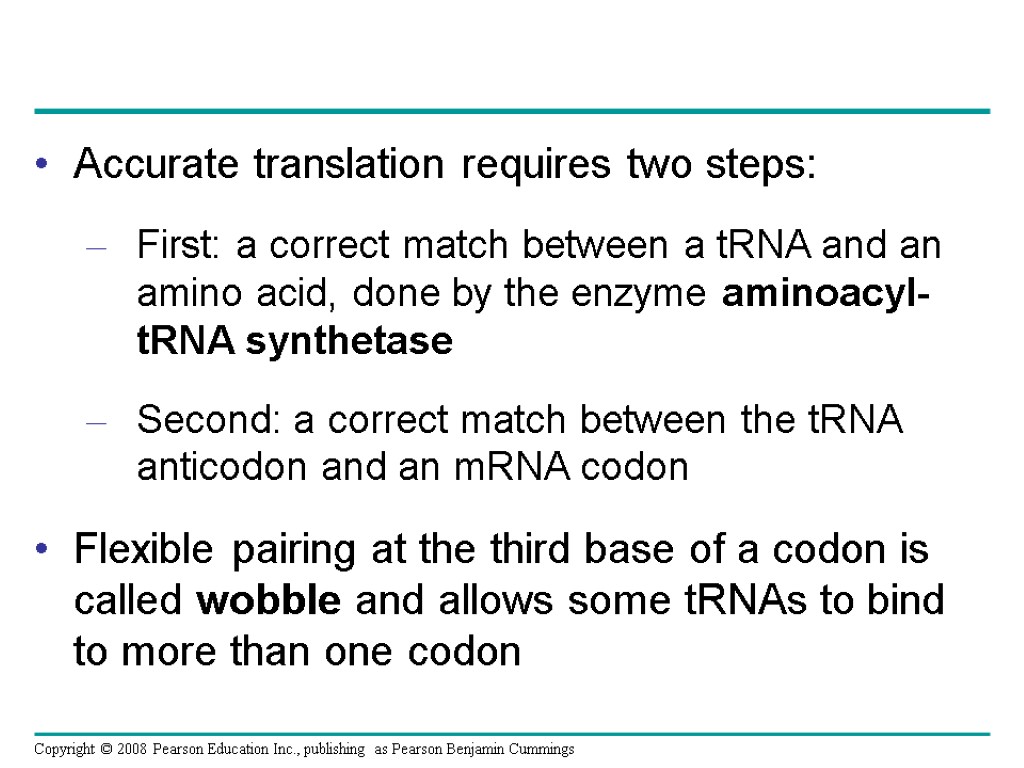
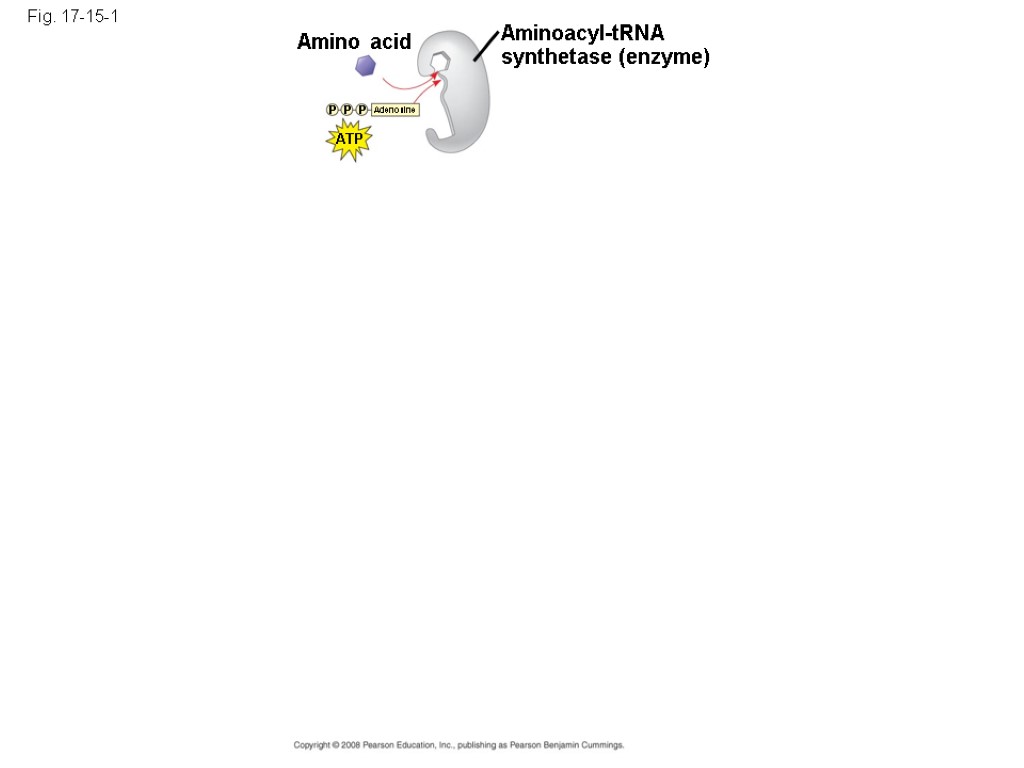
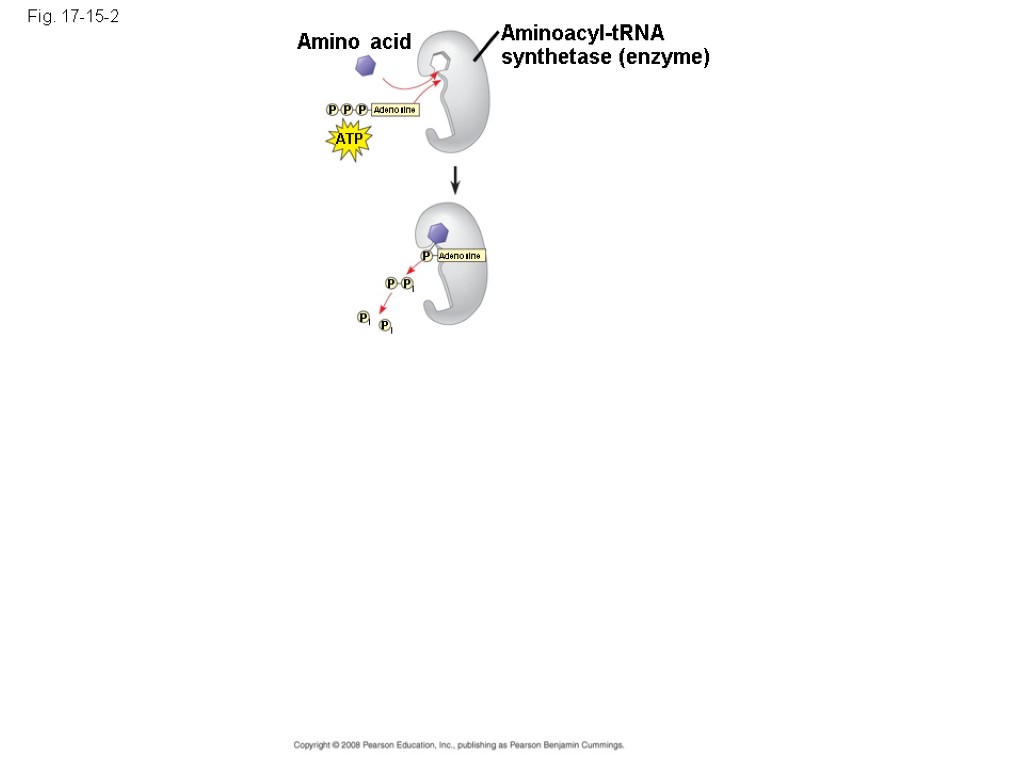
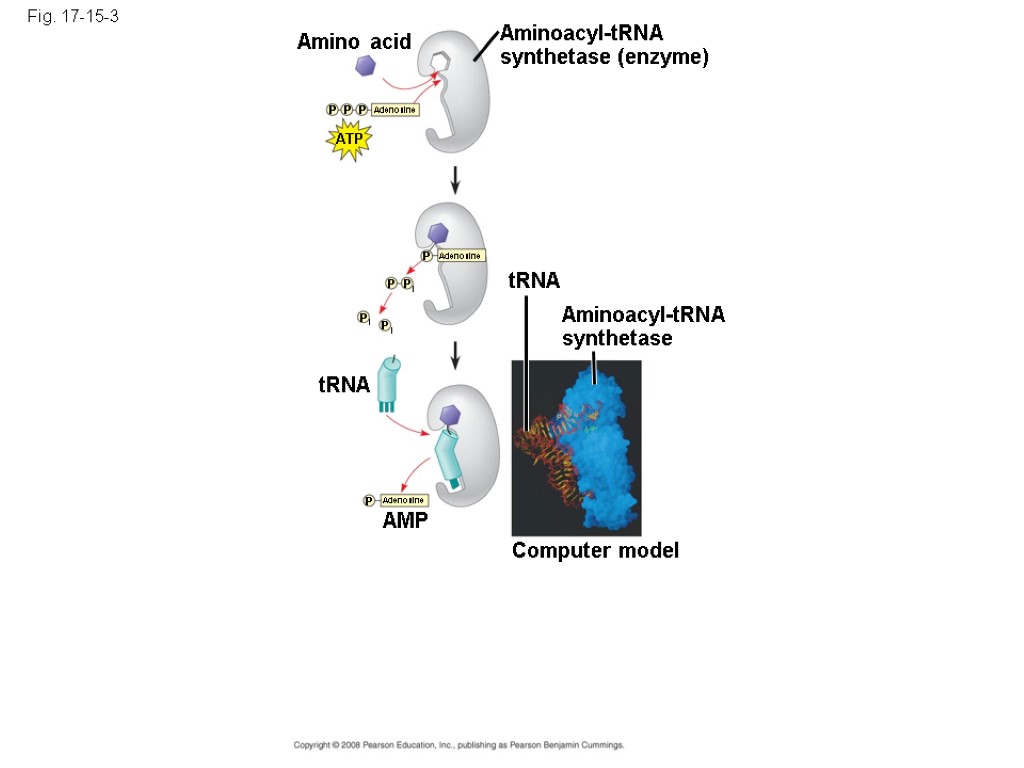
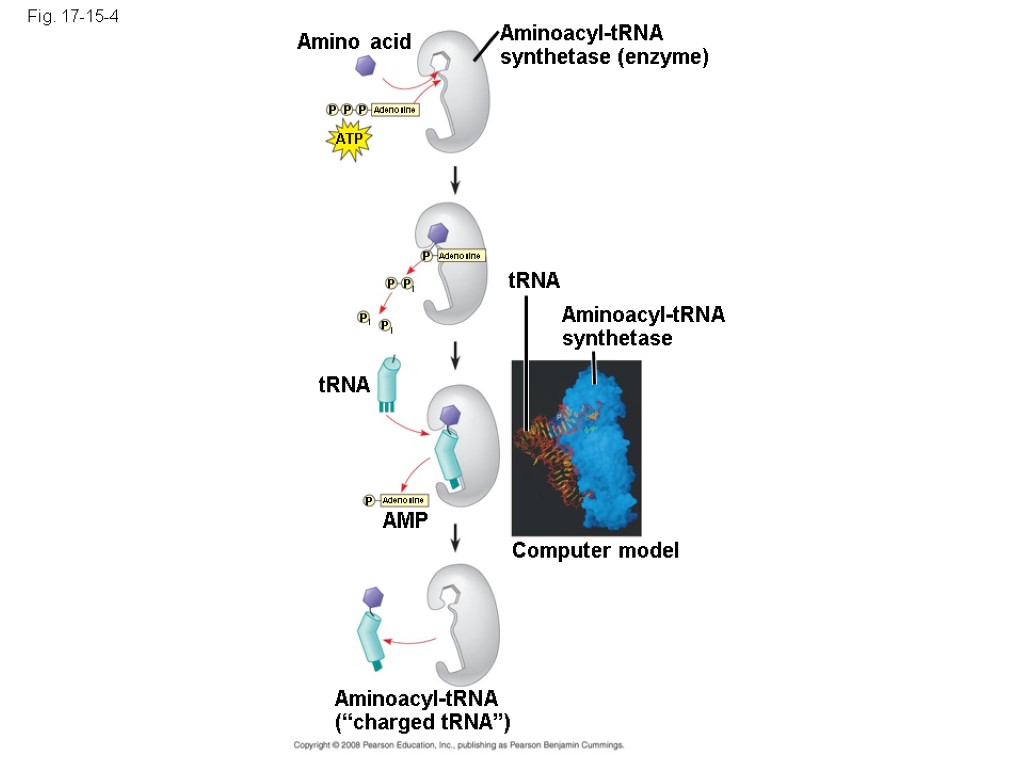
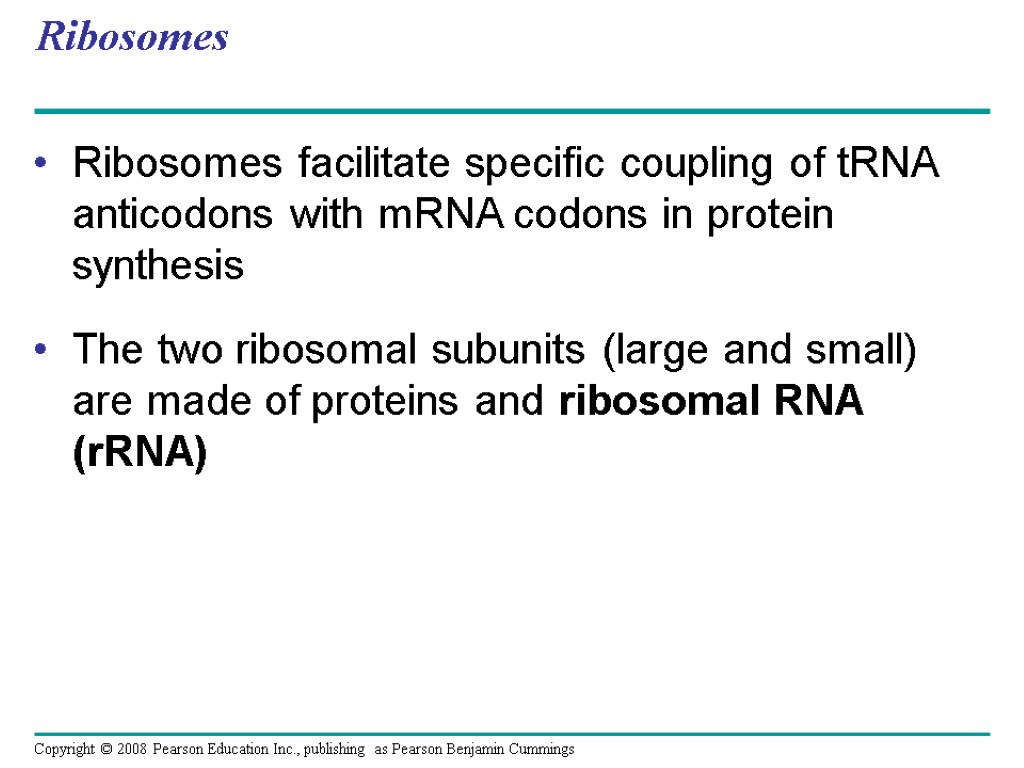

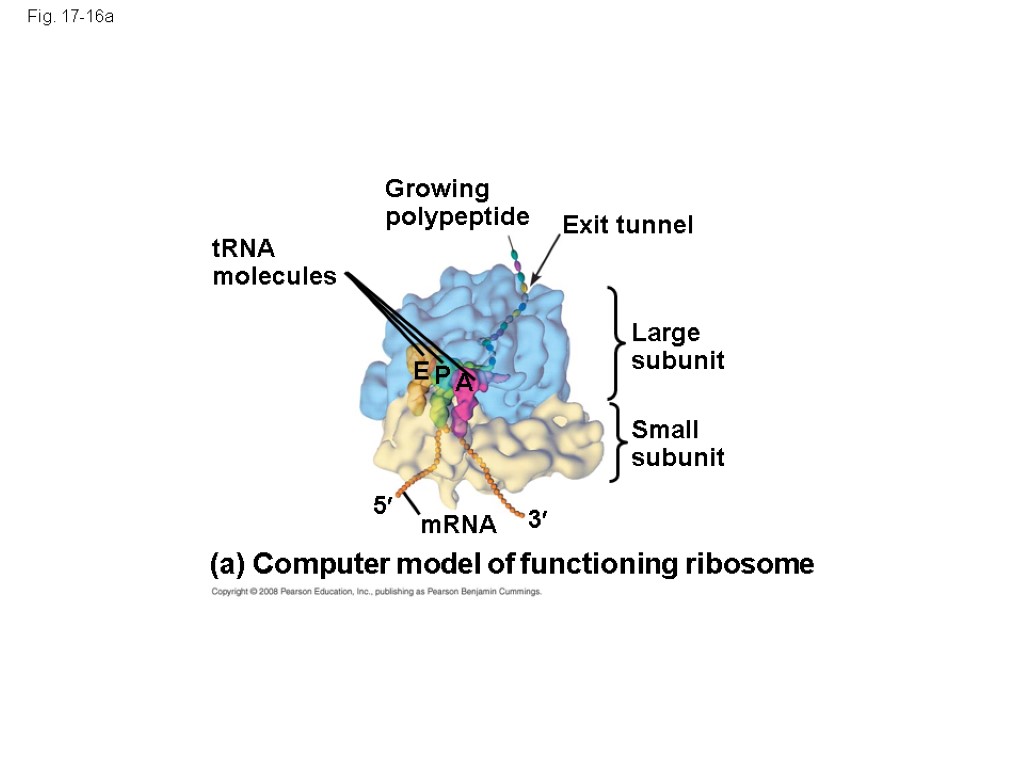
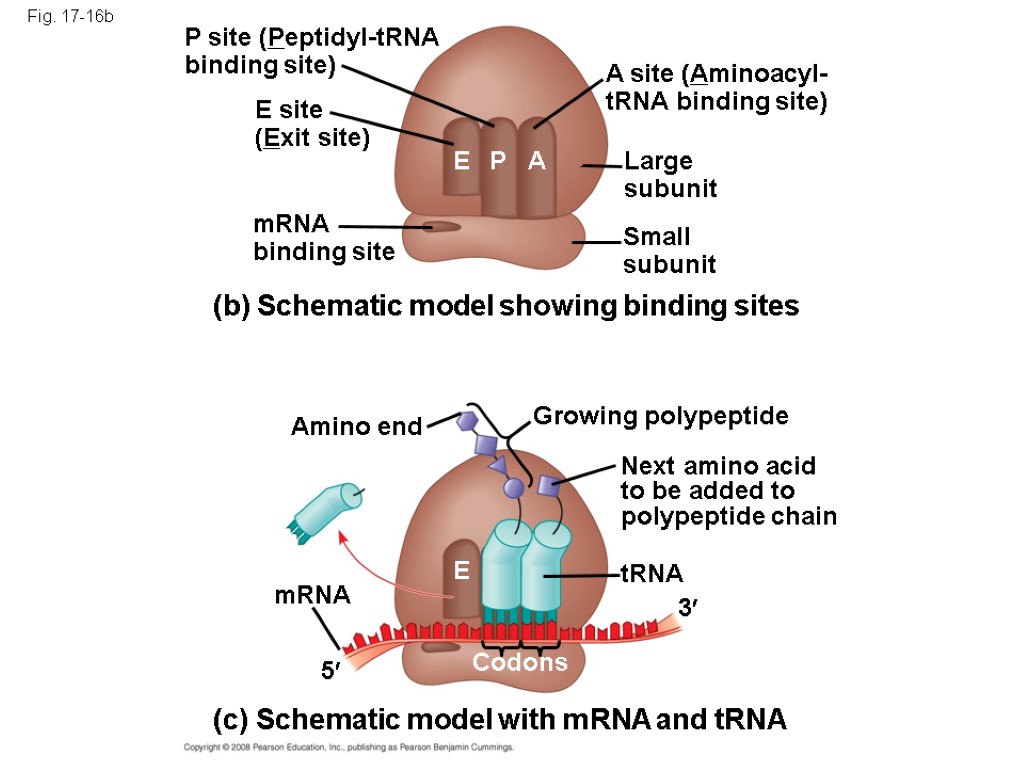


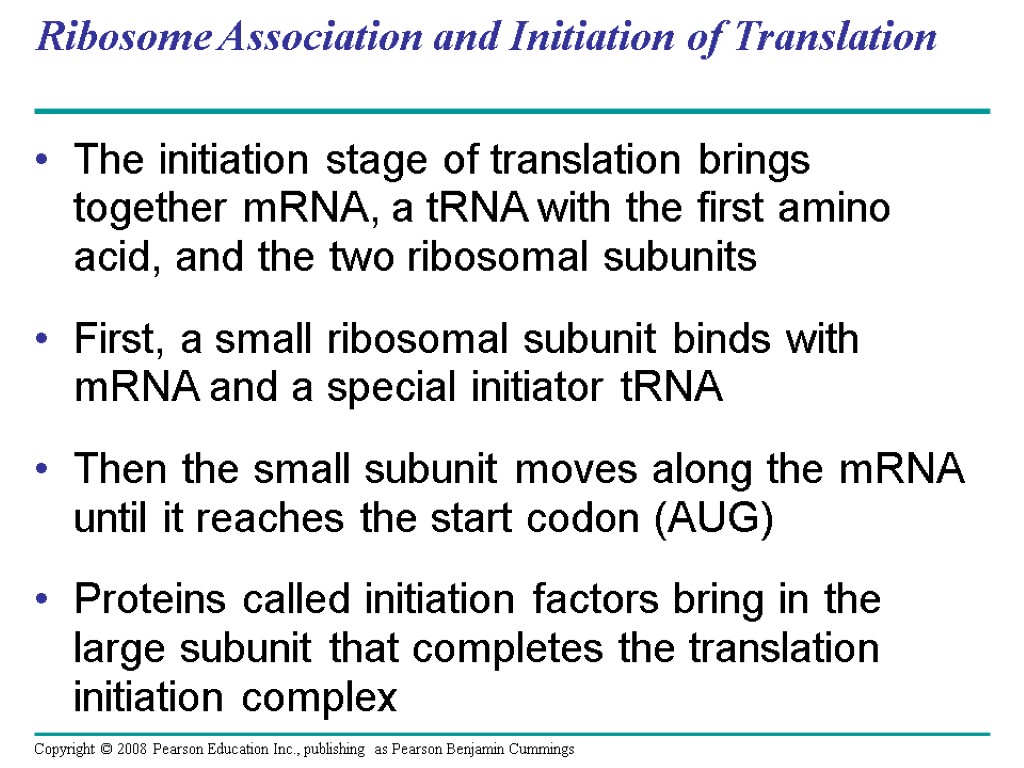
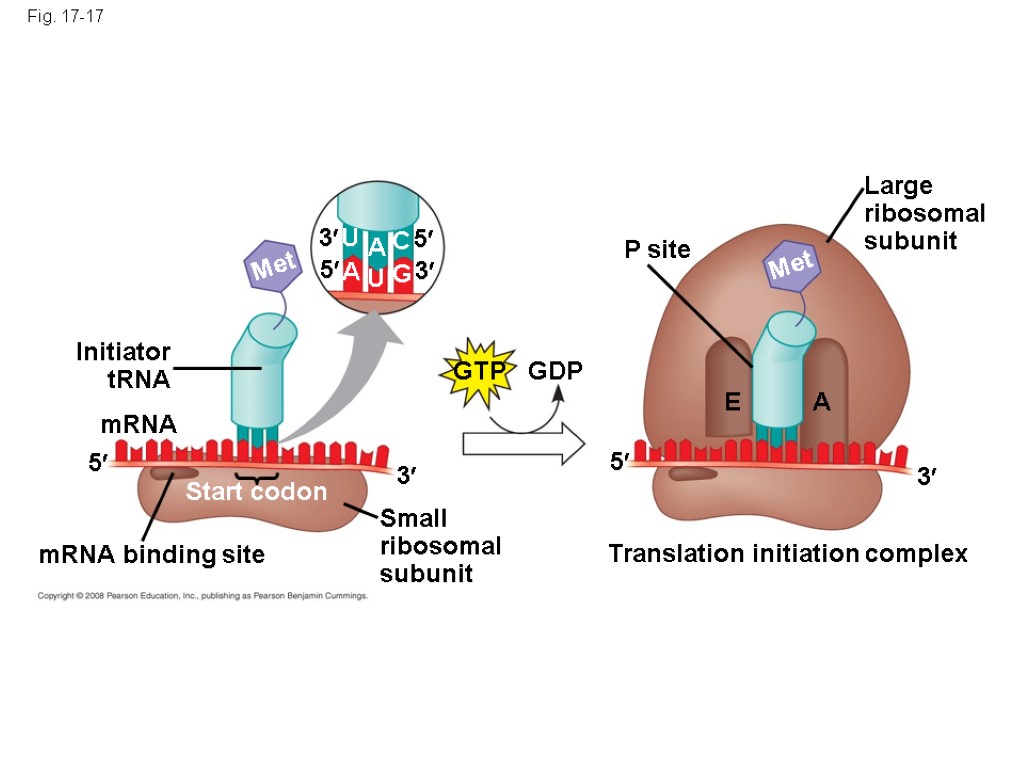
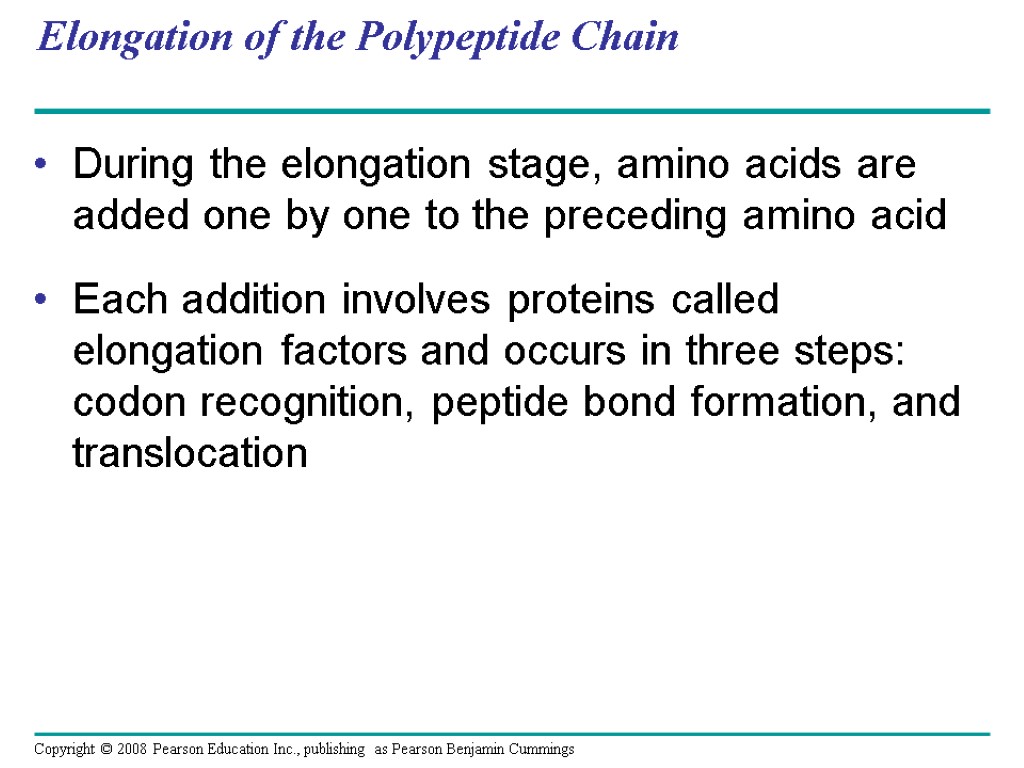


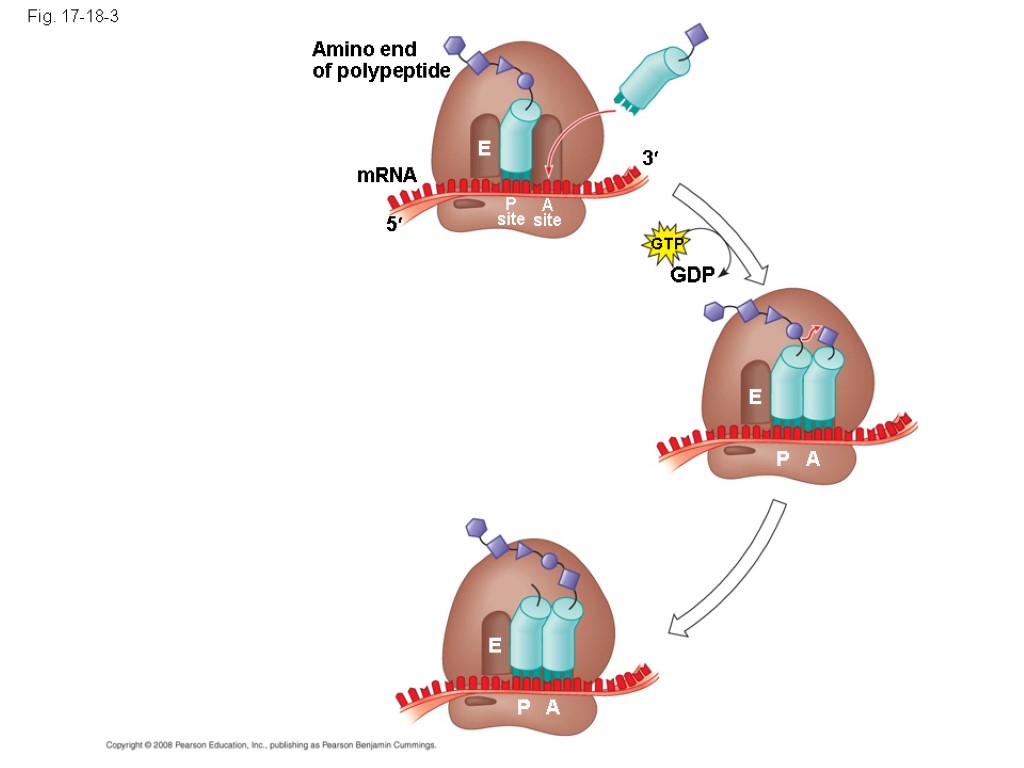
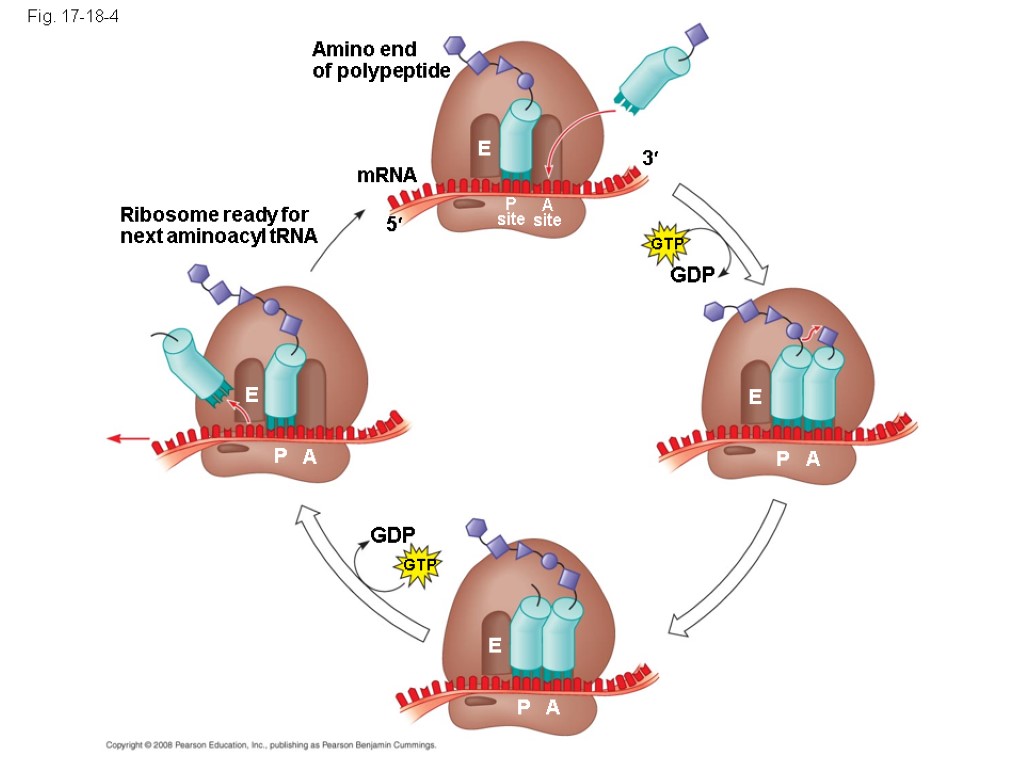
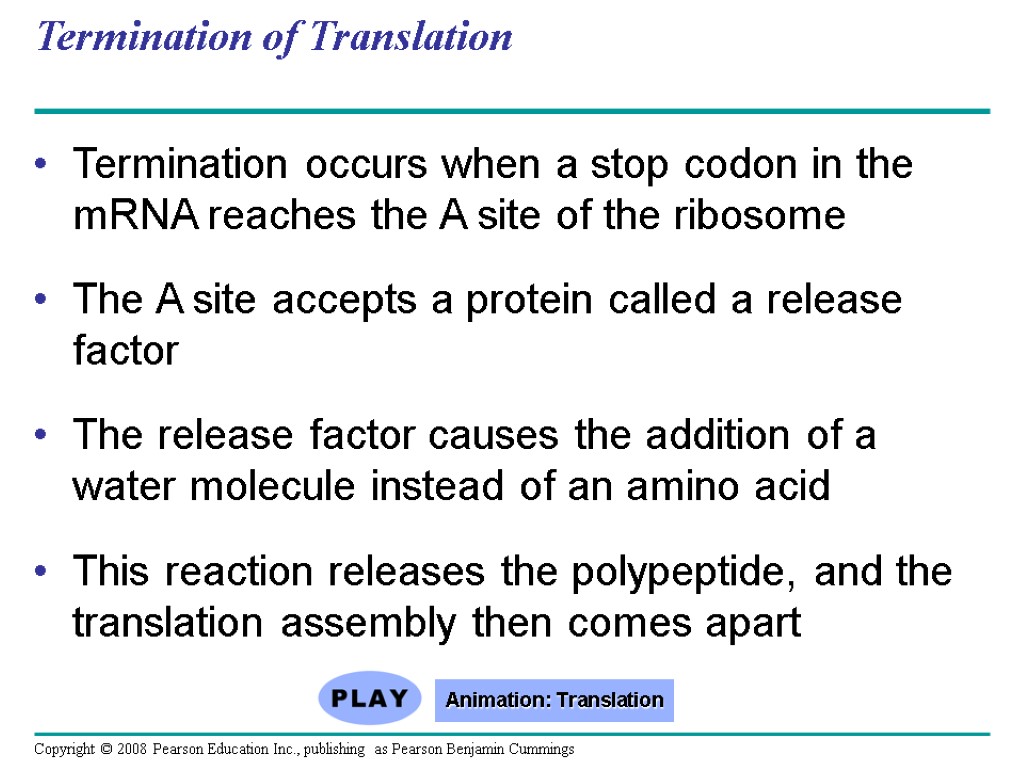
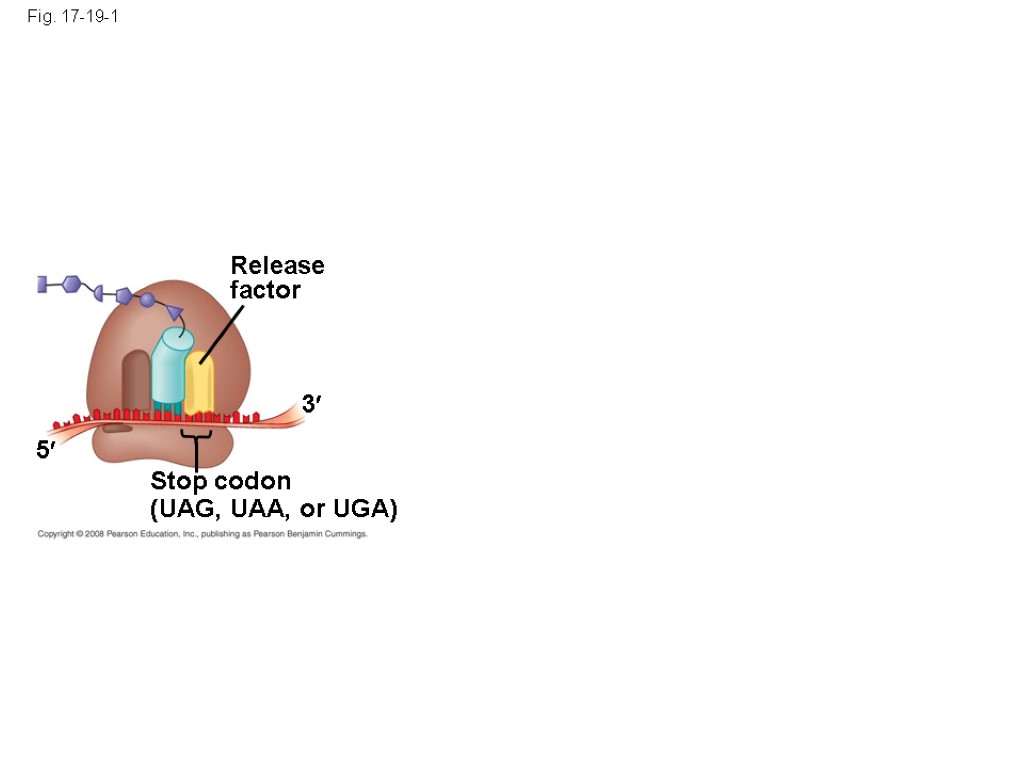
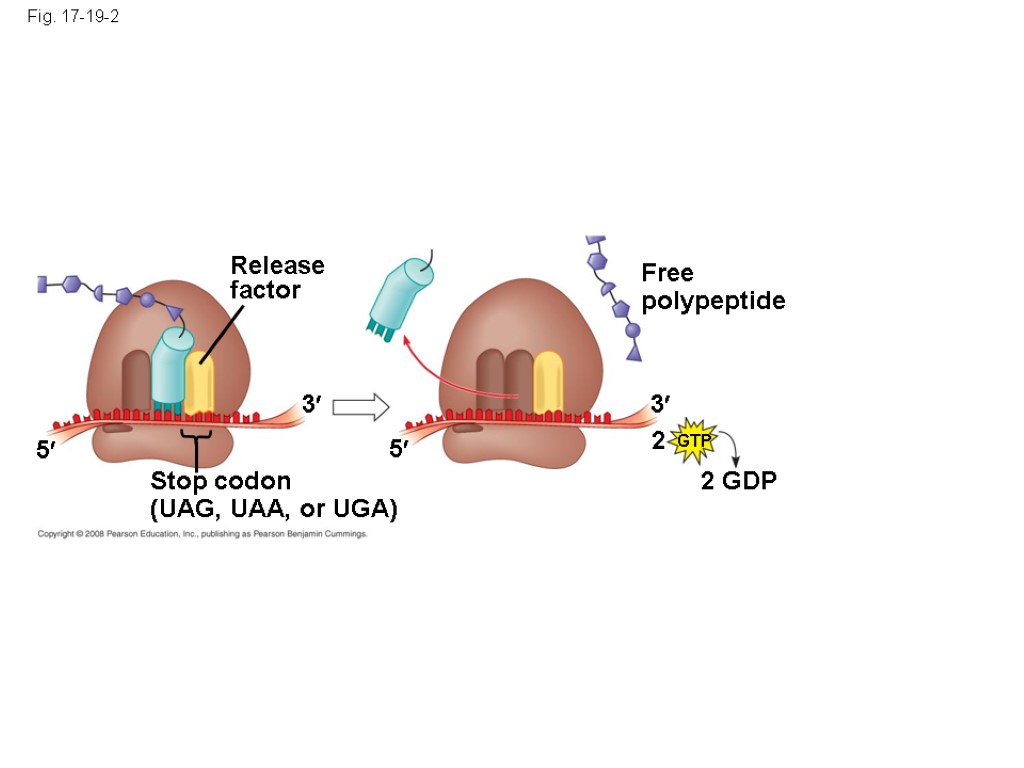
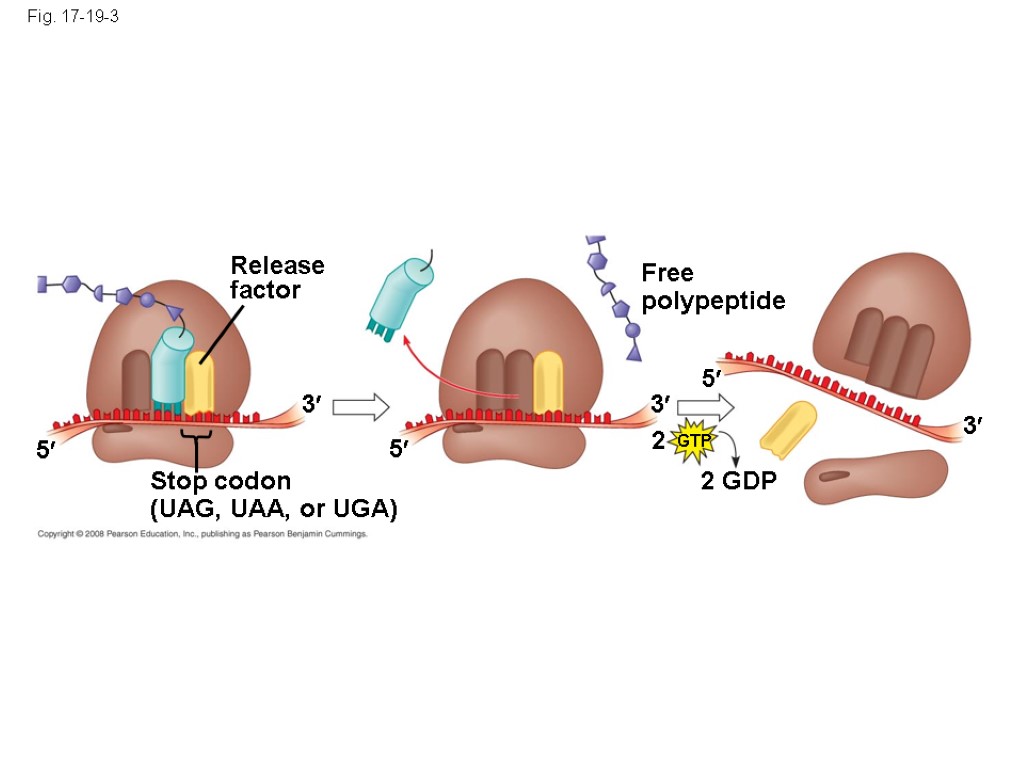
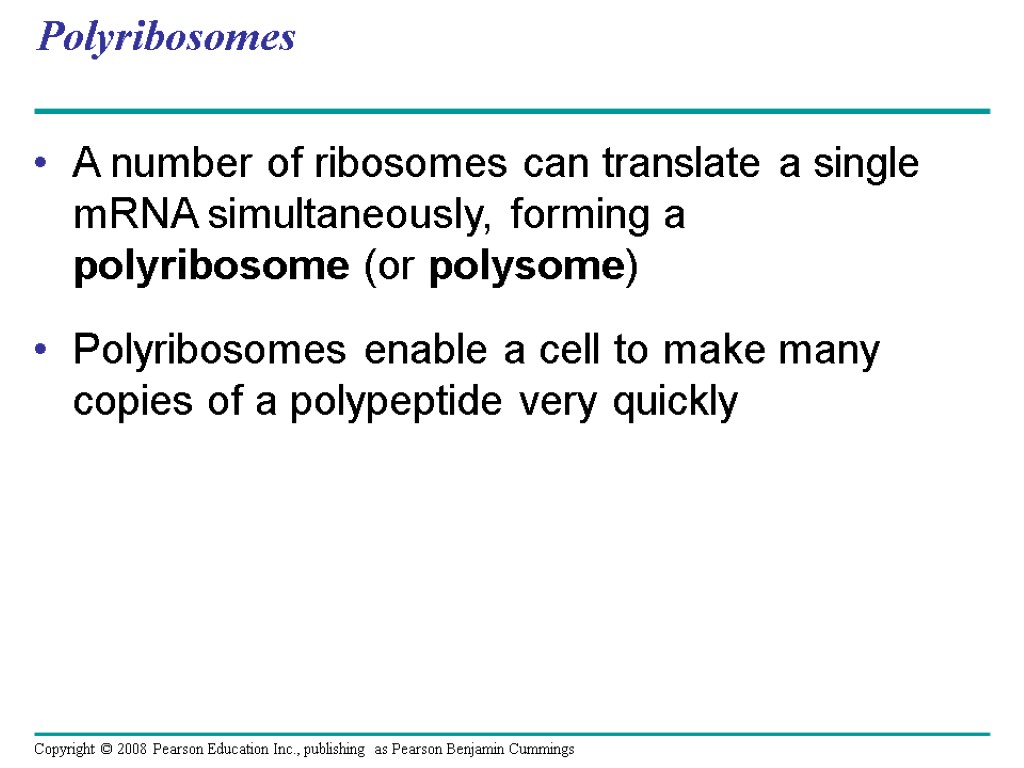
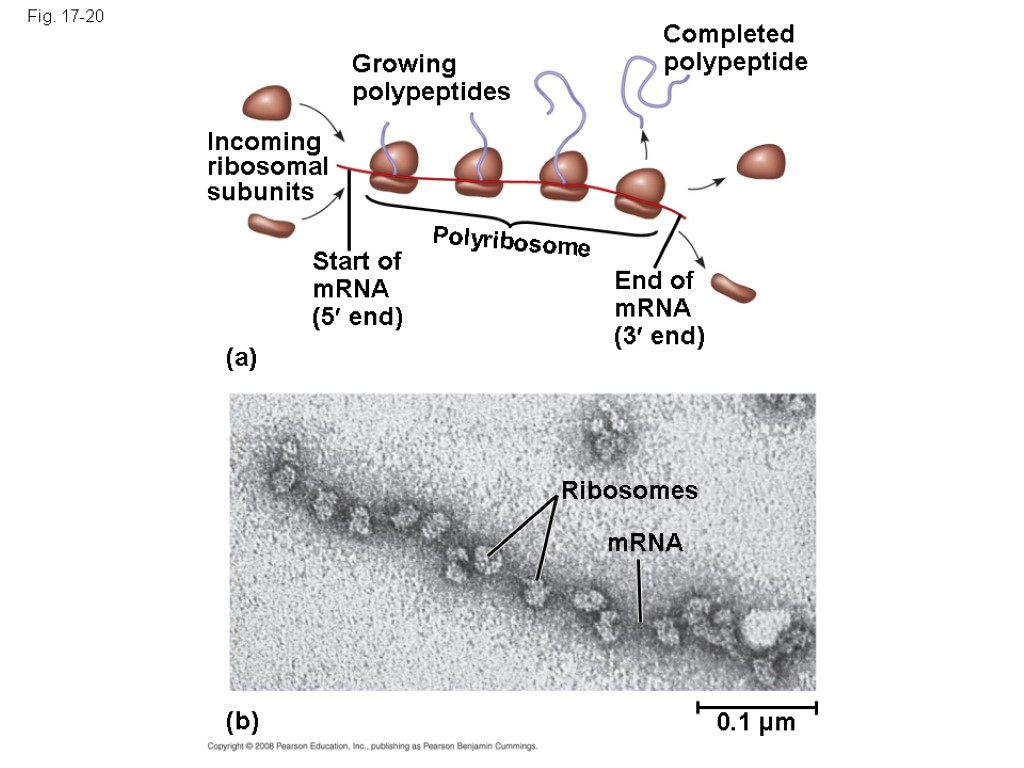
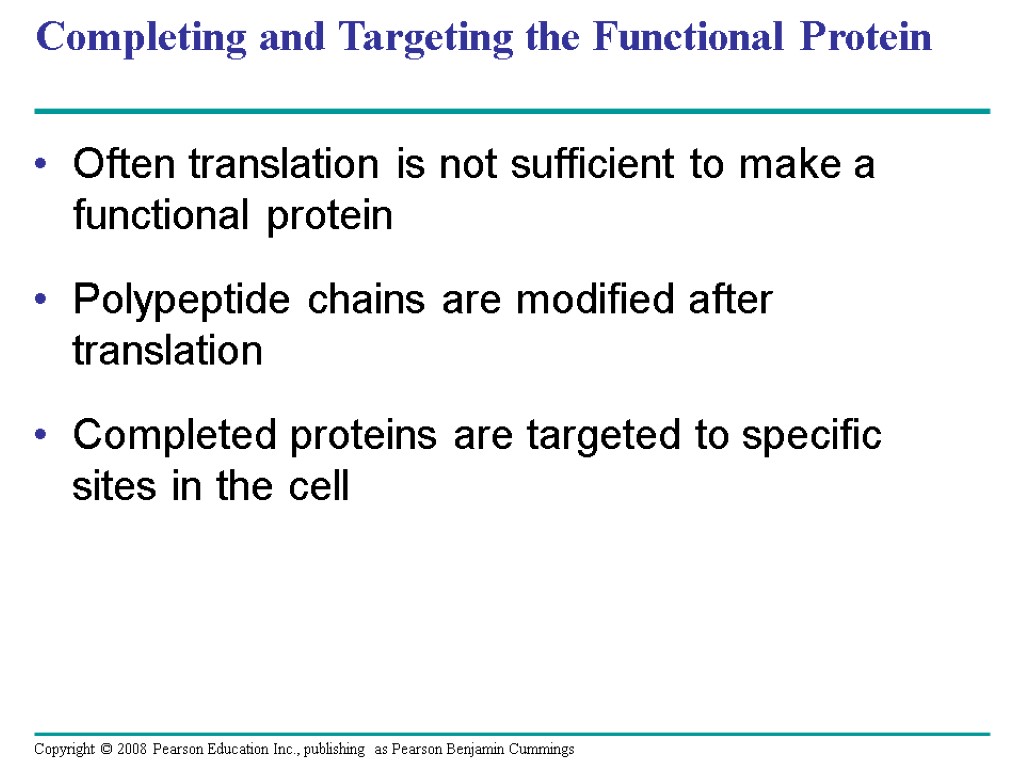
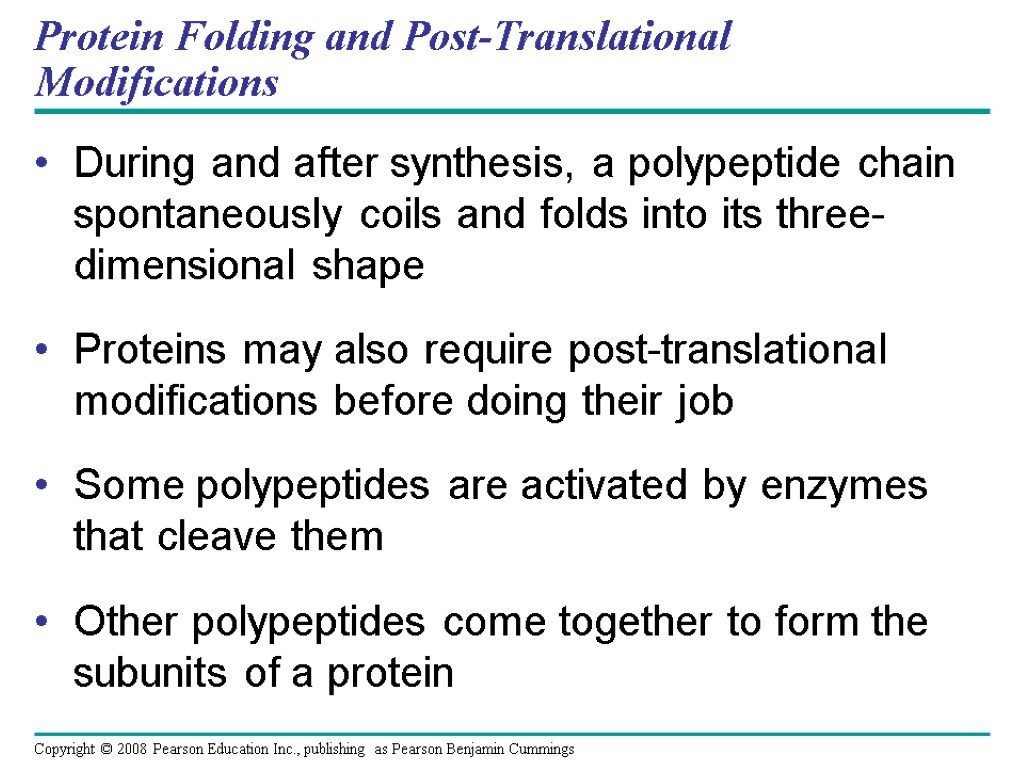
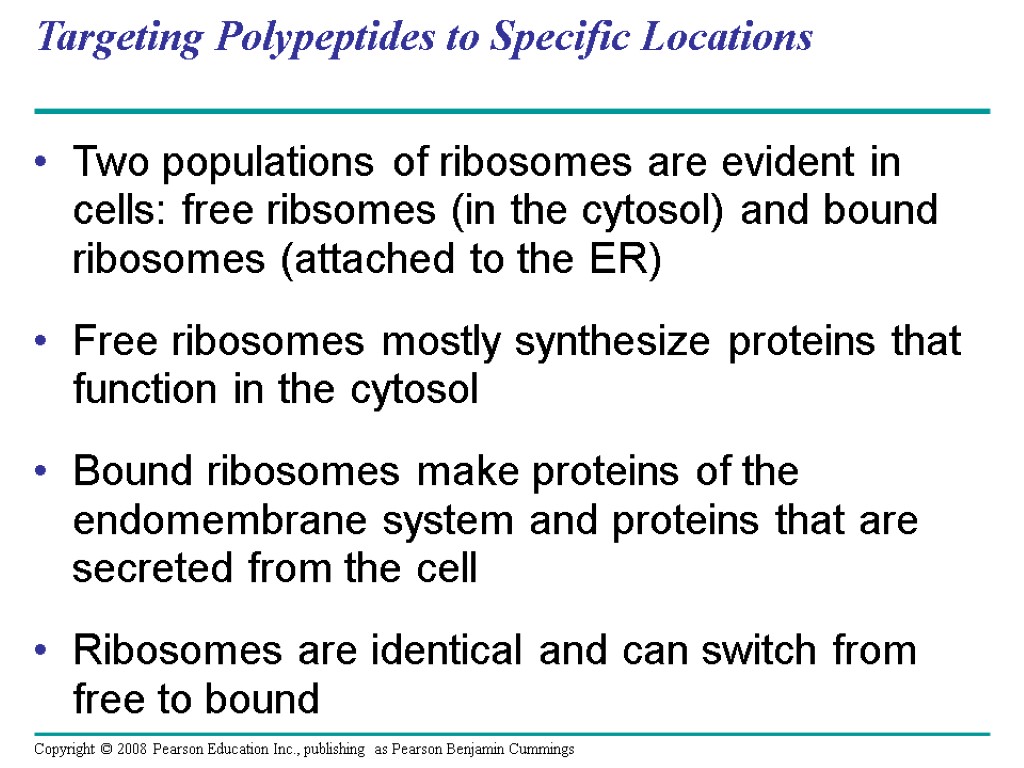
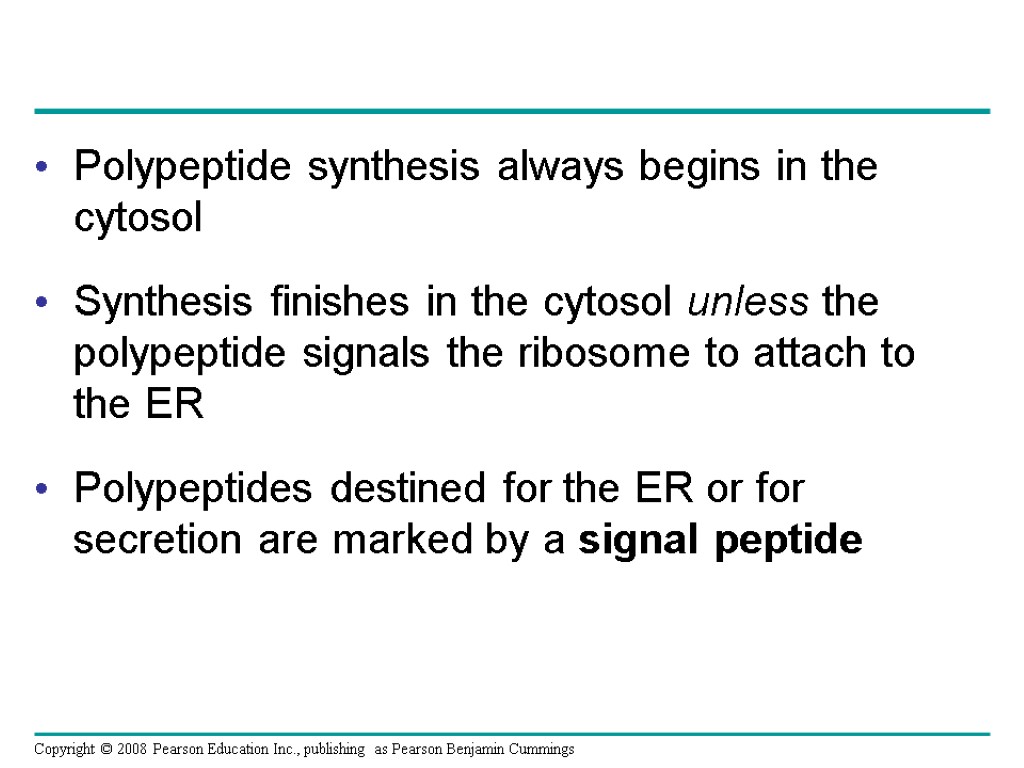

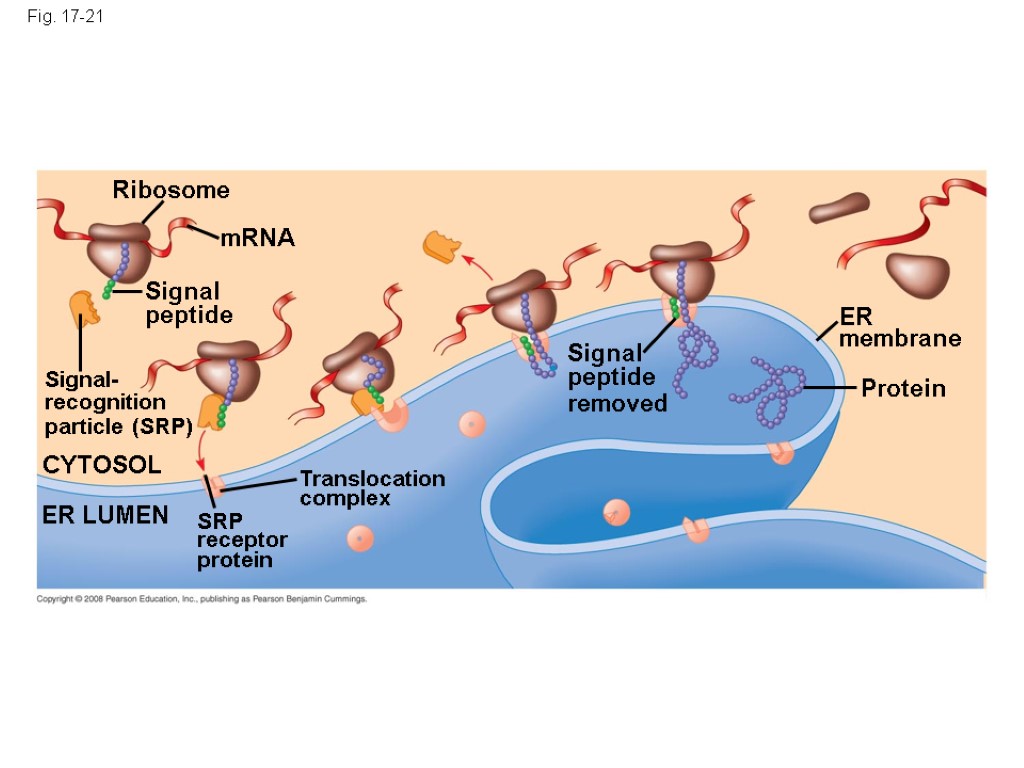
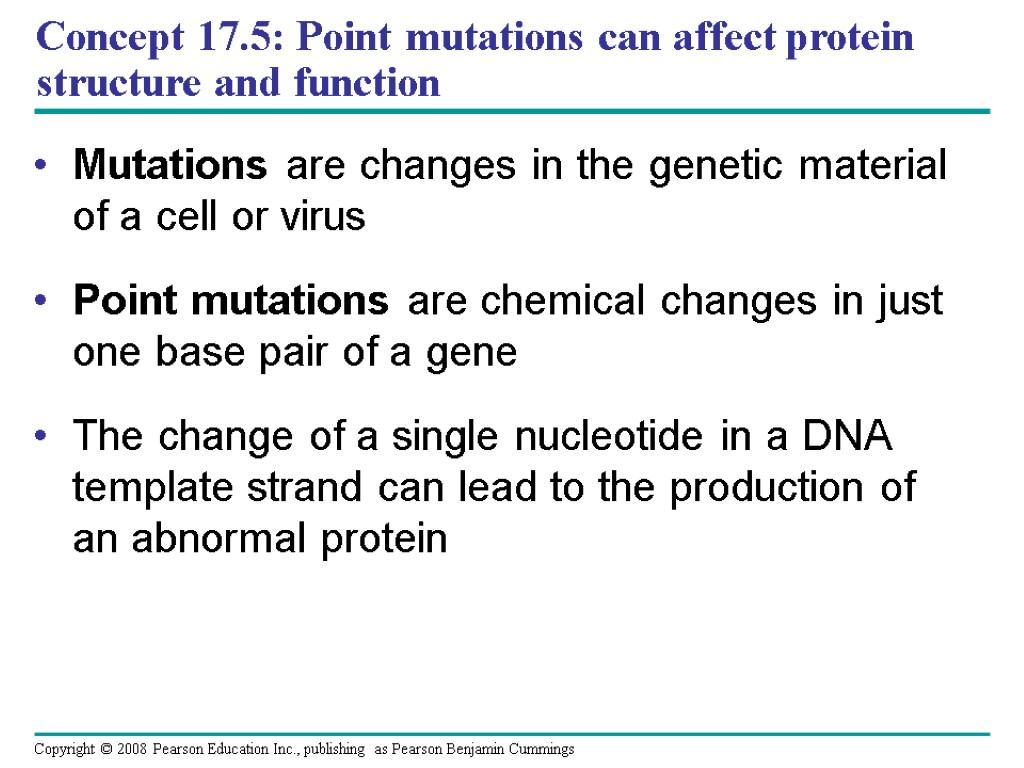
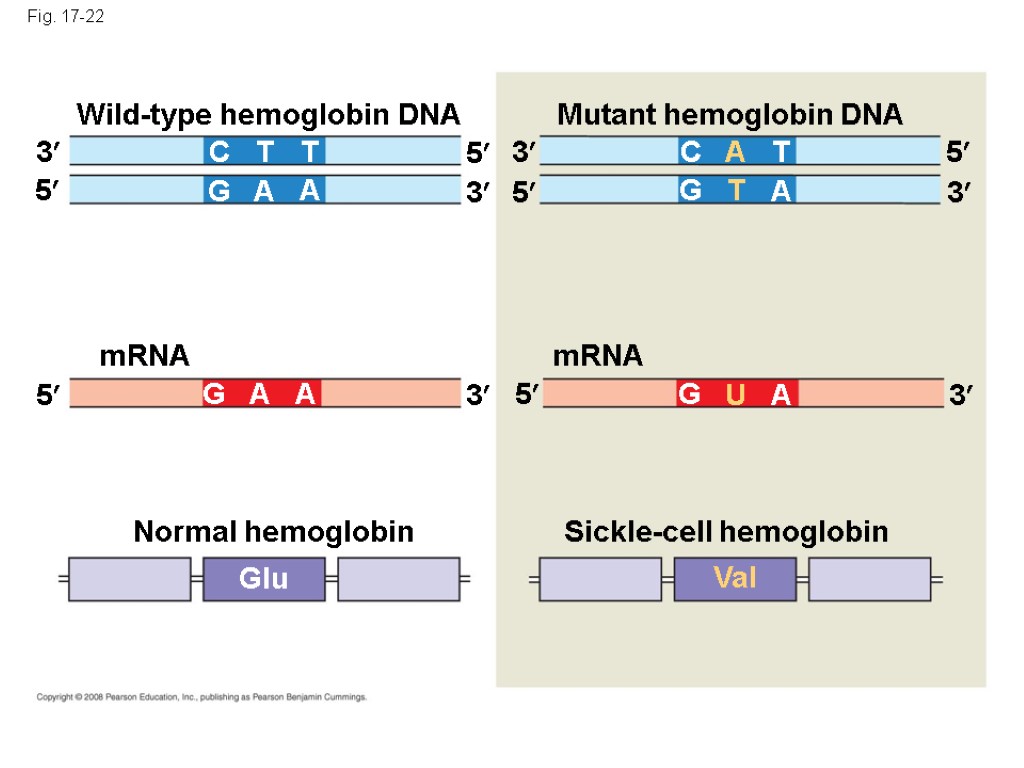
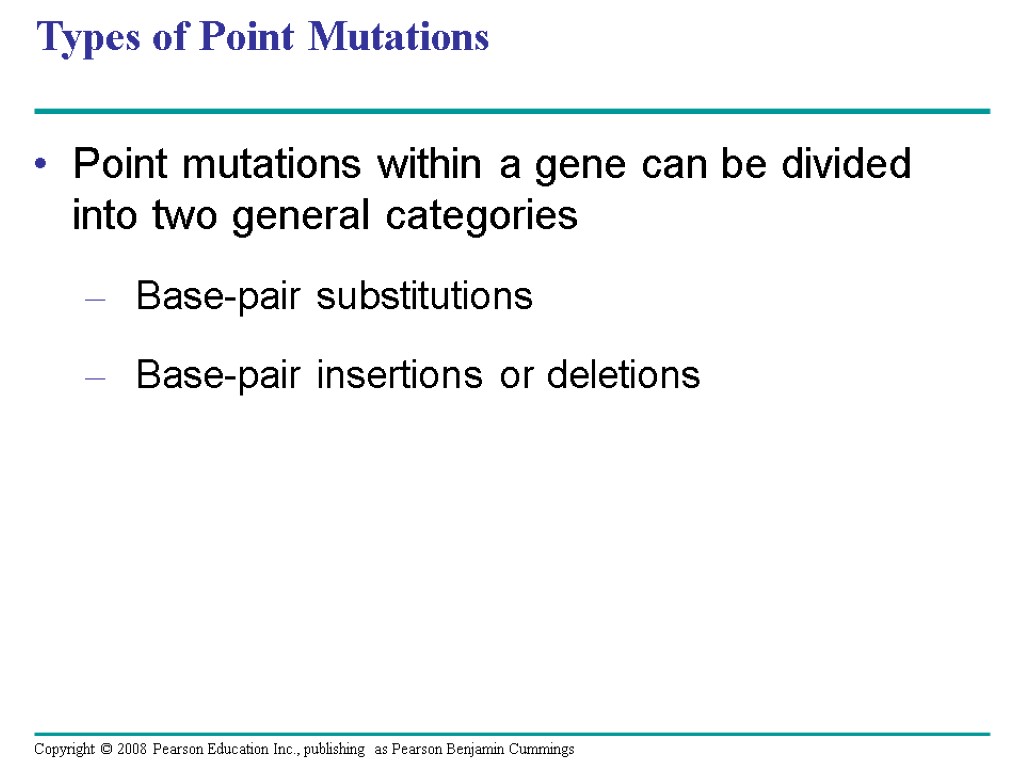
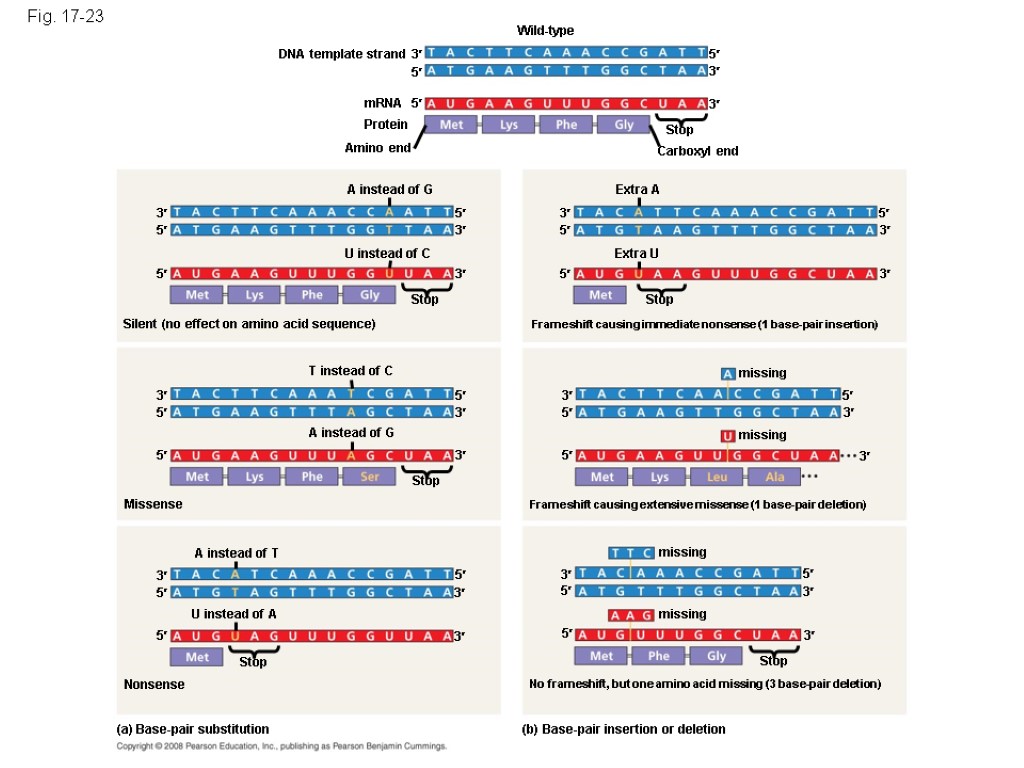
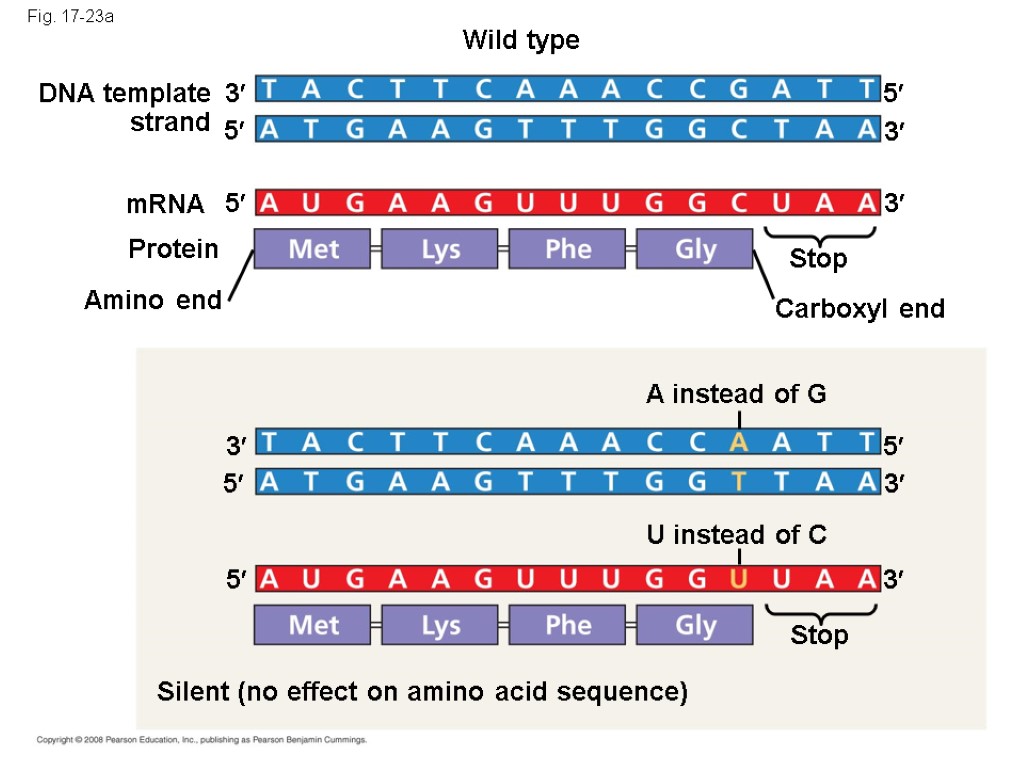
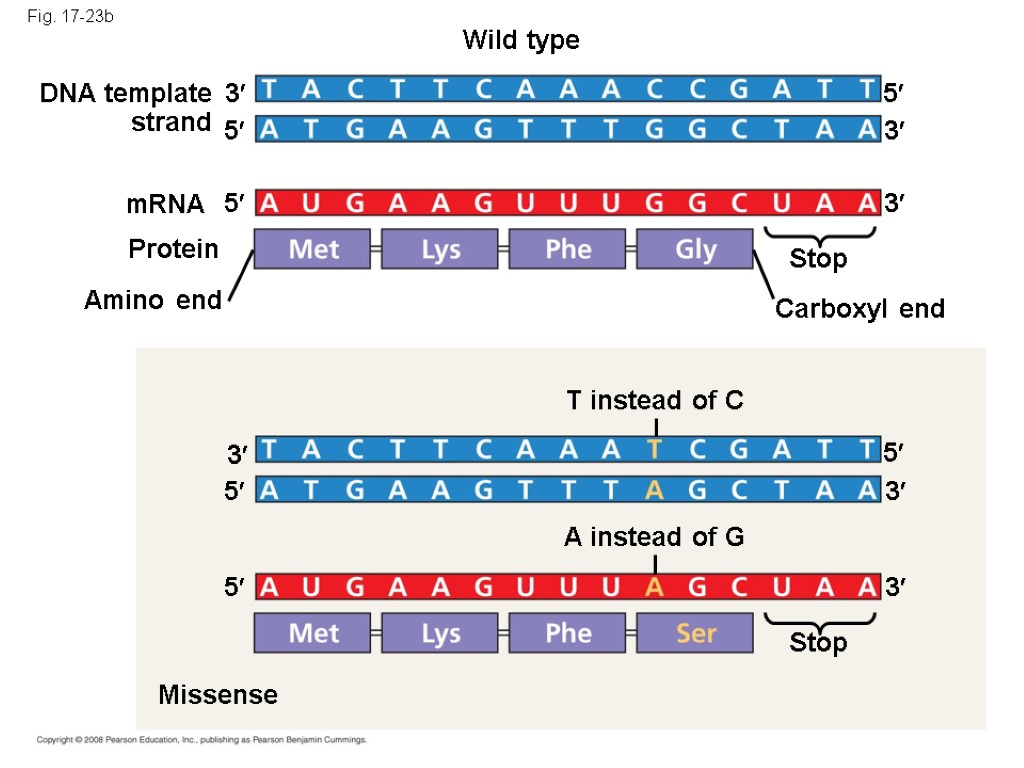
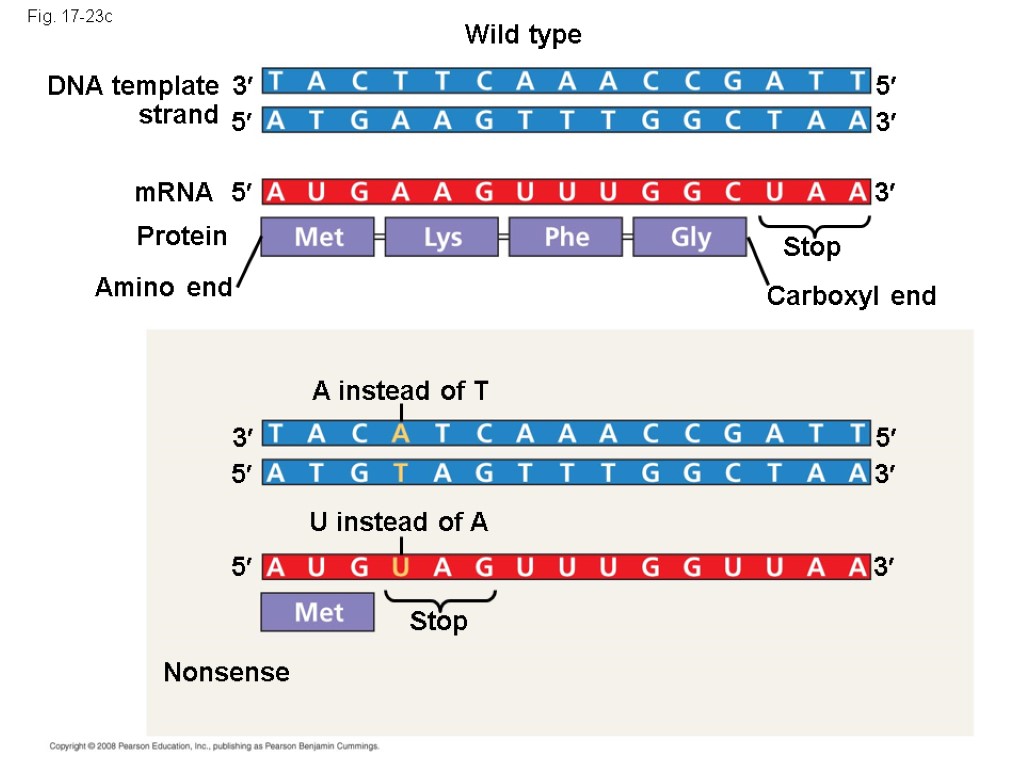
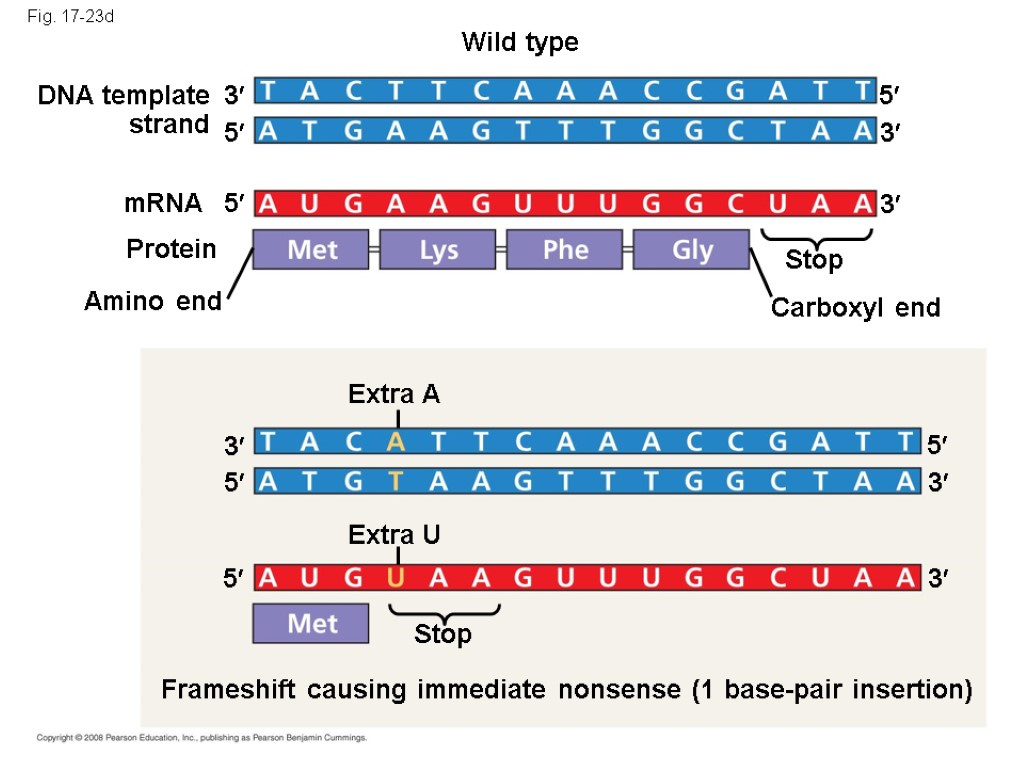
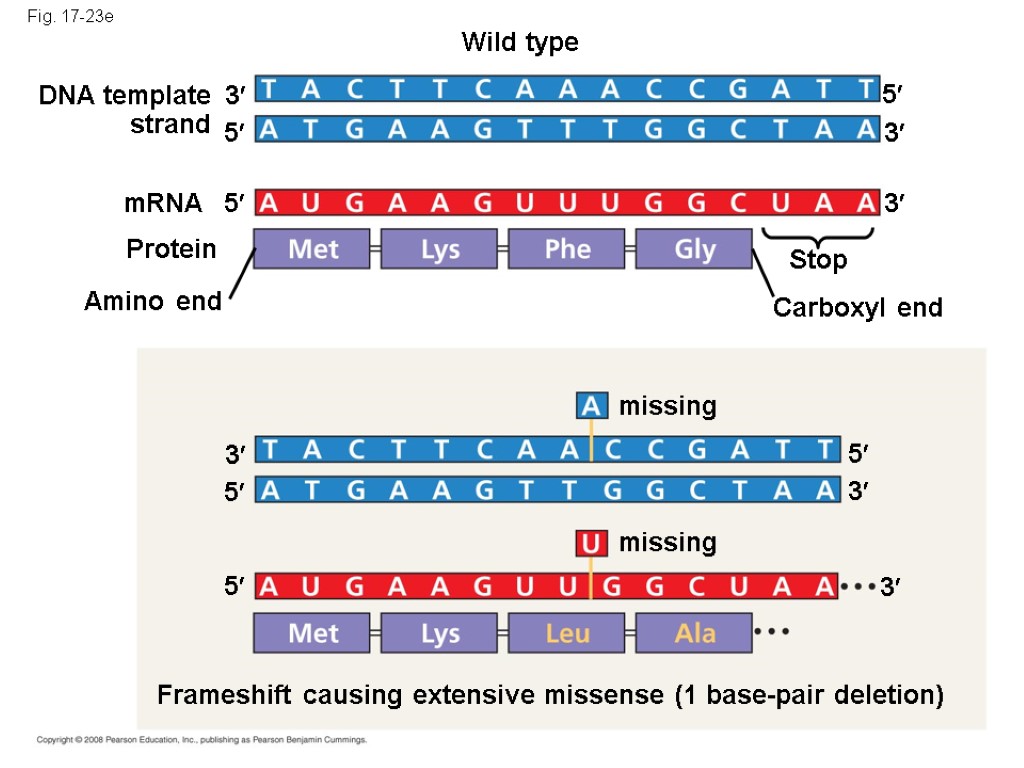
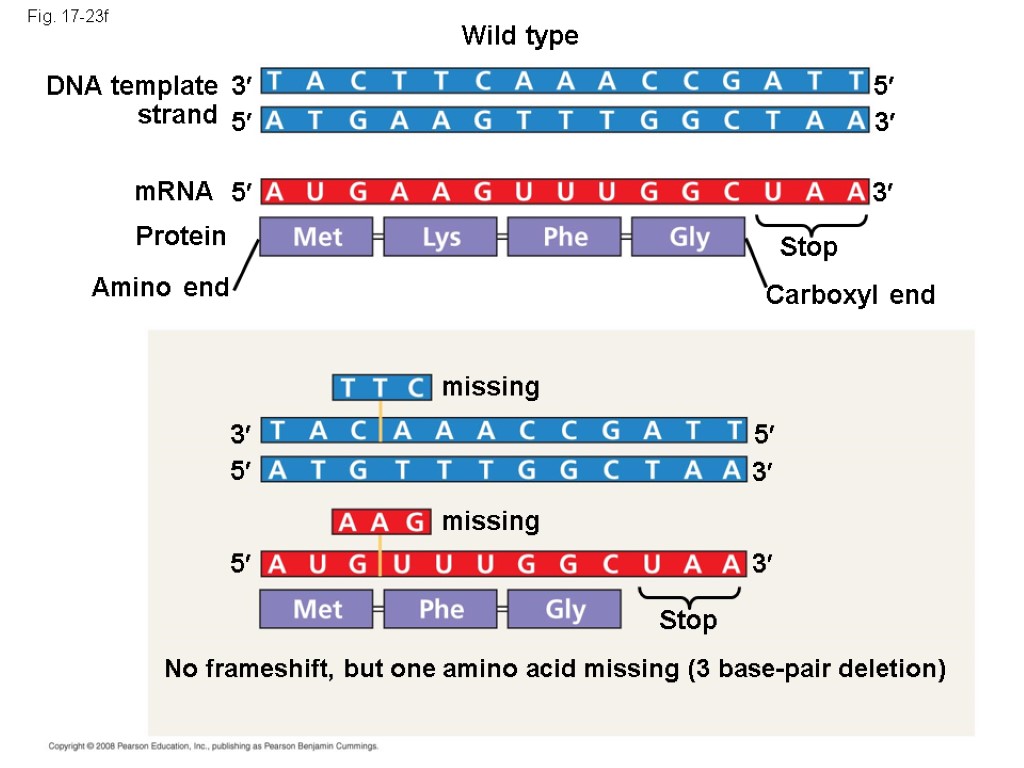
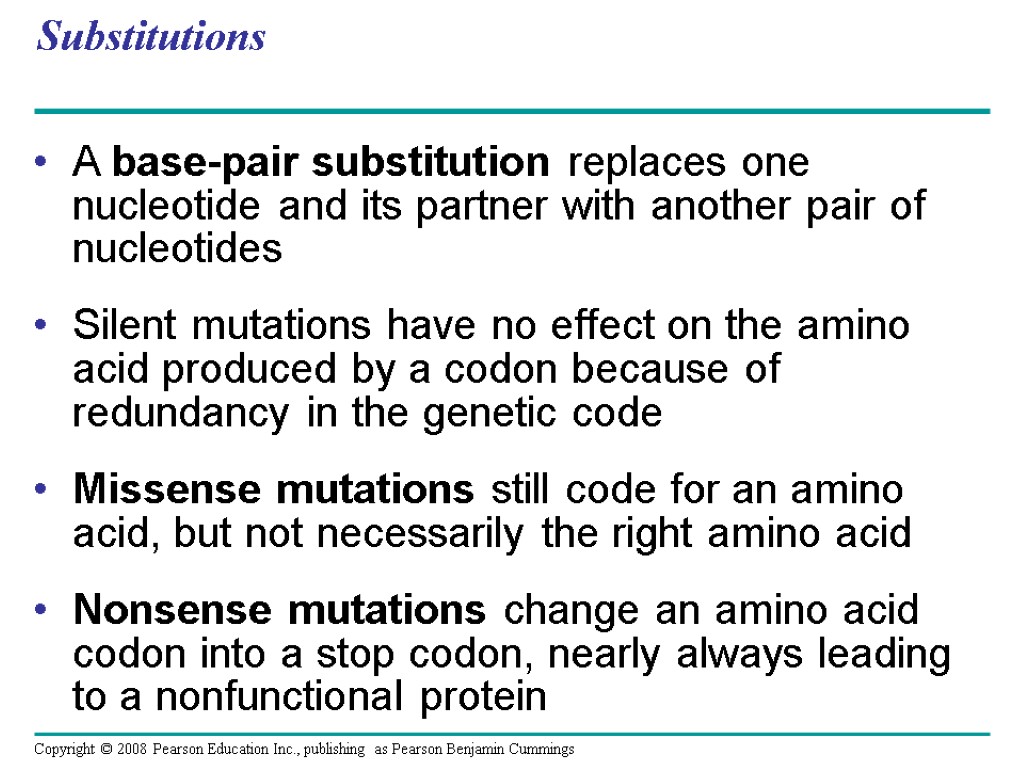
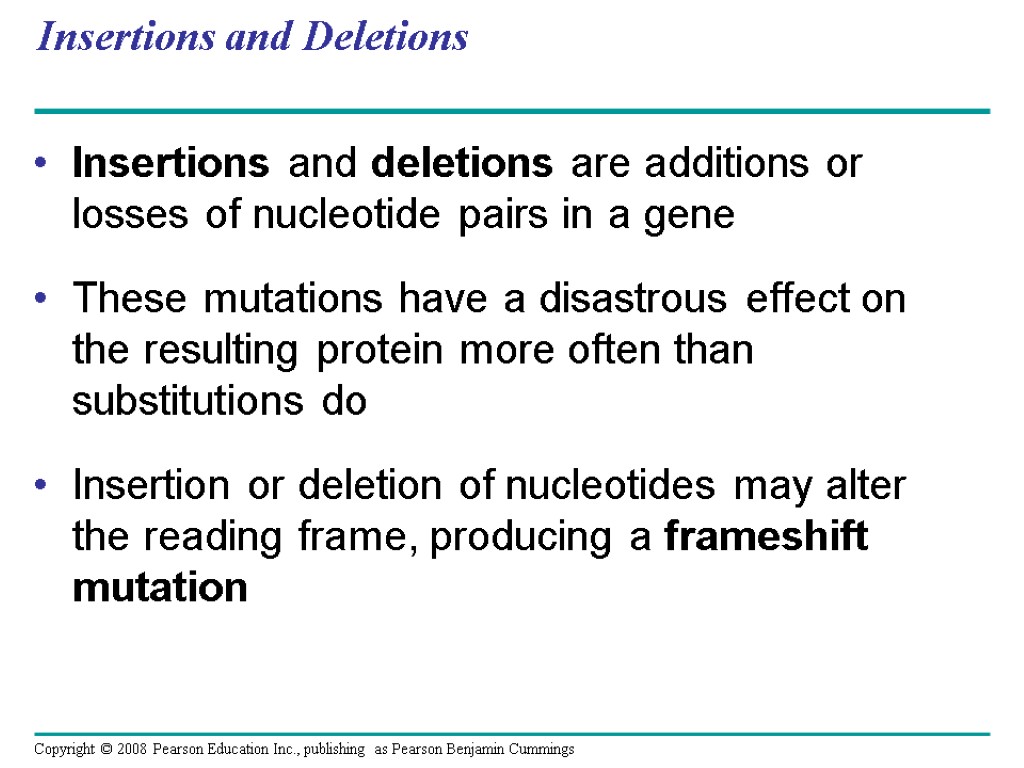
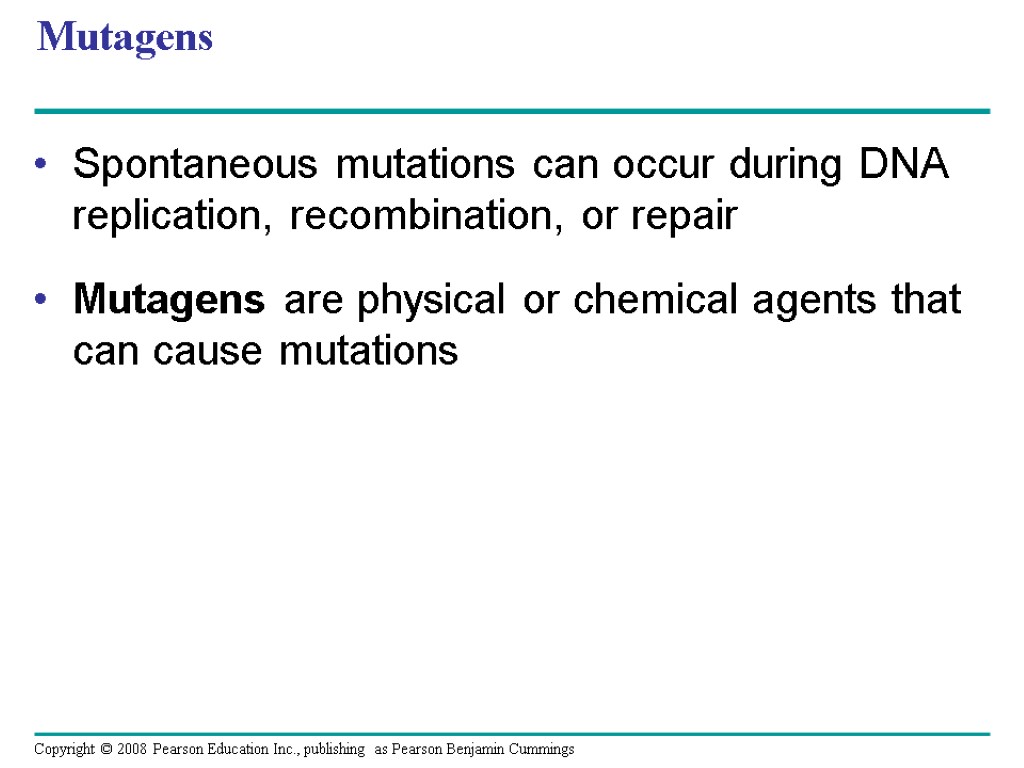
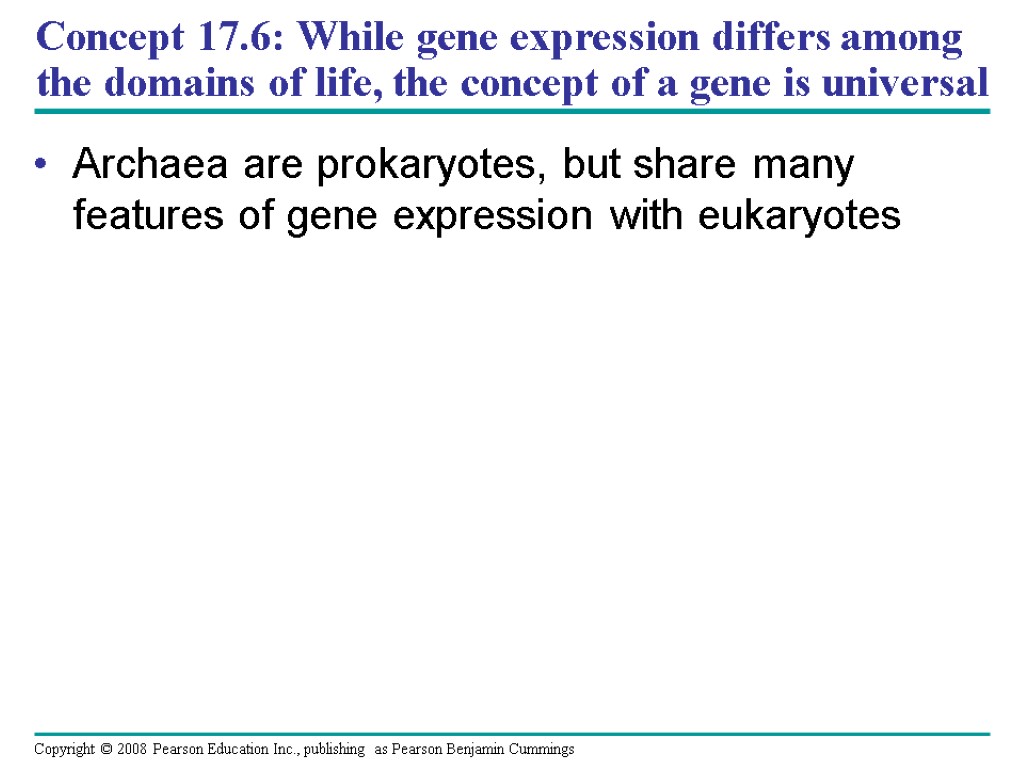
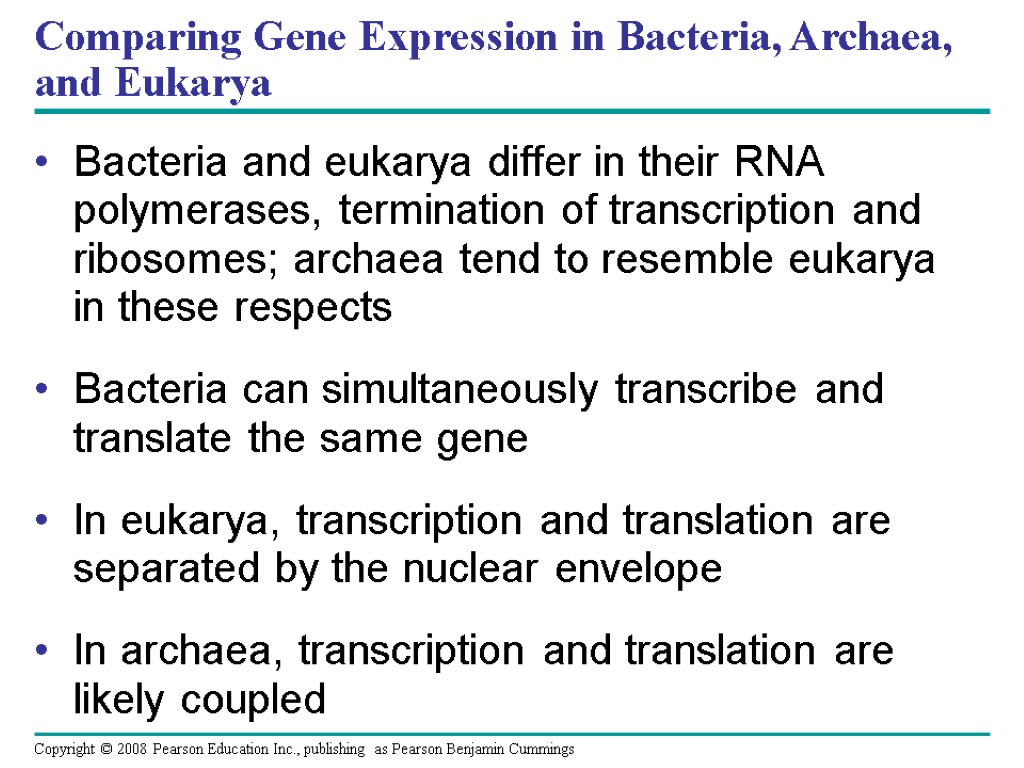
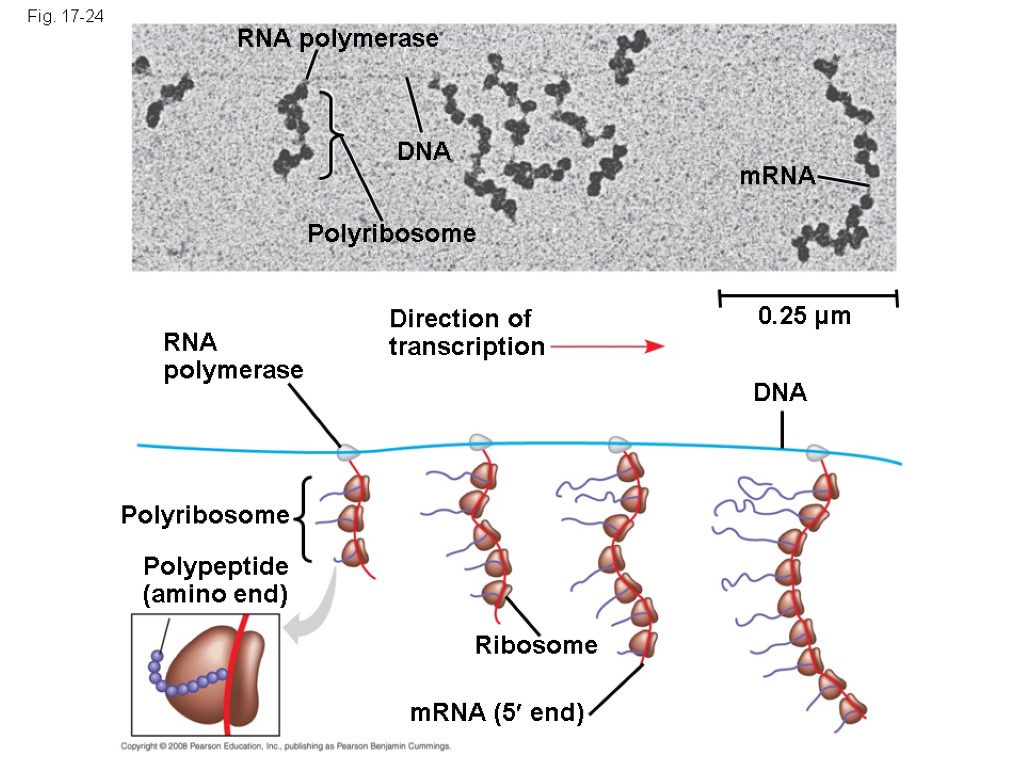


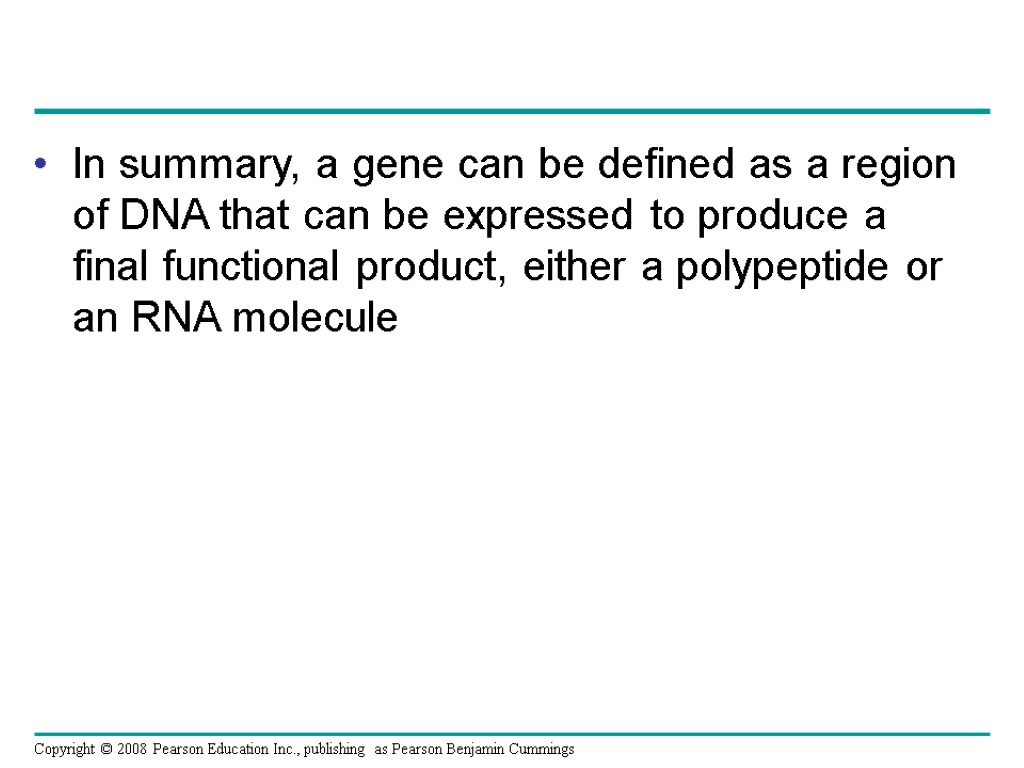
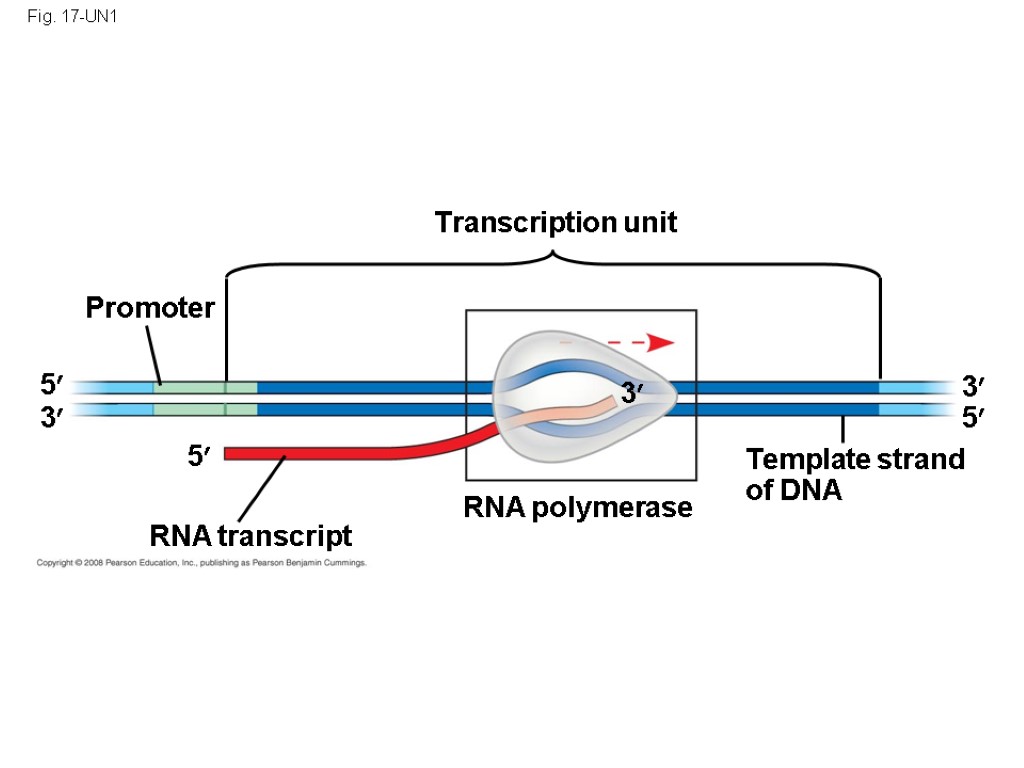
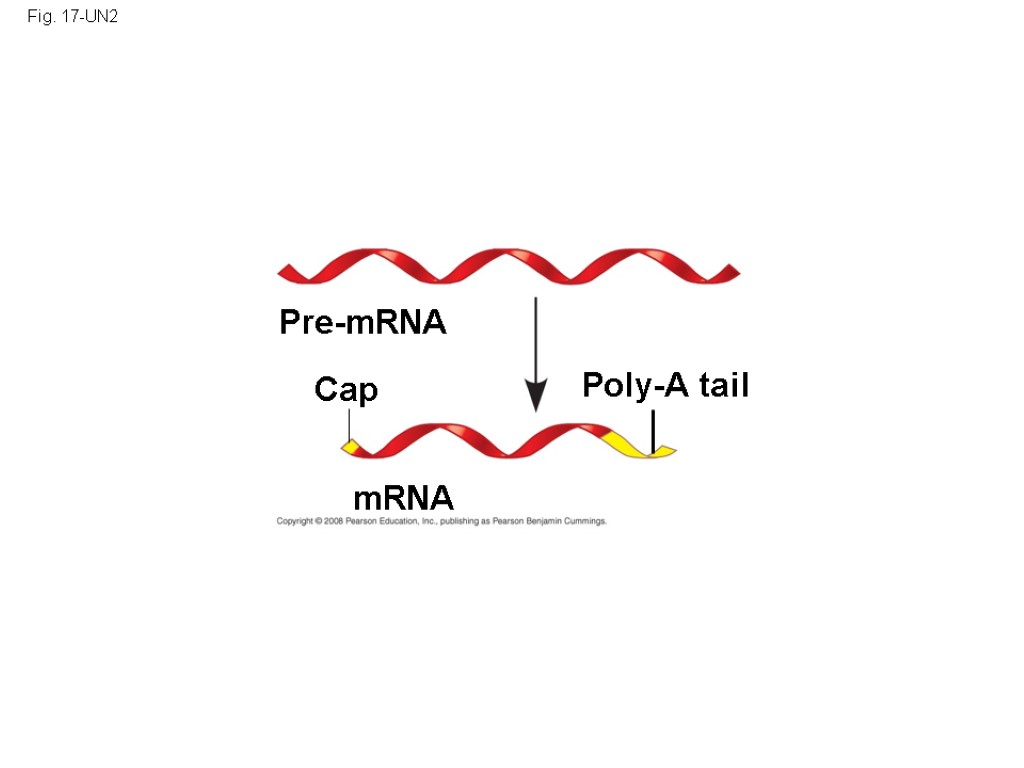
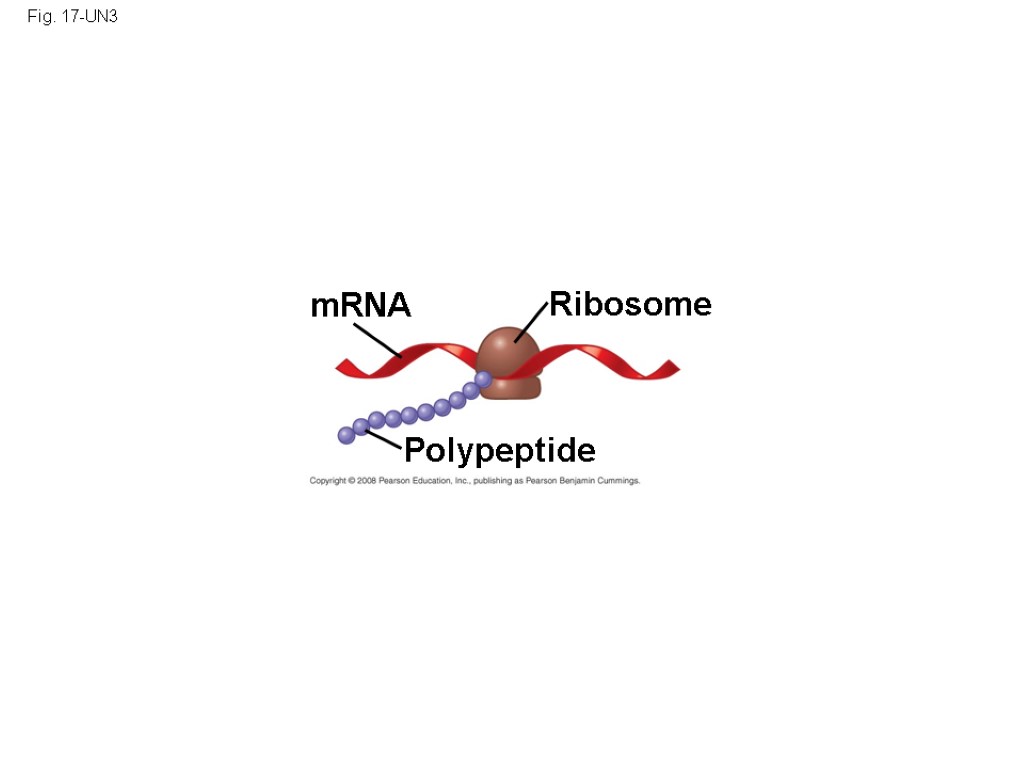
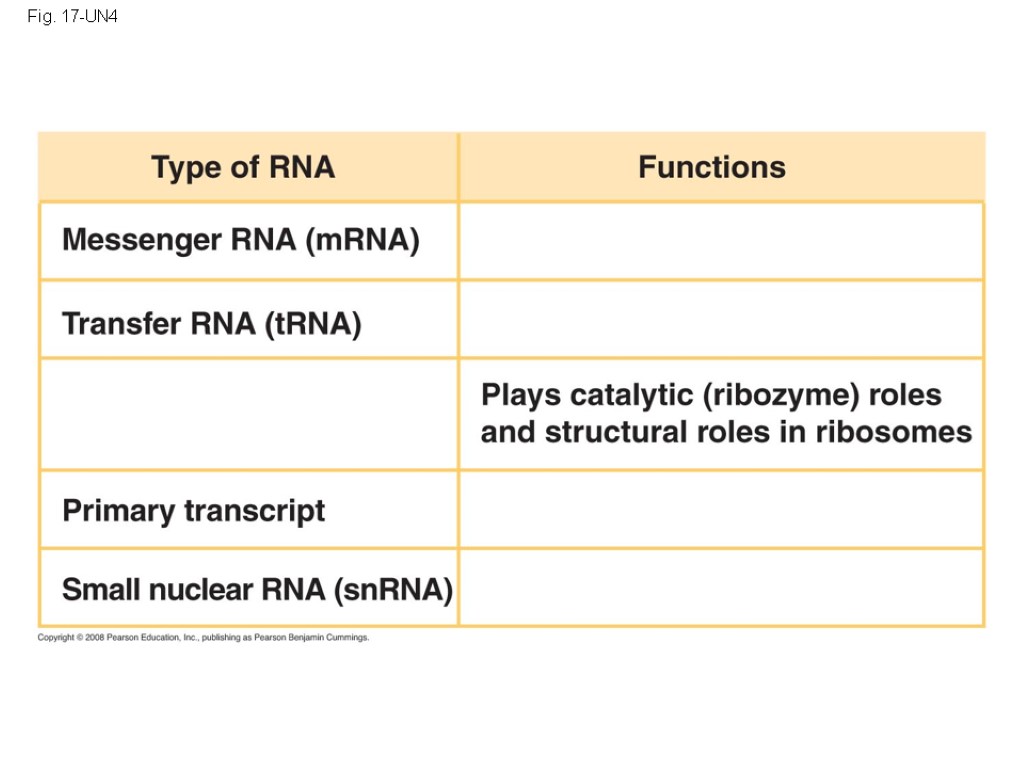

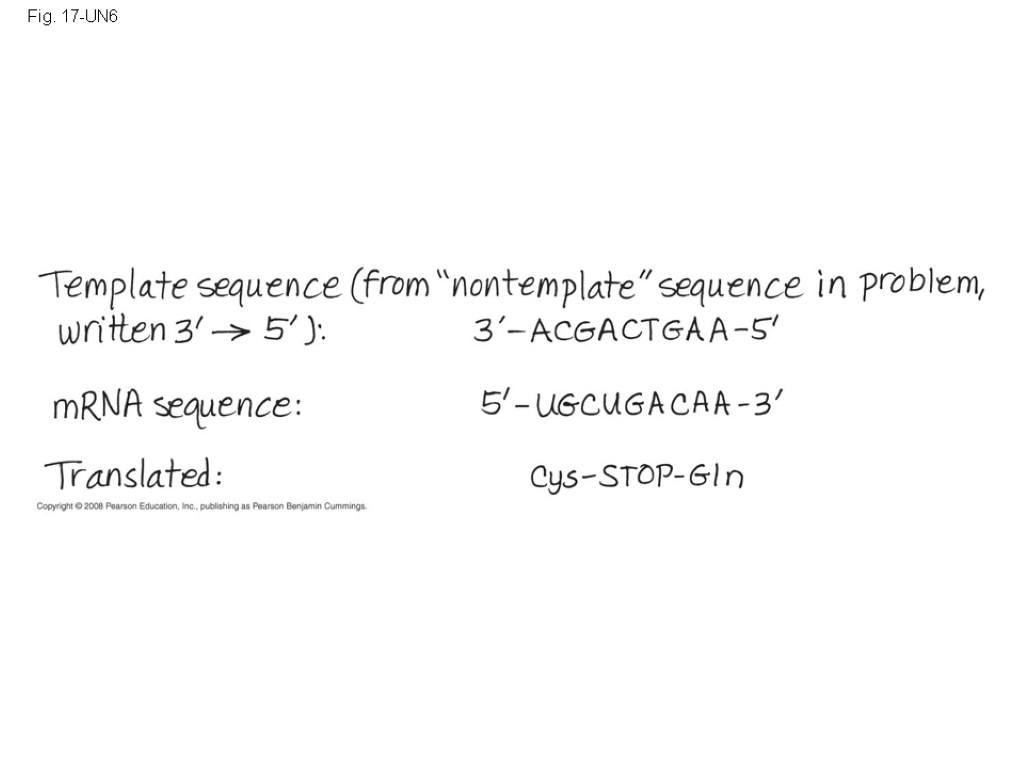
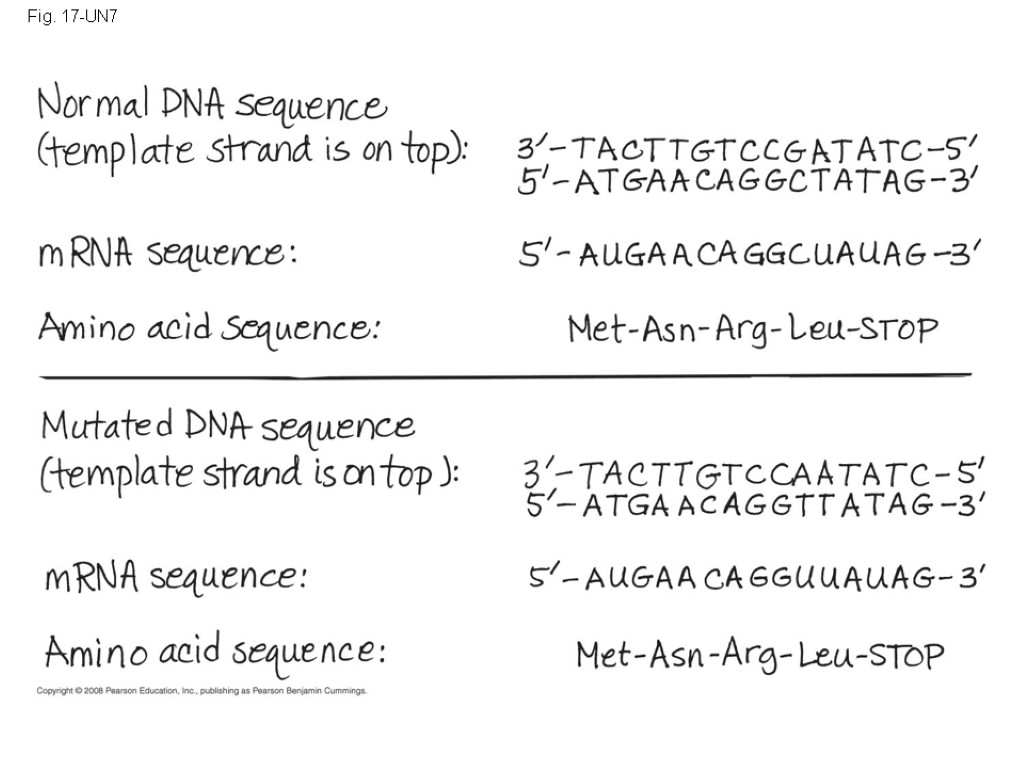
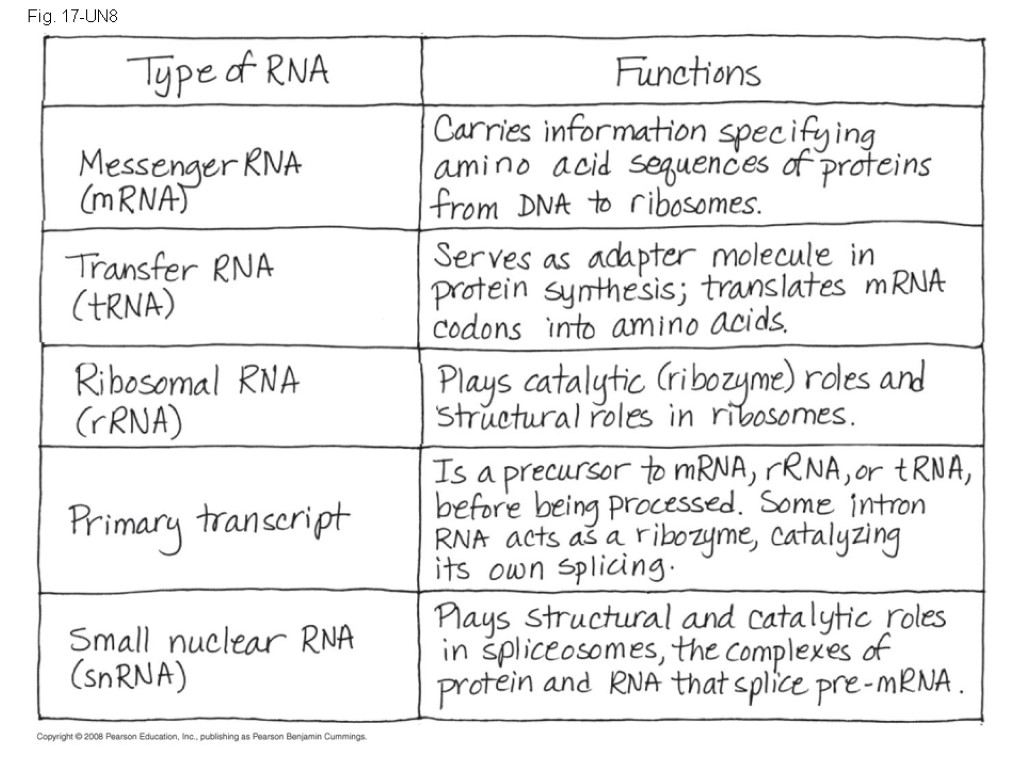
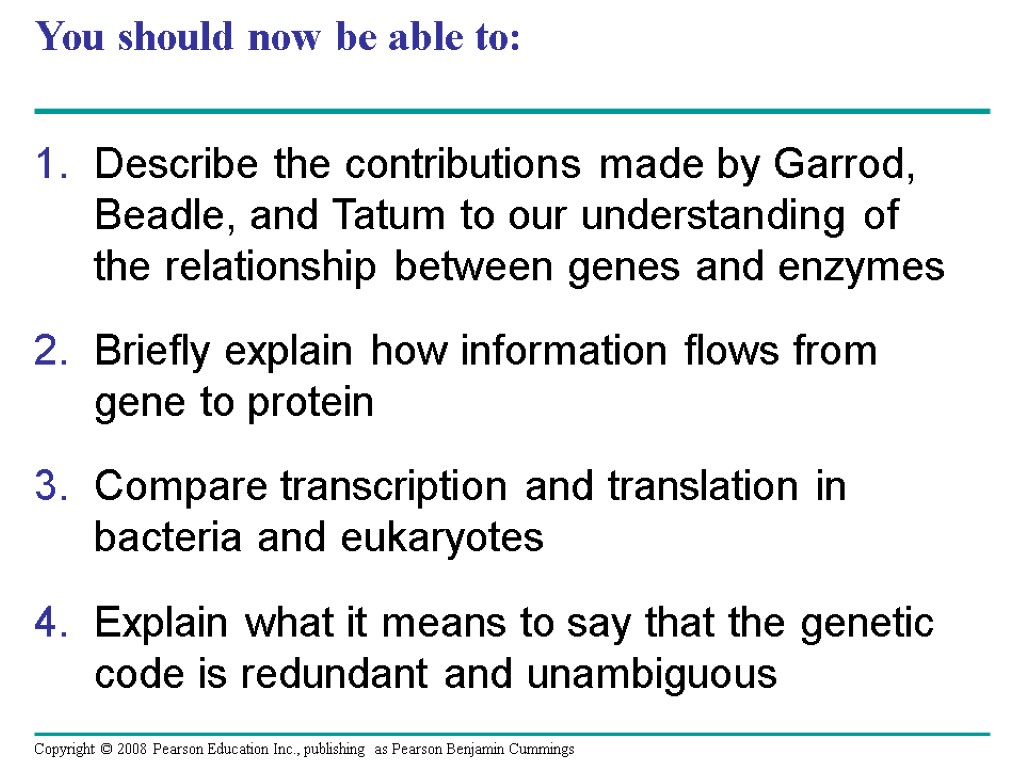

17_lecture_presentation.ppt
- Количество слайдов: 126
 Chapter 17 From Gene to Protein
Chapter 17 From Gene to Protein
 Overview: The Flow of Genetic Information The information content of DNA is in the form of specific sequences of nucleotides The DNA inherited by an organism leads to specific traits by dictating the synthesis of proteins Proteins are the links between genotype and phenotype Gene expression, the process by which DNA directs protein synthesis, includes two stages: transcription and translation Copyright © 2008 Pearson Education Inc., publishing as Pearson Benjamin Cummings
Overview: The Flow of Genetic Information The information content of DNA is in the form of specific sequences of nucleotides The DNA inherited by an organism leads to specific traits by dictating the synthesis of proteins Proteins are the links between genotype and phenotype Gene expression, the process by which DNA directs protein synthesis, includes two stages: transcription and translation Copyright © 2008 Pearson Education Inc., publishing as Pearson Benjamin Cummings
 Fig. 17-1
Fig. 17-1
 Concept 17.1: Genes specify proteins via transcription and translation How was the fundamental relationship between genes and proteins discovered? Copyright © 2008 Pearson Education Inc., publishing as Pearson Benjamin Cummings
Concept 17.1: Genes specify proteins via transcription and translation How was the fundamental relationship between genes and proteins discovered? Copyright © 2008 Pearson Education Inc., publishing as Pearson Benjamin Cummings
 Evidence from the Study of Metabolic Defects In 1909, British physician Archibald Garrod first suggested that genes dictate phenotypes through enzymes that catalyze specific chemical reactions He thought symptoms of an inherited disease reflect an inability to synthesize a certain enzyme Linking genes to enzymes required understanding that cells synthesize and degrade molecules in a series of steps, a metabolic pathway Copyright © 2008 Pearson Education Inc., publishing as Pearson Benjamin Cummings
Evidence from the Study of Metabolic Defects In 1909, British physician Archibald Garrod first suggested that genes dictate phenotypes through enzymes that catalyze specific chemical reactions He thought symptoms of an inherited disease reflect an inability to synthesize a certain enzyme Linking genes to enzymes required understanding that cells synthesize and degrade molecules in a series of steps, a metabolic pathway Copyright © 2008 Pearson Education Inc., publishing as Pearson Benjamin Cummings
 Nutritional Mutants in Neurospora: Scientific Inquiry George Beadle and Edward Tatum exposed bread mold to X-rays, creating mutants that were unable to survive on minimal medium as a result of inability to synthesize certain molecules Using crosses, they identified three classes of arginine-deficient mutants, each lacking a different enzyme necessary for synthesizing arginine They developed a one gene–one enzyme hypothesis, which states that each gene dictates production of a specific enzyme Copyright © 2008 Pearson Education Inc., publishing as Pearson Benjamin Cummings
Nutritional Mutants in Neurospora: Scientific Inquiry George Beadle and Edward Tatum exposed bread mold to X-rays, creating mutants that were unable to survive on minimal medium as a result of inability to synthesize certain molecules Using crosses, they identified three classes of arginine-deficient mutants, each lacking a different enzyme necessary for synthesizing arginine They developed a one gene–one enzyme hypothesis, which states that each gene dictates production of a specific enzyme Copyright © 2008 Pearson Education Inc., publishing as Pearson Benjamin Cummings
 Fig. 17-2 RESULTS EXPERIMENT CONCLUSION Growth: Wild-type cells growing and dividing No growth: Mutant cells cannot grow and divide Minimal medium Classes of Neurospora crassa Wild type Class I mutants Class II mutants Class III mutants Minimal medium (MM) (control) MM + ornithine MM + citrulline Condition MM + arginine (control) Class I mutants (mutation in gene A) Wild type Class II mutants (mutation in gene B) Class III mutants (mutation in gene C) Gene A Gene B Gene C Precursor Precursor Precursor Precursor Enzyme A Enzyme A Enzyme A Enzyme A Enzyme B Ornithine Ornithine Ornithine Ornithine Enzyme B Enzyme B Enzyme B Citrulline Citrulline Citrulline Citrulline Enzyme C Enzyme C Enzyme C Enzyme C Arginine Arginine Arginine Arginine
Fig. 17-2 RESULTS EXPERIMENT CONCLUSION Growth: Wild-type cells growing and dividing No growth: Mutant cells cannot grow and divide Minimal medium Classes of Neurospora crassa Wild type Class I mutants Class II mutants Class III mutants Minimal medium (MM) (control) MM + ornithine MM + citrulline Condition MM + arginine (control) Class I mutants (mutation in gene A) Wild type Class II mutants (mutation in gene B) Class III mutants (mutation in gene C) Gene A Gene B Gene C Precursor Precursor Precursor Precursor Enzyme A Enzyme A Enzyme A Enzyme A Enzyme B Ornithine Ornithine Ornithine Ornithine Enzyme B Enzyme B Enzyme B Citrulline Citrulline Citrulline Citrulline Enzyme C Enzyme C Enzyme C Enzyme C Arginine Arginine Arginine Arginine
 Fig. 17-2a EXPERIMENT Growth: Wild-type cells growing and dividing No growth: Mutant cells cannot grow and divide Minimal medium
Fig. 17-2a EXPERIMENT Growth: Wild-type cells growing and dividing No growth: Mutant cells cannot grow and divide Minimal medium
 Fig. 17-2b RESULTS Classes of Neurospora crassa Wild type Class I mutants Class II mutants Class III mutants Minimal medium (MM) (control) MM + ornithine MM + citrulline MM + arginine (control) Condition
Fig. 17-2b RESULTS Classes of Neurospora crassa Wild type Class I mutants Class II mutants Class III mutants Minimal medium (MM) (control) MM + ornithine MM + citrulline MM + arginine (control) Condition
 Fig. 17-2c CONCLUSION Class I mutants (mutation in gene A) Class II mutants (mutation in gene B) Class III mutants (mutation in gene C) Wild type Precursor Precursor Precursor Precursor Enzyme A Enzyme A Enzyme A Enzyme A Ornithine Ornithine Ornithine Ornithine Enzyme B Enzyme B Enzyme B Enzyme B Citrulline Citrulline Citrulline Citrulline Enzyme C Enzyme C Enzyme C Enzyme C Arginine Arginine Arginine Arginine Gene A Gene B Gene C
Fig. 17-2c CONCLUSION Class I mutants (mutation in gene A) Class II mutants (mutation in gene B) Class III mutants (mutation in gene C) Wild type Precursor Precursor Precursor Precursor Enzyme A Enzyme A Enzyme A Enzyme A Ornithine Ornithine Ornithine Ornithine Enzyme B Enzyme B Enzyme B Enzyme B Citrulline Citrulline Citrulline Citrulline Enzyme C Enzyme C Enzyme C Enzyme C Arginine Arginine Arginine Arginine Gene A Gene B Gene C
 The Products of Gene Expression: A Developing Story Some proteins aren’t enzymes, so researchers later revised the hypothesis: one gene–one protein Many proteins are composed of several polypeptides, each of which has its own gene Therefore, Beadle and Tatum’s hypothesis is now restated as the one gene–one polypeptide hypothesis Note that it is common to refer to gene products as proteins rather than polypeptides Copyright © 2008 Pearson Education Inc., publishing as Pearson Benjamin Cummings
The Products of Gene Expression: A Developing Story Some proteins aren’t enzymes, so researchers later revised the hypothesis: one gene–one protein Many proteins are composed of several polypeptides, each of which has its own gene Therefore, Beadle and Tatum’s hypothesis is now restated as the one gene–one polypeptide hypothesis Note that it is common to refer to gene products as proteins rather than polypeptides Copyright © 2008 Pearson Education Inc., publishing as Pearson Benjamin Cummings
 Basic Principles of Transcription and Translation RNA is the intermediate between genes and the proteins for which they code Transcription is the synthesis of RNA under the direction of DNA Transcription produces messenger RNA (mRNA) Translation is the synthesis of a polypeptide, which occurs under the direction of mRNA Ribosomes are the sites of translation Copyright © 2008 Pearson Education Inc., publishing as Pearson Benjamin Cummings
Basic Principles of Transcription and Translation RNA is the intermediate between genes and the proteins for which they code Transcription is the synthesis of RNA under the direction of DNA Transcription produces messenger RNA (mRNA) Translation is the synthesis of a polypeptide, which occurs under the direction of mRNA Ribosomes are the sites of translation Copyright © 2008 Pearson Education Inc., publishing as Pearson Benjamin Cummings
 In prokaryotes, mRNA produced by transcription is immediately translated without more processing In a eukaryotic cell, the nuclear envelope separates transcription from translation Eukaryotic RNA transcripts are modified through RNA processing to yield finished mRNA Copyright © 2008 Pearson Education Inc., publishing as Pearson Benjamin Cummings
In prokaryotes, mRNA produced by transcription is immediately translated without more processing In a eukaryotic cell, the nuclear envelope separates transcription from translation Eukaryotic RNA transcripts are modified through RNA processing to yield finished mRNA Copyright © 2008 Pearson Education Inc., publishing as Pearson Benjamin Cummings
 A primary transcript is the initial RNA transcript from any gene The central dogma is the concept that cells are governed by a cellular chain of command: DNA RNA protein Copyright © 2008 Pearson Education Inc., publishing as Pearson Benjamin Cummings
A primary transcript is the initial RNA transcript from any gene The central dogma is the concept that cells are governed by a cellular chain of command: DNA RNA protein Copyright © 2008 Pearson Education Inc., publishing as Pearson Benjamin Cummings
 Fig. 17-3 TRANSCRIPTION TRANSLATION DNA mRNA Ribosome Polypeptide (a) Bacterial cell Nuclear envelope TRANSCRIPTION RNA PROCESSING Pre-mRNA DNA mRNA TRANSLATION Ribosome Polypeptide (b) Eukaryotic cell
Fig. 17-3 TRANSCRIPTION TRANSLATION DNA mRNA Ribosome Polypeptide (a) Bacterial cell Nuclear envelope TRANSCRIPTION RNA PROCESSING Pre-mRNA DNA mRNA TRANSLATION Ribosome Polypeptide (b) Eukaryotic cell
 Fig. 17-3a-1 TRANSCRIPTION DNA mRNA (a) Bacterial cell
Fig. 17-3a-1 TRANSCRIPTION DNA mRNA (a) Bacterial cell
 Fig. 17-3a-2 (a) Bacterial cell TRANSCRIPTION DNA mRNA TRANSLATION Ribosome Polypeptide
Fig. 17-3a-2 (a) Bacterial cell TRANSCRIPTION DNA mRNA TRANSLATION Ribosome Polypeptide
 Fig. 17-3b-1 (b) Eukaryotic cell TRANSCRIPTION Nuclear envelope DNA Pre-mRNA
Fig. 17-3b-1 (b) Eukaryotic cell TRANSCRIPTION Nuclear envelope DNA Pre-mRNA
 Fig. 17-3b-2 (b) Eukaryotic cell TRANSCRIPTION Nuclear envelope DNA Pre-mRNA RNA PROCESSING mRNA
Fig. 17-3b-2 (b) Eukaryotic cell TRANSCRIPTION Nuclear envelope DNA Pre-mRNA RNA PROCESSING mRNA
 Fig. 17-3b-3 (b) Eukaryotic cell TRANSCRIPTION Nuclear envelope DNA Pre-mRNA RNA PROCESSING mRNA TRANSLATION Ribosome Polypeptide
Fig. 17-3b-3 (b) Eukaryotic cell TRANSCRIPTION Nuclear envelope DNA Pre-mRNA RNA PROCESSING mRNA TRANSLATION Ribosome Polypeptide
 The Genetic Code How are the instructions for assembling amino acids into proteins encoded into DNA? There are 20 amino acids, but there are only four nucleotide bases in DNA How many bases correspond to an amino acid? Copyright © 2008 Pearson Education Inc., publishing as Pearson Benjamin Cummings
The Genetic Code How are the instructions for assembling amino acids into proteins encoded into DNA? There are 20 amino acids, but there are only four nucleotide bases in DNA How many bases correspond to an amino acid? Copyright © 2008 Pearson Education Inc., publishing as Pearson Benjamin Cummings
 Codons: Triplets of Bases The flow of information from gene to protein is based on a triplet code: a series of nonoverlapping, three-nucleotide words These triplets are the smallest units of uniform length that can code for all the amino acids Example: AGT at a particular position on a DNA strand results in the placement of the amino acid serine at the corresponding position of the polypeptide to be produced Copyright © 2008 Pearson Education Inc., publishing as Pearson Benjamin Cummings
Codons: Triplets of Bases The flow of information from gene to protein is based on a triplet code: a series of nonoverlapping, three-nucleotide words These triplets are the smallest units of uniform length that can code for all the amino acids Example: AGT at a particular position on a DNA strand results in the placement of the amino acid serine at the corresponding position of the polypeptide to be produced Copyright © 2008 Pearson Education Inc., publishing as Pearson Benjamin Cummings
 During transcription, one of the two DNA strands called the template strand provides a template for ordering the sequence of nucleotides in an RNA transcript During translation, the mRNA base triplets, called codons, are read in the 5 to 3 direction Each codon specifies the amino acid to be placed at the corresponding position along a polypeptide Copyright © 2008 Pearson Education Inc., publishing as Pearson Benjamin Cummings
During transcription, one of the two DNA strands called the template strand provides a template for ordering the sequence of nucleotides in an RNA transcript During translation, the mRNA base triplets, called codons, are read in the 5 to 3 direction Each codon specifies the amino acid to be placed at the corresponding position along a polypeptide Copyright © 2008 Pearson Education Inc., publishing as Pearson Benjamin Cummings
 Codons along an mRNA molecule are read by translation machinery in the 5 to 3 direction Each codon specifies the addition of one of 20 amino acids Copyright © 2008 Pearson Education Inc., publishing as Pearson Benjamin Cummings
Codons along an mRNA molecule are read by translation machinery in the 5 to 3 direction Each codon specifies the addition of one of 20 amino acids Copyright © 2008 Pearson Education Inc., publishing as Pearson Benjamin Cummings
 Fig. 17-4 DNA molecule Gene 1 Gene 2 Gene 3 DNA template strand TRANSCRIPTION TRANSLATION mRNA Protein Codon Amino acid
Fig. 17-4 DNA molecule Gene 1 Gene 2 Gene 3 DNA template strand TRANSCRIPTION TRANSLATION mRNA Protein Codon Amino acid
 Cracking the Code All 64 codons were deciphered by the mid-1960s Of the 64 triplets, 61 code for amino acids; 3 triplets are “stop” signals to end translation The genetic code is redundant but not ambiguous; no codon specifies more than one amino acid Codons must be read in the correct reading frame (correct groupings) in order for the specified polypeptide to be produced Copyright © 2008 Pearson Education Inc., publishing as Pearson Benjamin Cummings
Cracking the Code All 64 codons were deciphered by the mid-1960s Of the 64 triplets, 61 code for amino acids; 3 triplets are “stop” signals to end translation The genetic code is redundant but not ambiguous; no codon specifies more than one amino acid Codons must be read in the correct reading frame (correct groupings) in order for the specified polypeptide to be produced Copyright © 2008 Pearson Education Inc., publishing as Pearson Benjamin Cummings
 Fig. 17-5 Second mRNA base First mRNA base (5 end of codon) Third mRNA base (3 end of codon)
Fig. 17-5 Second mRNA base First mRNA base (5 end of codon) Third mRNA base (3 end of codon)
 Evolution of the Genetic Code The genetic code is nearly universal, shared by the simplest bacteria to the most complex animals Genes can be transcribed and translated after being transplanted from one species to another Copyright © 2008 Pearson Education Inc., publishing as Pearson Benjamin Cummings
Evolution of the Genetic Code The genetic code is nearly universal, shared by the simplest bacteria to the most complex animals Genes can be transcribed and translated after being transplanted from one species to another Copyright © 2008 Pearson Education Inc., publishing as Pearson Benjamin Cummings
 Fig. 17-6 (a) Tobacco plant expressing a firefly gene (b) Pig expressing a jellyfish gene
Fig. 17-6 (a) Tobacco plant expressing a firefly gene (b) Pig expressing a jellyfish gene
 Fig. 17-6a (a) Tobacco plant expressing a firefly gene
Fig. 17-6a (a) Tobacco plant expressing a firefly gene
 Fig. 17-6b (b) Pig expressing a jellyfish gene
Fig. 17-6b (b) Pig expressing a jellyfish gene
 Concept 17.2: Transcription is the DNA-directed synthesis of RNA: a closer look Transcription, the first stage of gene expression, can be examined in more detail Copyright © 2008 Pearson Education Inc., publishing as Pearson Benjamin Cummings
Concept 17.2: Transcription is the DNA-directed synthesis of RNA: a closer look Transcription, the first stage of gene expression, can be examined in more detail Copyright © 2008 Pearson Education Inc., publishing as Pearson Benjamin Cummings
 Molecular Components of Transcription RNA synthesis is catalyzed by RNA polymerase, which pries the DNA strands apart and hooks together the RNA nucleotides RNA synthesis follows the same base-pairing rules as DNA, except uracil substitutes for thymine Copyright © 2008 Pearson Education Inc., publishing as Pearson Benjamin Cummings
Molecular Components of Transcription RNA synthesis is catalyzed by RNA polymerase, which pries the DNA strands apart and hooks together the RNA nucleotides RNA synthesis follows the same base-pairing rules as DNA, except uracil substitutes for thymine Copyright © 2008 Pearson Education Inc., publishing as Pearson Benjamin Cummings
 The DNA sequence where RNA polymerase attaches is called the promoter; in bacteria, the sequence signaling the end of transcription is called the terminator The stretch of DNA that is transcribed is called a transcription unit Copyright © 2008 Pearson Education Inc., publishing as Pearson Benjamin Cummings Animation: Transcription
The DNA sequence where RNA polymerase attaches is called the promoter; in bacteria, the sequence signaling the end of transcription is called the terminator The stretch of DNA that is transcribed is called a transcription unit Copyright © 2008 Pearson Education Inc., publishing as Pearson Benjamin Cummings Animation: Transcription
 Fig. 17-7 Promoter Transcription unit Start point DNA RNA polymerase 5 5 3 3 Initiation 1 2 3 5 5 3 3 Unwound DNA RNA transcript Template strand of DNA Elongation Rewound DNA 5 5 5 5 5 3 3 3 3 RNA transcript Termination 5 5 3 3 3 5 Completed RNA transcript Newly made RNA Template strand of DNA Direction of transcription (“downstream”) 3 end RNA polymerase RNA nucleotides Nontemplate strand of DNA Elongation
Fig. 17-7 Promoter Transcription unit Start point DNA RNA polymerase 5 5 3 3 Initiation 1 2 3 5 5 3 3 Unwound DNA RNA transcript Template strand of DNA Elongation Rewound DNA 5 5 5 5 5 3 3 3 3 RNA transcript Termination 5 5 3 3 3 5 Completed RNA transcript Newly made RNA Template strand of DNA Direction of transcription (“downstream”) 3 end RNA polymerase RNA nucleotides Nontemplate strand of DNA Elongation
 Fig. 17-7a-1 Promoter Transcription unit DNA Start point RNA polymerase 5 5 3 3
Fig. 17-7a-1 Promoter Transcription unit DNA Start point RNA polymerase 5 5 3 3
 Fig. 17-7a-2 Promoter Transcription unit DNA Start point RNA polymerase 5 5 3 3 Initiation 3 3 1 RNA transcript 5 5 Unwound DNA Template strand of DNA
Fig. 17-7a-2 Promoter Transcription unit DNA Start point RNA polymerase 5 5 3 3 Initiation 3 3 1 RNA transcript 5 5 Unwound DNA Template strand of DNA
 Fig. 17-7a-3 Promoter Transcription unit DNA Start point RNA polymerase 5 5 3 3 Initiation 3 3 1 RNA transcript 5 5 Unwound DNA Template strand of DNA 2 Elongation Rewound DNA 5 5 5 3 3 3 RNA transcript
Fig. 17-7a-3 Promoter Transcription unit DNA Start point RNA polymerase 5 5 3 3 Initiation 3 3 1 RNA transcript 5 5 Unwound DNA Template strand of DNA 2 Elongation Rewound DNA 5 5 5 3 3 3 RNA transcript
 Fig. 17-7a-4 Promoter Transcription unit DNA Start point RNA polymerase 5 5 3 3 Initiation 3 3 1 RNA transcript 5 5 Unwound DNA Template strand of DNA 2 Elongation Rewound DNA 5 5 5 3 3 3 RNA transcript 3 Termination 5 5 5 3 3 3 Completed RNA transcript
Fig. 17-7a-4 Promoter Transcription unit DNA Start point RNA polymerase 5 5 3 3 Initiation 3 3 1 RNA transcript 5 5 Unwound DNA Template strand of DNA 2 Elongation Rewound DNA 5 5 5 3 3 3 RNA transcript 3 Termination 5 5 5 3 3 3 Completed RNA transcript
 Fig. 17-7b Elongation RNA polymerase Nontemplate strand of DNA RNA nucleotides 3 end Direction of transcription (“downstream”) Template strand of DNA Newly made RNA 3 5 5
Fig. 17-7b Elongation RNA polymerase Nontemplate strand of DNA RNA nucleotides 3 end Direction of transcription (“downstream”) Template strand of DNA Newly made RNA 3 5 5
 Synthesis of an RNA Transcript The three stages of transcription: Initiation Elongation Termination Copyright © 2008 Pearson Education Inc., publishing as Pearson Benjamin Cummings
Synthesis of an RNA Transcript The three stages of transcription: Initiation Elongation Termination Copyright © 2008 Pearson Education Inc., publishing as Pearson Benjamin Cummings
 RNA Polymerase Binding and Initiation of Transcription Promoters signal the initiation of RNA synthesis Transcription factors mediate the binding of RNA polymerase and the initiation of transcription The completed assembly of transcription factors and RNA polymerase II bound to a promoter is called a transcription initiation complex A promoter called a TATA box is crucial in forming the initiation complex in eukaryotes Copyright © 2008 Pearson Education Inc., publishing as Pearson Benjamin Cummings
RNA Polymerase Binding and Initiation of Transcription Promoters signal the initiation of RNA synthesis Transcription factors mediate the binding of RNA polymerase and the initiation of transcription The completed assembly of transcription factors and RNA polymerase II bound to a promoter is called a transcription initiation complex A promoter called a TATA box is crucial in forming the initiation complex in eukaryotes Copyright © 2008 Pearson Education Inc., publishing as Pearson Benjamin Cummings
 Fig. 17-8 A eukaryotic promoter includes a TATA box 3 1 2 3 Promoter TATA box Start point Template Template DNA strand 5 3 5 Transcription factors Several transcription factors must bind to the DNA before RNA polymerase II can do so. 5 5 3 3 Additional transcription factors bind to the DNA along with RNA polymerase II, forming the transcription initiation complex. RNA polymerase II Transcription factors 5 5 5 3 3 RNA transcript Transcription initiation complex
Fig. 17-8 A eukaryotic promoter includes a TATA box 3 1 2 3 Promoter TATA box Start point Template Template DNA strand 5 3 5 Transcription factors Several transcription factors must bind to the DNA before RNA polymerase II can do so. 5 5 3 3 Additional transcription factors bind to the DNA along with RNA polymerase II, forming the transcription initiation complex. RNA polymerase II Transcription factors 5 5 5 3 3 RNA transcript Transcription initiation complex
 Elongation of the RNA Strand As RNA polymerase moves along the DNA, it untwists the double helix, 10 to 20 bases at a time Transcription progresses at a rate of 40 nucleotides per second in eukaryotes A gene can be transcribed simultaneously by several RNA polymerases Copyright © 2008 Pearson Education Inc., publishing as Pearson Benjamin Cummings
Elongation of the RNA Strand As RNA polymerase moves along the DNA, it untwists the double helix, 10 to 20 bases at a time Transcription progresses at a rate of 40 nucleotides per second in eukaryotes A gene can be transcribed simultaneously by several RNA polymerases Copyright © 2008 Pearson Education Inc., publishing as Pearson Benjamin Cummings
 Termination of Transcription The mechanisms of termination are different in bacteria and eukaryotes In bacteria, the polymerase stops transcription at the end of the terminator In eukaryotes, the polymerase continues transcription after the pre-mRNA is cleaved from the growing RNA chain; the polymerase eventually falls off the DNA Copyright © 2008 Pearson Education Inc., publishing as Pearson Benjamin Cummings
Termination of Transcription The mechanisms of termination are different in bacteria and eukaryotes In bacteria, the polymerase stops transcription at the end of the terminator In eukaryotes, the polymerase continues transcription after the pre-mRNA is cleaved from the growing RNA chain; the polymerase eventually falls off the DNA Copyright © 2008 Pearson Education Inc., publishing as Pearson Benjamin Cummings
 Concept 17.3: Eukaryotic cells modify RNA after transcription Enzymes in the eukaryotic nucleus modify pre-mRNA before the genetic messages are dispatched to the cytoplasm During RNA processing, both ends of the primary transcript are usually altered Also, usually some interior parts of the molecule are cut out, and the other parts spliced together Copyright © 2008 Pearson Education Inc., publishing as Pearson Benjamin Cummings
Concept 17.3: Eukaryotic cells modify RNA after transcription Enzymes in the eukaryotic nucleus modify pre-mRNA before the genetic messages are dispatched to the cytoplasm During RNA processing, both ends of the primary transcript are usually altered Also, usually some interior parts of the molecule are cut out, and the other parts spliced together Copyright © 2008 Pearson Education Inc., publishing as Pearson Benjamin Cummings
 Alteration of mRNA Ends Each end of a pre-mRNA molecule is modified in a particular way: The 5 end receives a modified nucleotide 5 cap The 3 end gets a poly-A tail These modifications share several functions: They seem to facilitate the export of mRNA They protect mRNA from hydrolytic enzymes They help ribosomes attach to the 5 end Copyright © 2008 Pearson Education Inc., publishing as Pearson Benjamin Cummings
Alteration of mRNA Ends Each end of a pre-mRNA molecule is modified in a particular way: The 5 end receives a modified nucleotide 5 cap The 3 end gets a poly-A tail These modifications share several functions: They seem to facilitate the export of mRNA They protect mRNA from hydrolytic enzymes They help ribosomes attach to the 5 end Copyright © 2008 Pearson Education Inc., publishing as Pearson Benjamin Cummings
 Fig. 17-9 Protein-coding segment Polyadenylation signal 3 3 UTR 5 UTR 5 5 Cap Start codon Stop codon Poly-A tail G P P P AAUAAA AAA AAA …
Fig. 17-9 Protein-coding segment Polyadenylation signal 3 3 UTR 5 UTR 5 5 Cap Start codon Stop codon Poly-A tail G P P P AAUAAA AAA AAA …
 Split Genes and RNA Splicing Most eukaryotic genes and their RNA transcripts have long noncoding stretches of nucleotides that lie between coding regions These noncoding regions are called intervening sequences, or introns The other regions are called exons because they are eventually expressed, usually translated into amino acid sequences RNA splicing removes introns and joins exons, creating an mRNA molecule with a continuous coding sequence Copyright © 2008 Pearson Education Inc., publishing as Pearson Benjamin Cummings
Split Genes and RNA Splicing Most eukaryotic genes and their RNA transcripts have long noncoding stretches of nucleotides that lie between coding regions These noncoding regions are called intervening sequences, or introns The other regions are called exons because they are eventually expressed, usually translated into amino acid sequences RNA splicing removes introns and joins exons, creating an mRNA molecule with a continuous coding sequence Copyright © 2008 Pearson Education Inc., publishing as Pearson Benjamin Cummings
 Fig. 17-10 Pre-mRNA mRNA Coding segment Introns cut out and exons spliced together 5 Cap Exon Intron 5 1 30 31 104 Exon Intron 105 Exon 146 3 Poly-A tail Poly-A tail 5 Cap 5 UTR 3 UTR 1 146
Fig. 17-10 Pre-mRNA mRNA Coding segment Introns cut out and exons spliced together 5 Cap Exon Intron 5 1 30 31 104 Exon Intron 105 Exon 146 3 Poly-A tail Poly-A tail 5 Cap 5 UTR 3 UTR 1 146
 In some cases, RNA splicing is carried out by spliceosomes Spliceosomes consist of a variety of proteins and several small nuclear ribonucleoproteins (snRNPs) that recognize the splice sites Copyright © 2008 Pearson Education Inc., publishing as Pearson Benjamin Cummings
In some cases, RNA splicing is carried out by spliceosomes Spliceosomes consist of a variety of proteins and several small nuclear ribonucleoproteins (snRNPs) that recognize the splice sites Copyright © 2008 Pearson Education Inc., publishing as Pearson Benjamin Cummings
 Fig. 17-11-1 RNA transcript (pre-mRNA) Exon 1 Exon 2 Intron Protein snRNA snRNPs Other proteins 5
Fig. 17-11-1 RNA transcript (pre-mRNA) Exon 1 Exon 2 Intron Protein snRNA snRNPs Other proteins 5
 Fig. 17-11-2 RNA transcript (pre-mRNA) Exon 1 Exon 2 Intron Protein snRNA snRNPs Other proteins 5 5 Spliceosome
Fig. 17-11-2 RNA transcript (pre-mRNA) Exon 1 Exon 2 Intron Protein snRNA snRNPs Other proteins 5 5 Spliceosome
 Fig. 17-11-3 RNA transcript (pre-mRNA) Exon 1 Exon 2 Intron Protein snRNA snRNPs Other proteins 5 5 Spliceosome Spliceosome components Cut-out intron mRNA Exon 1 Exon 2 5
Fig. 17-11-3 RNA transcript (pre-mRNA) Exon 1 Exon 2 Intron Protein snRNA snRNPs Other proteins 5 5 Spliceosome Spliceosome components Cut-out intron mRNA Exon 1 Exon 2 5
 Ribozymes Ribozymes are catalytic RNA molecules that function as enzymes and can splice RNA The discovery of ribozymes rendered obsolete the belief that all biological catalysts were proteins Copyright © 2008 Pearson Education Inc., publishing as Pearson Benjamin Cummings
Ribozymes Ribozymes are catalytic RNA molecules that function as enzymes and can splice RNA The discovery of ribozymes rendered obsolete the belief that all biological catalysts were proteins Copyright © 2008 Pearson Education Inc., publishing as Pearson Benjamin Cummings
 Three properties of RNA enable it to function as an enzyme It can form a three-dimensional structure because of its ability to base pair with itself Some bases in RNA contain functional groups RNA may hydrogen-bond with other nucleic acid molecules Copyright © 2008 Pearson Education Inc., publishing as Pearson Benjamin Cummings
Three properties of RNA enable it to function as an enzyme It can form a three-dimensional structure because of its ability to base pair with itself Some bases in RNA contain functional groups RNA may hydrogen-bond with other nucleic acid molecules Copyright © 2008 Pearson Education Inc., publishing as Pearson Benjamin Cummings
 The Functional and Evolutionary Importance of Introns Some genes can encode more than one kind of polypeptide, depending on which segments are treated as exons during RNA splicing Such variations are called alternative RNA splicing Because of alternative splicing, the number of different proteins an organism can produce is much greater than its number of genes Copyright © 2008 Pearson Education Inc., publishing as Pearson Benjamin Cummings
The Functional and Evolutionary Importance of Introns Some genes can encode more than one kind of polypeptide, depending on which segments are treated as exons during RNA splicing Such variations are called alternative RNA splicing Because of alternative splicing, the number of different proteins an organism can produce is much greater than its number of genes Copyright © 2008 Pearson Education Inc., publishing as Pearson Benjamin Cummings
 Proteins often have a modular architecture consisting of discrete regions called domains In many cases, different exons code for the different domains in a protein Exon shuffling may result in the evolution of new proteins Copyright © 2008 Pearson Education Inc., publishing as Pearson Benjamin Cummings
Proteins often have a modular architecture consisting of discrete regions called domains In many cases, different exons code for the different domains in a protein Exon shuffling may result in the evolution of new proteins Copyright © 2008 Pearson Education Inc., publishing as Pearson Benjamin Cummings
 Fig. 17-12 Gene DNA Exon 1 Exon 2 Exon 3 Intron Intron Transcription RNA processing Translation Domain 2 Domain 3 Domain 1 Polypeptide
Fig. 17-12 Gene DNA Exon 1 Exon 2 Exon 3 Intron Intron Transcription RNA processing Translation Domain 2 Domain 3 Domain 1 Polypeptide
 Concept 17.4: Translation is the RNA-directed synthesis of a polypeptide: a closer look The translation of mRNA to protein can be examined in more detail Copyright © 2008 Pearson Education Inc., publishing as Pearson Benjamin Cummings
Concept 17.4: Translation is the RNA-directed synthesis of a polypeptide: a closer look The translation of mRNA to protein can be examined in more detail Copyright © 2008 Pearson Education Inc., publishing as Pearson Benjamin Cummings
 Molecular Components of Translation A cell translates an mRNA message into protein with the help of transfer RNA (tRNA) Molecules of tRNA are not identical: Each carries a specific amino acid on one end Each has an anticodon on the other end; the anticodon base-pairs with a complementary codon on mRNA Copyright © 2008 Pearson Education Inc., publishing as Pearson Benjamin Cummings BioFlix: Protein Synthesis
Molecular Components of Translation A cell translates an mRNA message into protein with the help of transfer RNA (tRNA) Molecules of tRNA are not identical: Each carries a specific amino acid on one end Each has an anticodon on the other end; the anticodon base-pairs with a complementary codon on mRNA Copyright © 2008 Pearson Education Inc., publishing as Pearson Benjamin Cummings BioFlix: Protein Synthesis
 Fig. 17-13 Polypeptide Ribosome Amino acids tRNA with amino acid attached tRNA Anticodon Trp Phe Gly Codons 3 5 mRNA
Fig. 17-13 Polypeptide Ribosome Amino acids tRNA with amino acid attached tRNA Anticodon Trp Phe Gly Codons 3 5 mRNA
 The Structure and Function of Transfer RNA A C C A tRNA molecule consists of a single RNA strand that is only about 80 nucleotides long Flattened into one plane to reveal its base pairing, a tRNA molecule looks like a cloverleaf Copyright © 2008 Pearson Education Inc., publishing as Pearson Benjamin Cummings
The Structure and Function of Transfer RNA A C C A tRNA molecule consists of a single RNA strand that is only about 80 nucleotides long Flattened into one plane to reveal its base pairing, a tRNA molecule looks like a cloverleaf Copyright © 2008 Pearson Education Inc., publishing as Pearson Benjamin Cummings
 Fig. 17-14 Amino acid attachment site 3 5 Hydrogen bonds Anticodon (a) Two-dimensional structure Amino acid attachment site 5 3 Hydrogen bonds 3 5 Anticodon Anticodon (c) Symbol used in this book (b) Three-dimensional structure
Fig. 17-14 Amino acid attachment site 3 5 Hydrogen bonds Anticodon (a) Two-dimensional structure Amino acid attachment site 5 3 Hydrogen bonds 3 5 Anticodon Anticodon (c) Symbol used in this book (b) Three-dimensional structure
 Fig. 17-14a Amino acid attachment site (a) Two-dimensional structure Hydrogen bonds Anticodon 3 5
Fig. 17-14a Amino acid attachment site (a) Two-dimensional structure Hydrogen bonds Anticodon 3 5
 Fig. 17-14b Amino acid attachment site 3 3 5 5 Hydrogen bonds Anticodon Anticodon (b) Three-dimensional structure (c) Symbol used in this book
Fig. 17-14b Amino acid attachment site 3 3 5 5 Hydrogen bonds Anticodon Anticodon (b) Three-dimensional structure (c) Symbol used in this book
 Because of hydrogen bonds, tRNA actually twists and folds into a three-dimensional molecule tRNA is roughly L-shaped Copyright © 2008 Pearson Education Inc., publishing as Pearson Benjamin Cummings
Because of hydrogen bonds, tRNA actually twists and folds into a three-dimensional molecule tRNA is roughly L-shaped Copyright © 2008 Pearson Education Inc., publishing as Pearson Benjamin Cummings
 Accurate translation requires two steps: First: a correct match between a tRNA and an amino acid, done by the enzyme aminoacyl-tRNA synthetase Second: a correct match between the tRNA anticodon and an mRNA codon Flexible pairing at the third base of a codon is called wobble and allows some tRNAs to bind to more than one codon Copyright © 2008 Pearson Education Inc., publishing as Pearson Benjamin Cummings
Accurate translation requires two steps: First: a correct match between a tRNA and an amino acid, done by the enzyme aminoacyl-tRNA synthetase Second: a correct match between the tRNA anticodon and an mRNA codon Flexible pairing at the third base of a codon is called wobble and allows some tRNAs to bind to more than one codon Copyright © 2008 Pearson Education Inc., publishing as Pearson Benjamin Cummings
 Fig. 17-15-1 Amino acid Aminoacyl-tRNA synthetase (enzyme) ATP Adenosine P P P
Fig. 17-15-1 Amino acid Aminoacyl-tRNA synthetase (enzyme) ATP Adenosine P P P
 Fig. 17-15-2 Amino acid Aminoacyl-tRNA synthetase (enzyme) ATP Adenosine P P P Adenosine P P P i P P i i
Fig. 17-15-2 Amino acid Aminoacyl-tRNA synthetase (enzyme) ATP Adenosine P P P Adenosine P P P i P P i i
 Fig. 17-15-3 Amino acid Aminoacyl-tRNA synthetase (enzyme) ATP Adenosine P P P Adenosine P P P i P P i i tRNA tRNA Aminoacyl-tRNA synthetase Computer model AMP Adenosine P
Fig. 17-15-3 Amino acid Aminoacyl-tRNA synthetase (enzyme) ATP Adenosine P P P Adenosine P P P i P P i i tRNA tRNA Aminoacyl-tRNA synthetase Computer model AMP Adenosine P
 Fig. 17-15-4 Amino acid Aminoacyl-tRNA synthetase (enzyme) ATP Adenosine P P P Adenosine P P P i P P i i tRNA tRNA Aminoacyl-tRNA synthetase Computer model AMP Adenosine P Aminoacyl-tRNA (“charged tRNA”)
Fig. 17-15-4 Amino acid Aminoacyl-tRNA synthetase (enzyme) ATP Adenosine P P P Adenosine P P P i P P i i tRNA tRNA Aminoacyl-tRNA synthetase Computer model AMP Adenosine P Aminoacyl-tRNA (“charged tRNA”)
 Ribosomes Ribosomes facilitate specific coupling of tRNA anticodons with mRNA codons in protein synthesis The two ribosomal subunits (large and small) are made of proteins and ribosomal RNA (rRNA) Copyright © 2008 Pearson Education Inc., publishing as Pearson Benjamin Cummings
Ribosomes Ribosomes facilitate specific coupling of tRNA anticodons with mRNA codons in protein synthesis The two ribosomal subunits (large and small) are made of proteins and ribosomal RNA (rRNA) Copyright © 2008 Pearson Education Inc., publishing as Pearson Benjamin Cummings
 Fig. 17-16 Growing polypeptide Exit tunnel Large subunit Small subunit tRNA molecules E P A mRNA 5 3 (a) Computer model of functioning ribosome P site (Peptidyl-tRNA binding site) E site (Exit site) A site (Aminoacyl- tRNA binding site) E P A Large subunit mRNA binding site Small subunit (b) Schematic model showing binding sites Amino end Growing polypeptide Next amino acid to be added to polypeptide chain mRNA tRNA E 3 5 Codons (c) Schematic model with mRNA and tRNA
Fig. 17-16 Growing polypeptide Exit tunnel Large subunit Small subunit tRNA molecules E P A mRNA 5 3 (a) Computer model of functioning ribosome P site (Peptidyl-tRNA binding site) E site (Exit site) A site (Aminoacyl- tRNA binding site) E P A Large subunit mRNA binding site Small subunit (b) Schematic model showing binding sites Amino end Growing polypeptide Next amino acid to be added to polypeptide chain mRNA tRNA E 3 5 Codons (c) Schematic model with mRNA and tRNA
 Fig. 17-16a Growing polypeptide Exit tunnel tRNA molecules Large subunit Small subunit (a) Computer model of functioning ribosome mRNA E P A 5 3
Fig. 17-16a Growing polypeptide Exit tunnel tRNA molecules Large subunit Small subunit (a) Computer model of functioning ribosome mRNA E P A 5 3
 Fig. 17-16b P site (Peptidyl-tRNA binding site) A site (Aminoacyl- tRNA binding site) E site (Exit site) mRNA binding site Large subunit Small subunit (b) Schematic model showing binding sites Next amino acid to be added to polypeptide chain Amino end Growing polypeptide mRNA tRNA E P A E Codons (c) Schematic model with mRNA and tRNA 5 3
Fig. 17-16b P site (Peptidyl-tRNA binding site) A site (Aminoacyl- tRNA binding site) E site (Exit site) mRNA binding site Large subunit Small subunit (b) Schematic model showing binding sites Next amino acid to be added to polypeptide chain Amino end Growing polypeptide mRNA tRNA E P A E Codons (c) Schematic model with mRNA and tRNA 5 3
 A ribosome has three binding sites for tRNA: The P site holds the tRNA that carries the growing polypeptide chain The A site holds the tRNA that carries the next amino acid to be added to the chain The E site is the exit site, where discharged tRNAs leave the ribosome Copyright © 2008 Pearson Education Inc., publishing as Pearson Benjamin Cummings
A ribosome has three binding sites for tRNA: The P site holds the tRNA that carries the growing polypeptide chain The A site holds the tRNA that carries the next amino acid to be added to the chain The E site is the exit site, where discharged tRNAs leave the ribosome Copyright © 2008 Pearson Education Inc., publishing as Pearson Benjamin Cummings
 Building a Polypeptide The three stages of translation: Initiation Elongation Termination All three stages require protein “factors” that aid in the translation process Copyright © 2008 Pearson Education Inc., publishing as Pearson Benjamin Cummings
Building a Polypeptide The three stages of translation: Initiation Elongation Termination All three stages require protein “factors” that aid in the translation process Copyright © 2008 Pearson Education Inc., publishing as Pearson Benjamin Cummings
 Ribosome Association and Initiation of Translation The initiation stage of translation brings together mRNA, a tRNA with the first amino acid, and the two ribosomal subunits First, a small ribosomal subunit binds with mRNA and a special initiator tRNA Then the small subunit moves along the mRNA until it reaches the start codon (AUG) Proteins called initiation factors bring in the large subunit that completes the translation initiation complex Copyright © 2008 Pearson Education Inc., publishing as Pearson Benjamin Cummings
Ribosome Association and Initiation of Translation The initiation stage of translation brings together mRNA, a tRNA with the first amino acid, and the two ribosomal subunits First, a small ribosomal subunit binds with mRNA and a special initiator tRNA Then the small subunit moves along the mRNA until it reaches the start codon (AUG) Proteins called initiation factors bring in the large subunit that completes the translation initiation complex Copyright © 2008 Pearson Education Inc., publishing as Pearson Benjamin Cummings
 Fig. 17-17 3 3 5 5 U U A A C G Met GTP GDP Initiator tRNA mRNA 5 3 Start codon mRNA binding site Small ribosomal subunit 5 P site Translation initiation complex 3 E A Met Large ribosomal subunit
Fig. 17-17 3 3 5 5 U U A A C G Met GTP GDP Initiator tRNA mRNA 5 3 Start codon mRNA binding site Small ribosomal subunit 5 P site Translation initiation complex 3 E A Met Large ribosomal subunit
 Elongation of the Polypeptide Chain During the elongation stage, amino acids are added one by one to the preceding amino acid Each addition involves proteins called elongation factors and occurs in three steps: codon recognition, peptide bond formation, and translocation Copyright © 2008 Pearson Education Inc., publishing as Pearson Benjamin Cummings
Elongation of the Polypeptide Chain During the elongation stage, amino acids are added one by one to the preceding amino acid Each addition involves proteins called elongation factors and occurs in three steps: codon recognition, peptide bond formation, and translocation Copyright © 2008 Pearson Education Inc., publishing as Pearson Benjamin Cummings
 Fig. 17-18-1 Amino end of polypeptide mRNA 5 3 E P site A site
Fig. 17-18-1 Amino end of polypeptide mRNA 5 3 E P site A site
 Fig. 17-18-2 Amino end of polypeptide mRNA 5 3 E P site A site GTP GDP E P A
Fig. 17-18-2 Amino end of polypeptide mRNA 5 3 E P site A site GTP GDP E P A
 Fig. 17-18-3 Amino end of polypeptide mRNA 5 3 E P site A site GTP GDP E P A E P A
Fig. 17-18-3 Amino end of polypeptide mRNA 5 3 E P site A site GTP GDP E P A E P A
 Fig. 17-18-4 Amino end of polypeptide mRNA 5 3 E P site A site GTP GDP E P A E P A GDP GTP Ribosome ready for next aminoacyl tRNA E P A
Fig. 17-18-4 Amino end of polypeptide mRNA 5 3 E P site A site GTP GDP E P A E P A GDP GTP Ribosome ready for next aminoacyl tRNA E P A
 Termination of Translation Termination occurs when a stop codon in the mRNA reaches the A site of the ribosome The A site accepts a protein called a release factor The release factor causes the addition of a water molecule instead of an amino acid This reaction releases the polypeptide, and the translation assembly then comes apart Copyright © 2008 Pearson Education Inc., publishing as Pearson Benjamin Cummings Animation: Translation
Termination of Translation Termination occurs when a stop codon in the mRNA reaches the A site of the ribosome The A site accepts a protein called a release factor The release factor causes the addition of a water molecule instead of an amino acid This reaction releases the polypeptide, and the translation assembly then comes apart Copyright © 2008 Pearson Education Inc., publishing as Pearson Benjamin Cummings Animation: Translation
 Fig. 17-19-1 Release factor 3 5 Stop codon (UAG, UAA, or UGA)
Fig. 17-19-1 Release factor 3 5 Stop codon (UAG, UAA, or UGA)
 Fig. 17-19-2 Release factor 3 5 Stop codon (UAG, UAA, or UGA) 5 3 2 Free polypeptide 2 GDP GTP
Fig. 17-19-2 Release factor 3 5 Stop codon (UAG, UAA, or UGA) 5 3 2 Free polypeptide 2 GDP GTP
 Fig. 17-19-3 Release factor 3 5 Stop codon (UAG, UAA, or UGA) 5 3 2 Free polypeptide 2 GDP GTP 5 3
Fig. 17-19-3 Release factor 3 5 Stop codon (UAG, UAA, or UGA) 5 3 2 Free polypeptide 2 GDP GTP 5 3
 Polyribosomes A number of ribosomes can translate a single mRNA simultaneously, forming a polyribosome (or polysome) Polyribosomes enable a cell to make many copies of a polypeptide very quickly Copyright © 2008 Pearson Education Inc., publishing as Pearson Benjamin Cummings
Polyribosomes A number of ribosomes can translate a single mRNA simultaneously, forming a polyribosome (or polysome) Polyribosomes enable a cell to make many copies of a polypeptide very quickly Copyright © 2008 Pearson Education Inc., publishing as Pearson Benjamin Cummings
 Fig. 17-20 Growing polypeptides Completed polypeptide Incoming ribosomal subunits Start of mRNA (5 end) Polyribosome End of mRNA (3 end) (a) Ribosomes mRNA (b) 0.1 µm
Fig. 17-20 Growing polypeptides Completed polypeptide Incoming ribosomal subunits Start of mRNA (5 end) Polyribosome End of mRNA (3 end) (a) Ribosomes mRNA (b) 0.1 µm
 Completing and Targeting the Functional Protein Often translation is not sufficient to make a functional protein Polypeptide chains are modified after translation Completed proteins are targeted to specific sites in the cell Copyright © 2008 Pearson Education Inc., publishing as Pearson Benjamin Cummings
Completing and Targeting the Functional Protein Often translation is not sufficient to make a functional protein Polypeptide chains are modified after translation Completed proteins are targeted to specific sites in the cell Copyright © 2008 Pearson Education Inc., publishing as Pearson Benjamin Cummings
 Protein Folding and Post-Translational Modifications During and after synthesis, a polypeptide chain spontaneously coils and folds into its three-dimensional shape Proteins may also require post-translational modifications before doing their job Some polypeptides are activated by enzymes that cleave them Other polypeptides come together to form the subunits of a protein Copyright © 2008 Pearson Education Inc., publishing as Pearson Benjamin Cummings
Protein Folding and Post-Translational Modifications During and after synthesis, a polypeptide chain spontaneously coils and folds into its three-dimensional shape Proteins may also require post-translational modifications before doing their job Some polypeptides are activated by enzymes that cleave them Other polypeptides come together to form the subunits of a protein Copyright © 2008 Pearson Education Inc., publishing as Pearson Benjamin Cummings
 Targeting Polypeptides to Specific Locations Two populations of ribosomes are evident in cells: free ribsomes (in the cytosol) and bound ribosomes (attached to the ER) Free ribosomes mostly synthesize proteins that function in the cytosol Bound ribosomes make proteins of the endomembrane system and proteins that are secreted from the cell Ribosomes are identical and can switch from free to bound Copyright © 2008 Pearson Education Inc., publishing as Pearson Benjamin Cummings
Targeting Polypeptides to Specific Locations Two populations of ribosomes are evident in cells: free ribsomes (in the cytosol) and bound ribosomes (attached to the ER) Free ribosomes mostly synthesize proteins that function in the cytosol Bound ribosomes make proteins of the endomembrane system and proteins that are secreted from the cell Ribosomes are identical and can switch from free to bound Copyright © 2008 Pearson Education Inc., publishing as Pearson Benjamin Cummings
 Polypeptide synthesis always begins in the cytosol Synthesis finishes in the cytosol unless the polypeptide signals the ribosome to attach to the ER Polypeptides destined for the ER or for secretion are marked by a signal peptide Copyright © 2008 Pearson Education Inc., publishing as Pearson Benjamin Cummings
Polypeptide synthesis always begins in the cytosol Synthesis finishes in the cytosol unless the polypeptide signals the ribosome to attach to the ER Polypeptides destined for the ER or for secretion are marked by a signal peptide Copyright © 2008 Pearson Education Inc., publishing as Pearson Benjamin Cummings
 A signal-recognition particle (SRP) binds to the signal peptide The SRP brings the signal peptide and its ribosome to the ER Copyright © 2008 Pearson Education Inc., publishing as Pearson Benjamin Cummings
A signal-recognition particle (SRP) binds to the signal peptide The SRP brings the signal peptide and its ribosome to the ER Copyright © 2008 Pearson Education Inc., publishing as Pearson Benjamin Cummings
 Fig. 17-21 Ribosome mRNA Signal peptide Signal- recognition particle (SRP) CYTOSOL Translocation complex SRP receptor protein ER LUMEN Signal peptide removed ER membrane Protein
Fig. 17-21 Ribosome mRNA Signal peptide Signal- recognition particle (SRP) CYTOSOL Translocation complex SRP receptor protein ER LUMEN Signal peptide removed ER membrane Protein
 Concept 17.5: Point mutations can affect protein structure and function Mutations are changes in the genetic material of a cell or virus Point mutations are chemical changes in just one base pair of a gene The change of a single nucleotide in a DNA template strand can lead to the production of an abnormal protein Copyright © 2008 Pearson Education Inc., publishing as Pearson Benjamin Cummings
Concept 17.5: Point mutations can affect protein structure and function Mutations are changes in the genetic material of a cell or virus Point mutations are chemical changes in just one base pair of a gene The change of a single nucleotide in a DNA template strand can lead to the production of an abnormal protein Copyright © 2008 Pearson Education Inc., publishing as Pearson Benjamin Cummings
 Fig. 17-22 Wild-type hemoglobin DNA mRNA Mutant hemoglobin DNA mRNA 3 3 3 3 3 3 5 5 5 5 5 5 C C T T T T G G A A A A A A A G G U Normal hemoglobin Sickle-cell hemoglobin Glu Val
Fig. 17-22 Wild-type hemoglobin DNA mRNA Mutant hemoglobin DNA mRNA 3 3 3 3 3 3 5 5 5 5 5 5 C C T T T T G G A A A A A A A G G U Normal hemoglobin Sickle-cell hemoglobin Glu Val
 Types of Point Mutations Point mutations within a gene can be divided into two general categories Base-pair substitutions Base-pair insertions or deletions Copyright © 2008 Pearson Education Inc., publishing as Pearson Benjamin Cummings
Types of Point Mutations Point mutations within a gene can be divided into two general categories Base-pair substitutions Base-pair insertions or deletions Copyright © 2008 Pearson Education Inc., publishing as Pearson Benjamin Cummings
 Fig. 17-23 Wild-type 3 DNA template strand 5 5 5 3 3 Stop Carboxyl end Amino end Protein mRNA 3 3 3 5 5 5 A instead of G U instead of C Silent (no effect on amino acid sequence) Stop T instead of C 3 3 3 5 5 5 A instead of G Stop Missense A instead of T U instead of A 3 3 3 5 5 5 Stop Nonsense No frameshift, but one amino acid missing (3 base-pair deletion) Frameshift causing extensive missense (1 base-pair deletion) Frameshift causing immediate nonsense (1 base-pair insertion) 5 5 5 3 3 3 Stop missing missing 3 3 3 5 5 5 missing missing Stop 5 5 5 3 3 3 Extra U Extra A (a) Base-pair substitution (b) Base-pair insertion or deletion
Fig. 17-23 Wild-type 3 DNA template strand 5 5 5 3 3 Stop Carboxyl end Amino end Protein mRNA 3 3 3 5 5 5 A instead of G U instead of C Silent (no effect on amino acid sequence) Stop T instead of C 3 3 3 5 5 5 A instead of G Stop Missense A instead of T U instead of A 3 3 3 5 5 5 Stop Nonsense No frameshift, but one amino acid missing (3 base-pair deletion) Frameshift causing extensive missense (1 base-pair deletion) Frameshift causing immediate nonsense (1 base-pair insertion) 5 5 5 3 3 3 Stop missing missing 3 3 3 5 5 5 missing missing Stop 5 5 5 3 3 3 Extra U Extra A (a) Base-pair substitution (b) Base-pair insertion or deletion
 Fig. 17-23a Wild type 3 DNA template strand 3 3 5 5 5 mRNA Protein Amino end Stop Carboxyl end A instead of G 3 3 3 U instead of C 5 5 5 Stop Silent (no effect on amino acid sequence)
Fig. 17-23a Wild type 3 DNA template strand 3 3 5 5 5 mRNA Protein Amino end Stop Carboxyl end A instead of G 3 3 3 U instead of C 5 5 5 Stop Silent (no effect on amino acid sequence)
 Fig. 17-23b Wild type DNA template strand 3 5 mRNA Protein 5 Amino end Stop Carboxyl end 5 3 3 T instead of C A instead of G 3 3 3 5 5 5 Stop Missense
Fig. 17-23b Wild type DNA template strand 3 5 mRNA Protein 5 Amino end Stop Carboxyl end 5 3 3 T instead of C A instead of G 3 3 3 5 5 5 Stop Missense
 Fig. 17-23c Wild type DNA template strand 3 5 mRNA Protein 5 Amino end Stop Carboxyl end 5 3 3 A instead of T U instead of A 3 3 3 5 5 5 Stop Nonsense
Fig. 17-23c Wild type DNA template strand 3 5 mRNA Protein 5 Amino end Stop Carboxyl end 5 3 3 A instead of T U instead of A 3 3 3 5 5 5 Stop Nonsense
 Fig. 17-23d Wild type DNA template strand 3 5 mRNA Protein 5 Amino end Stop Carboxyl end 5 3 3 Extra A Extra U 3 3 3 5 5 5 Stop Frameshift causing immediate nonsense (1 base-pair insertion)
Fig. 17-23d Wild type DNA template strand 3 5 mRNA Protein 5 Amino end Stop Carboxyl end 5 3 3 Extra A Extra U 3 3 3 5 5 5 Stop Frameshift causing immediate nonsense (1 base-pair insertion)
 Fig. 17-23e Wild type DNA template strand 3 5 mRNA Protein 5 Amino end Stop Carboxyl end 5 3 3 missing missing 3 3 3 5 5 5 Frameshift causing extensive missense (1 base-pair deletion)
Fig. 17-23e Wild type DNA template strand 3 5 mRNA Protein 5 Amino end Stop Carboxyl end 5 3 3 missing missing 3 3 3 5 5 5 Frameshift causing extensive missense (1 base-pair deletion)
 Fig. 17-23f Wild type DNA template strand 3 5 mRNA Protein 5 Amino end Stop Carboxyl end 5 3 3 missing missing 3 3 3 5 5 5 No frameshift, but one amino acid missing (3 base-pair deletion) Stop
Fig. 17-23f Wild type DNA template strand 3 5 mRNA Protein 5 Amino end Stop Carboxyl end 5 3 3 missing missing 3 3 3 5 5 5 No frameshift, but one amino acid missing (3 base-pair deletion) Stop
 Substitutions A base-pair substitution replaces one nucleotide and its partner with another pair of nucleotides Silent mutations have no effect on the amino acid produced by a codon because of redundancy in the genetic code Missense mutations still code for an amino acid, but not necessarily the right amino acid Nonsense mutations change an amino acid codon into a stop codon, nearly always leading to a nonfunctional protein Copyright © 2008 Pearson Education Inc., publishing as Pearson Benjamin Cummings
Substitutions A base-pair substitution replaces one nucleotide and its partner with another pair of nucleotides Silent mutations have no effect on the amino acid produced by a codon because of redundancy in the genetic code Missense mutations still code for an amino acid, but not necessarily the right amino acid Nonsense mutations change an amino acid codon into a stop codon, nearly always leading to a nonfunctional protein Copyright © 2008 Pearson Education Inc., publishing as Pearson Benjamin Cummings
 Insertions and Deletions Insertions and deletions are additions or losses of nucleotide pairs in a gene These mutations have a disastrous effect on the resulting protein more often than substitutions do Insertion or deletion of nucleotides may alter the reading frame, producing a frameshift mutation Copyright © 2008 Pearson Education Inc., publishing as Pearson Benjamin Cummings
Insertions and Deletions Insertions and deletions are additions or losses of nucleotide pairs in a gene These mutations have a disastrous effect on the resulting protein more often than substitutions do Insertion or deletion of nucleotides may alter the reading frame, producing a frameshift mutation Copyright © 2008 Pearson Education Inc., publishing as Pearson Benjamin Cummings
 Mutagens Spontaneous mutations can occur during DNA replication, recombination, or repair Mutagens are physical or chemical agents that can cause mutations Copyright © 2008 Pearson Education Inc., publishing as Pearson Benjamin Cummings
Mutagens Spontaneous mutations can occur during DNA replication, recombination, or repair Mutagens are physical or chemical agents that can cause mutations Copyright © 2008 Pearson Education Inc., publishing as Pearson Benjamin Cummings
 Concept 17.6: While gene expression differs among the domains of life, the concept of a gene is universal Archaea are prokaryotes, but share many features of gene expression with eukaryotes Copyright © 2008 Pearson Education Inc., publishing as Pearson Benjamin Cummings
Concept 17.6: While gene expression differs among the domains of life, the concept of a gene is universal Archaea are prokaryotes, but share many features of gene expression with eukaryotes Copyright © 2008 Pearson Education Inc., publishing as Pearson Benjamin Cummings
 Comparing Gene Expression in Bacteria, Archaea, and Eukarya Bacteria and eukarya differ in their RNA polymerases, termination of transcription and ribosomes; archaea tend to resemble eukarya in these respects Bacteria can simultaneously transcribe and translate the same gene In eukarya, transcription and translation are separated by the nuclear envelope In archaea, transcription and translation are likely coupled Copyright © 2008 Pearson Education Inc., publishing as Pearson Benjamin Cummings
Comparing Gene Expression in Bacteria, Archaea, and Eukarya Bacteria and eukarya differ in their RNA polymerases, termination of transcription and ribosomes; archaea tend to resemble eukarya in these respects Bacteria can simultaneously transcribe and translate the same gene In eukarya, transcription and translation are separated by the nuclear envelope In archaea, transcription and translation are likely coupled Copyright © 2008 Pearson Education Inc., publishing as Pearson Benjamin Cummings
 Fig. 17-24 RNA polymerase DNA Polyribosome mRNA 0.25 µm Direction of transcription DNA RNA polymerase Polyribosome Polypeptide (amino end) Ribosome mRNA (5 end)
Fig. 17-24 RNA polymerase DNA Polyribosome mRNA 0.25 µm Direction of transcription DNA RNA polymerase Polyribosome Polypeptide (amino end) Ribosome mRNA (5 end)
 What Is a Gene? Revisiting the Question The idea of the gene itself is a unifying concept of life We have considered a gene as: A discrete unit of inheritance A region of specific nucleotide sequence in a chromosome A DNA sequence that codes for a specific polypeptide chain Copyright © 2008 Pearson Education Inc., publishing as Pearson Benjamin Cummings
What Is a Gene? Revisiting the Question The idea of the gene itself is a unifying concept of life We have considered a gene as: A discrete unit of inheritance A region of specific nucleotide sequence in a chromosome A DNA sequence that codes for a specific polypeptide chain Copyright © 2008 Pearson Education Inc., publishing as Pearson Benjamin Cummings
 Fig. 17-25 TRANSCRIPTION RNA PROCESSING DNA RNA transcript 3 5 RNA polymerase Poly-A Poly-A RNA transcript (pre-mRNA) Intron Exon NUCLEUS Aminoacyl-tRNA synthetase AMINO ACID ACTIVATION Amino acid tRNA CYTOPLASM Poly-A Growing polypeptide 3 Activated amino acid mRNA TRANSLATION Cap Ribosomal subunits Cap 5 E P A A Anticodon Ribosome Codon E
Fig. 17-25 TRANSCRIPTION RNA PROCESSING DNA RNA transcript 3 5 RNA polymerase Poly-A Poly-A RNA transcript (pre-mRNA) Intron Exon NUCLEUS Aminoacyl-tRNA synthetase AMINO ACID ACTIVATION Amino acid tRNA CYTOPLASM Poly-A Growing polypeptide 3 Activated amino acid mRNA TRANSLATION Cap Ribosomal subunits Cap 5 E P A A Anticodon Ribosome Codon E
 In summary, a gene can be defined as a region of DNA that can be expressed to produce a final functional product, either a polypeptide or an RNA molecule Copyright © 2008 Pearson Education Inc., publishing as Pearson Benjamin Cummings
In summary, a gene can be defined as a region of DNA that can be expressed to produce a final functional product, either a polypeptide or an RNA molecule Copyright © 2008 Pearson Education Inc., publishing as Pearson Benjamin Cummings
 Fig. 17-UN1 Transcription unit Promoter RNA transcript RNA polymerase Template strand of DNA 5 5 5 3 3 3
Fig. 17-UN1 Transcription unit Promoter RNA transcript RNA polymerase Template strand of DNA 5 5 5 3 3 3
 Fig. 17-UN2 Pre-mRNA Cap mRNA Poly-A tail
Fig. 17-UN2 Pre-mRNA Cap mRNA Poly-A tail
 Fig. 17-UN3 mRNA Ribosome Polypeptide
Fig. 17-UN3 mRNA Ribosome Polypeptide
 Fig. 17-UN4
Fig. 17-UN4
 Fig. 17-UN5
Fig. 17-UN5
 Fig. 17-UN6
Fig. 17-UN6
 Fig. 17-UN7
Fig. 17-UN7
 Fig. 17-UN8
Fig. 17-UN8
 You should now be able to: Describe the contributions made by Garrod, Beadle, and Tatum to our understanding of the relationship between genes and enzymes Briefly explain how information flows from gene to protein Compare transcription and translation in bacteria and eukaryotes Explain what it means to say that the genetic code is redundant and unambiguous Copyright © 2008 Pearson Education Inc., publishing as Pearson Benjamin Cummings
You should now be able to: Describe the contributions made by Garrod, Beadle, and Tatum to our understanding of the relationship between genes and enzymes Briefly explain how information flows from gene to protein Compare transcription and translation in bacteria and eukaryotes Explain what it means to say that the genetic code is redundant and unambiguous Copyright © 2008 Pearson Education Inc., publishing as Pearson Benjamin Cummings
 Include the following terms in a description of transcription: mRNA, RNA polymerase, the promoter, the terminator, the transcription unit, initiation, elongation, termination, and introns Include the following terms in a description of translation: tRNA, wobble, ribosomes, initiation, elongation, and termination Copyright © 2008 Pearson Education Inc., publishing as Pearson Benjamin Cummings
Include the following terms in a description of transcription: mRNA, RNA polymerase, the promoter, the terminator, the transcription unit, initiation, elongation, termination, and introns Include the following terms in a description of translation: tRNA, wobble, ribosomes, initiation, elongation, and termination Copyright © 2008 Pearson Education Inc., publishing as Pearson Benjamin Cummings

